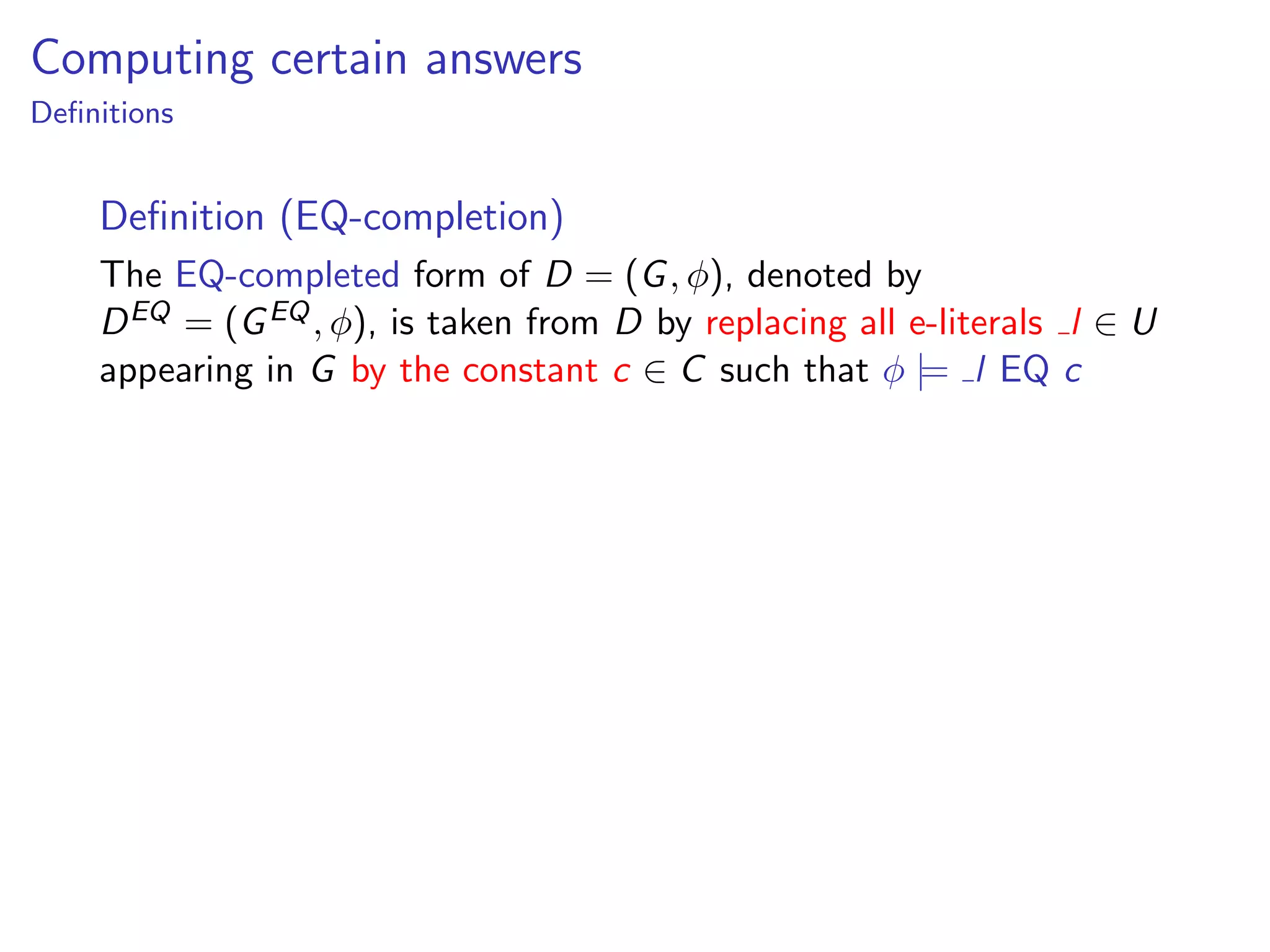The document discusses the challenges of incomplete information in RDF (Resource Description Framework) and introduces the RDFi framework, which extends RDF to better handle such data through constraints. It reviews previous work related to incomplete data representation and outlines the RDFi syntax and semantics for capturing partial knowledge. The authors propose methodologies for SPARQL query evaluation over RDFi databases and highlight the significance of their work for various applications in knowledge representation and the semantic web.
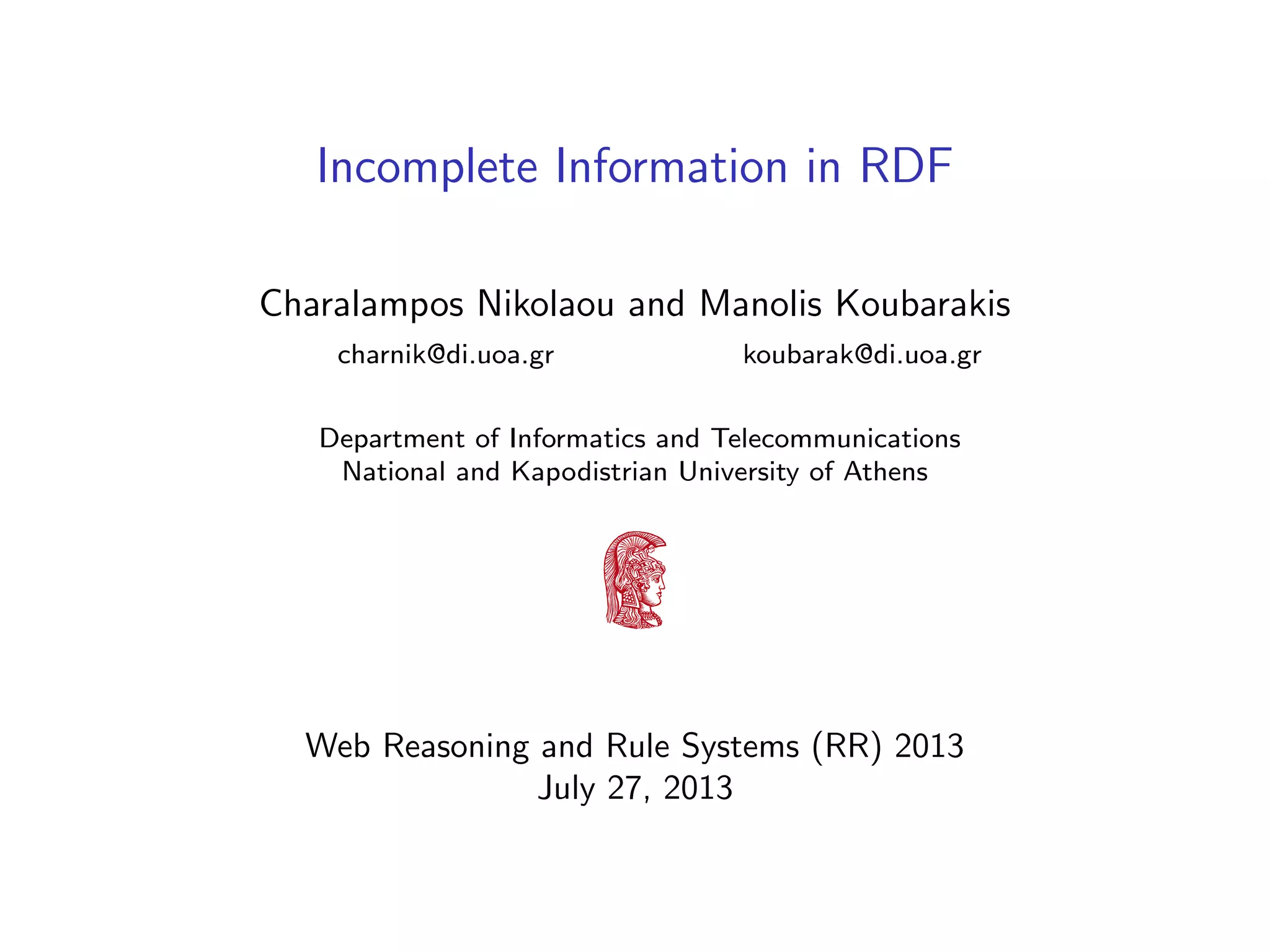


![Previous work
Relational
Relations extended to tables with various models of
incompleteness [Imielinski/Lipski ’84]
Complexity results for the associated decision problems
[Abiteboul/Kanellakis/Grahne ’91]
Dependencies and updates [Grahne ’91]
C. Nikolaou and M. Koubarakis
–
Incomplete Information in RDF
4/36](https://image.slidesharecdn.com/rr2013-presentation-131020155616-phpapp01/75/Incomplete-Information-in-RDF-4-2048.jpg)
![Previous work
Relational
Relations extended to tables with various models of
incompleteness [Imielinski/Lipski ’84]
Complexity results for the associated decision problems
[Abiteboul/Kanellakis/Grahne ’91]
Dependencies and updates [Grahne ’91]
XML
Dynamic enrichment of incomplete information
[Abiteboul/Segoufin/Vianu ’01,’06]
General models of incompleteness, query answering, and
computational complexity [Barcel´/Libkin/Poggi/Sirangelo
o
’09,’10]
C. Nikolaou and M. Koubarakis
–
Incomplete Information in RDF
4/36](https://image.slidesharecdn.com/rr2013-presentation-131020155616-phpapp01/75/Incomplete-Information-in-RDF-5-2048.jpg)
![Previous work (cont’d)
RDF
Blank nodes as existential variables in the RDF standard
SPARQL query evaluation under certain answer semantics
(Open World Assumption) [Arenas/P´rez ’11]
e
Anonymous timestamps in general temporal RDF graphs
[Gutierrez/Hurtado/Vaisman ’05]
General temporal RDF graphs with temporal constraints
[Hurtado/Vaisman ’06]
C. Nikolaou and M. Koubarakis
–
Incomplete Information in RDF
5/36](https://image.slidesharecdn.com/rr2013-presentation-131020155616-phpapp01/75/Incomplete-Information-in-RDF-6-2048.jpg)
![Previous work (cont’d)
RDF
Blank nodes as existential variables in the RDF standard
SPARQL query evaluation under certain answer semantics
(Open World Assumption) [Arenas/P´rez ’11]
e
Anonymous timestamps in general temporal RDF graphs
[Gutierrez/Hurtado/Vaisman ’05]
General temporal RDF graphs with temporal constraints
[Hurtado/Vaisman ’06]
RDFi : It captures incomplete information for property values
using constraints. It is for RDF what the c-tables model is for the
relational model.
C. Nikolaou and M. Koubarakis
–
Incomplete Information in RDF
5/36](https://image.slidesharecdn.com/rr2013-presentation-131020155616-phpapp01/75/Incomplete-Information-in-RDF-7-2048.jpg)
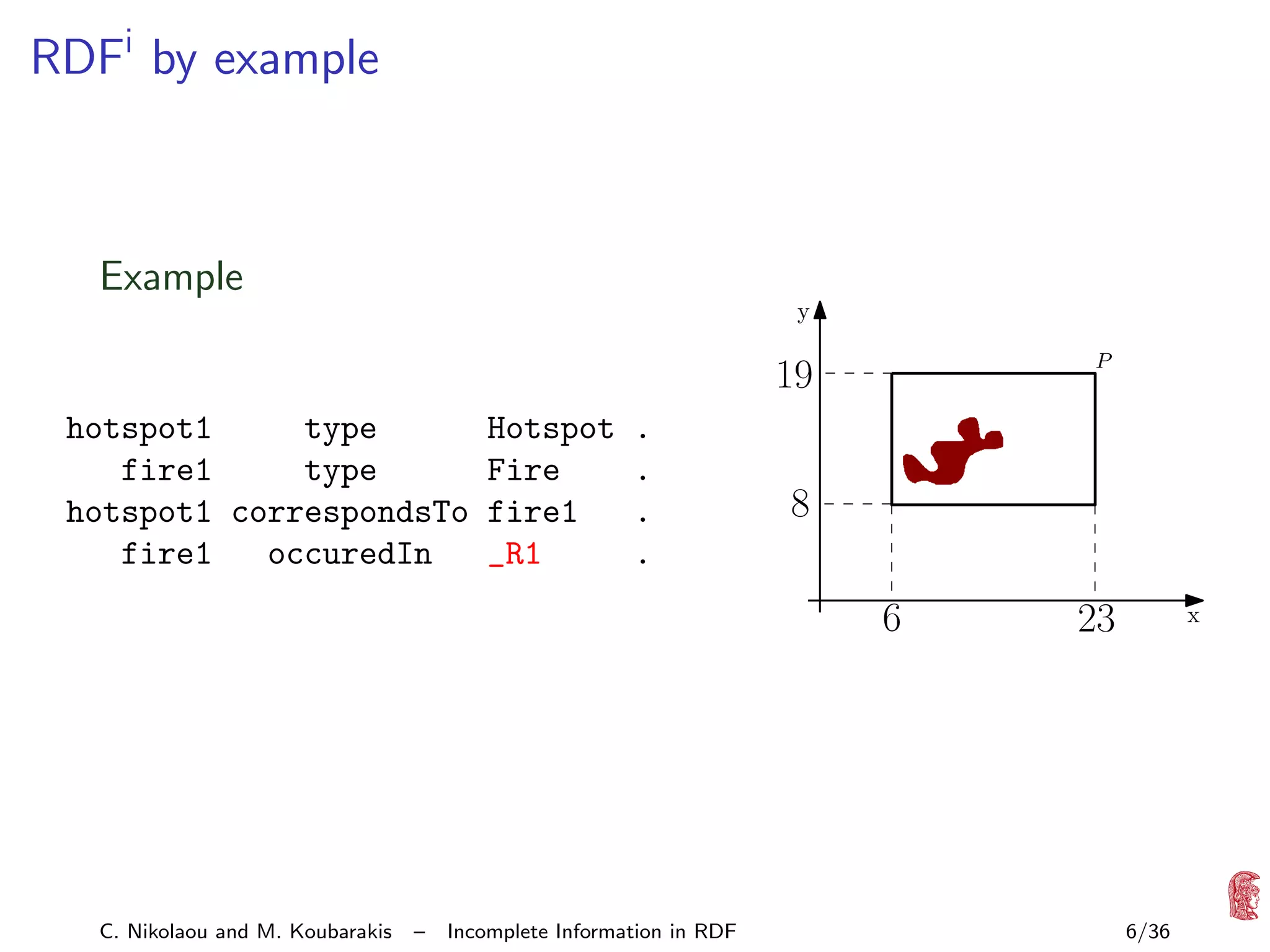
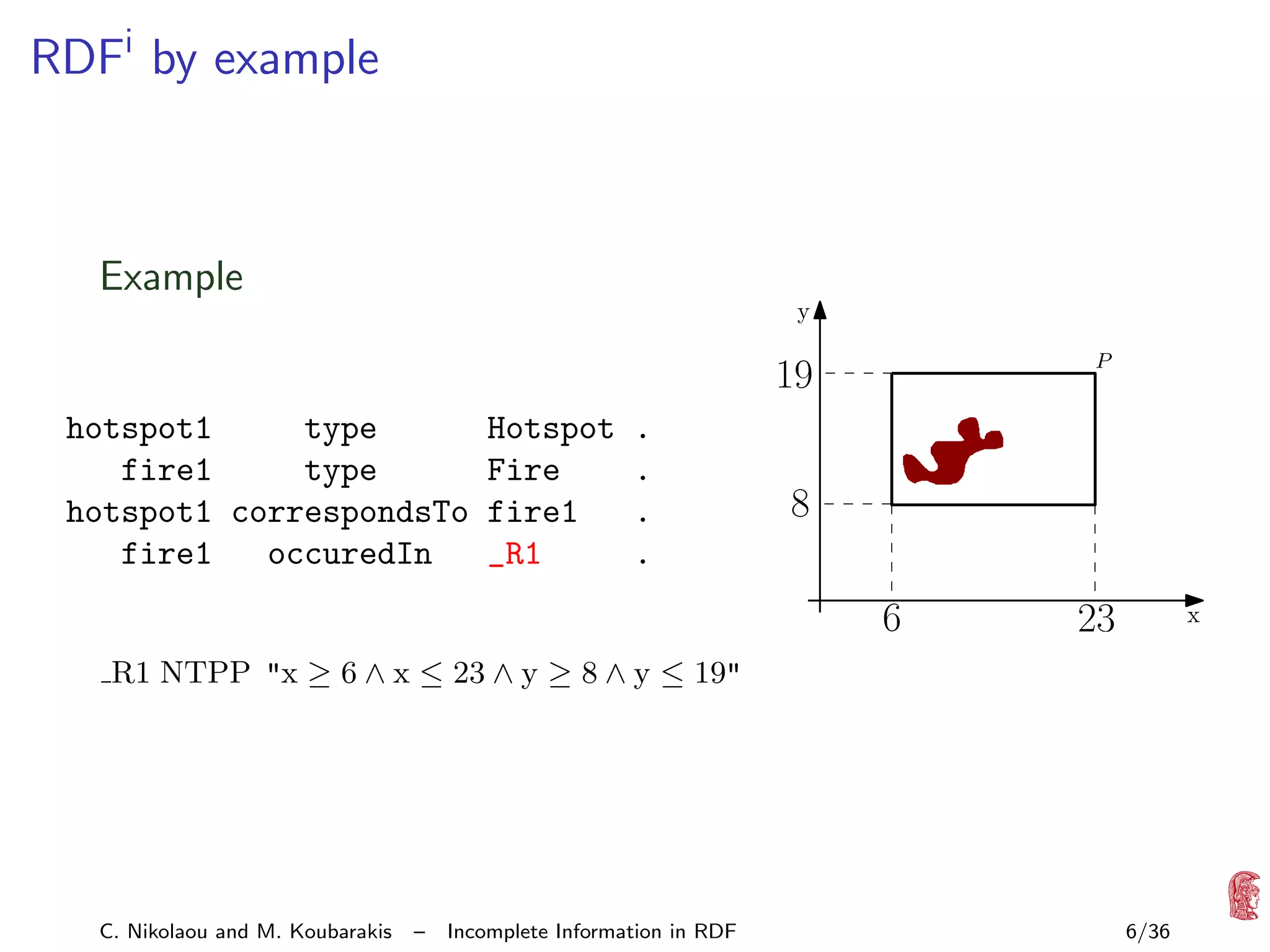
![RDFi in a nutshell
Extension of RDF for capturing incomplete information for
property values that exist but are unknown or partially known
Partial knowledge captured by constraints using an appropriate
constraint language L interpreted over a fixed structure ML
Syntax
RDF graphs extended to RDFi databases: pair (G , φ)
G : RDF graph with a new kind of literals, called e-literals
φ: quantifier-free formula of L
Semantics
Possible world semantics as in [Imielinski/Lipski ’84] and
[Grahne ’91]
C. Nikolaou and M. Koubarakis
–
Incomplete Information in RDF
7/36](https://image.slidesharecdn.com/rr2013-presentation-131020155616-phpapp01/75/Incomplete-Information-in-RDF-10-2048.jpg)
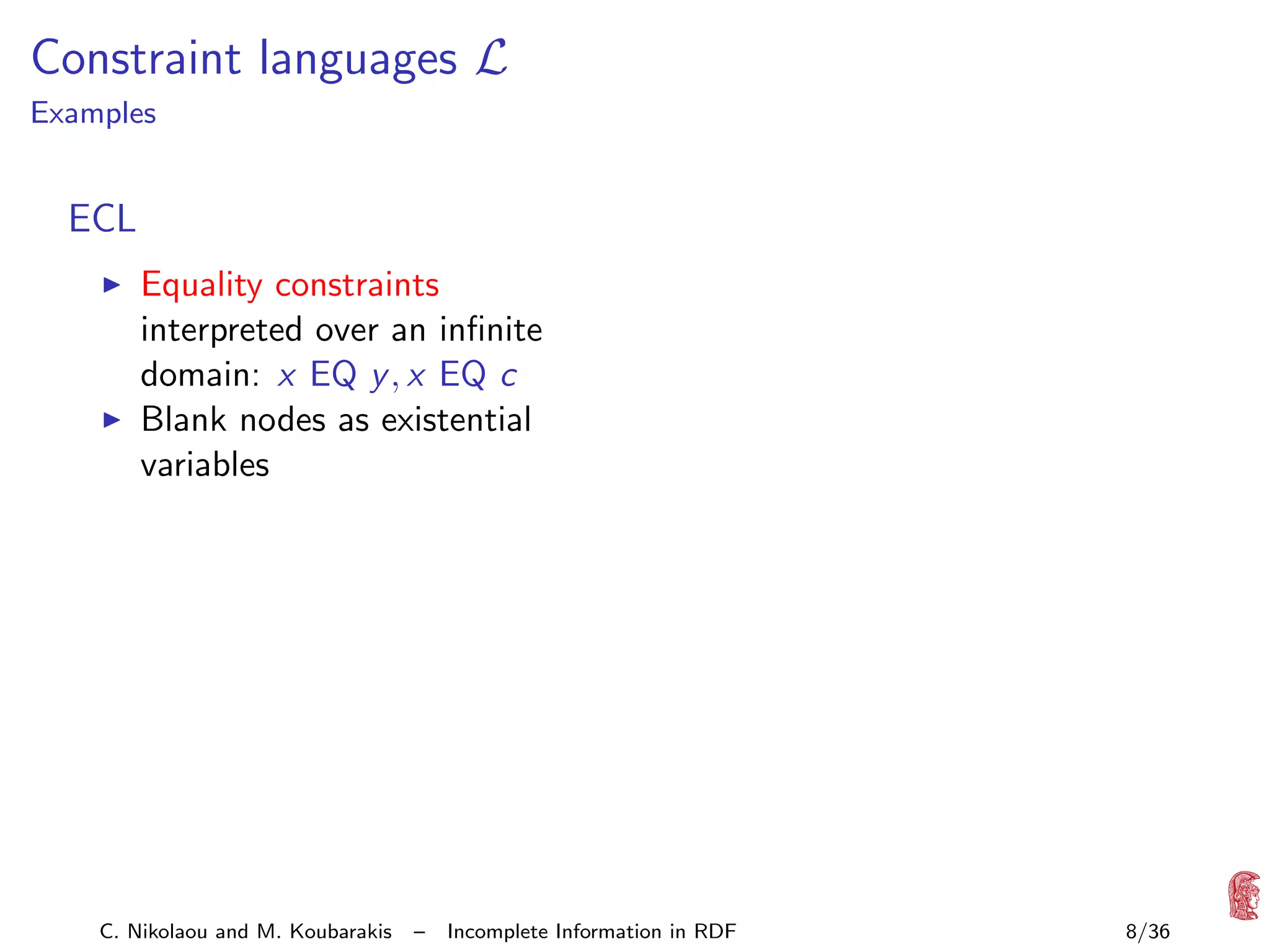
![Constraint languages L
Examples
diPCL/dePCL
ECL
Equality constraints
interpreted over an infinite
domain: x EQ y , x EQ c
Blank nodes as existential
variables
C. Nikolaou and M. Koubarakis
–
Difference constraints of the
form x − y ≤ c interpreted over
the integers or rationals
Incomplete temporal
information [Koubarakis ’94]
Incomplete Information in RDF
8/36](https://image.slidesharecdn.com/rr2013-presentation-131020155616-phpapp01/75/Incomplete-Information-in-RDF-12-2048.jpg)
![Constraint languages L
Examples
diPCL/dePCL
ECL
Equality constraints
interpreted over an infinite
domain: x EQ y , x EQ c
Blank nodes as existential
variables
Difference constraints of the
form x − y ≤ c interpreted over
the integers or rationals
Incomplete temporal
information [Koubarakis ’94]
TCL
Topological constraints of
non-empty, regular closed
subsets of topological space
Six binary predicates:
DC, EC, PO, EQ, TPP, NTPP
C. Nikolaou and M. Koubarakis
–
x DC y
y
x
Incomplete Information in RDF
x EQ y
x
y
x EC y
y
x
x TPP y
y
x
x PO y
y
x
x NTPP y
y
x
8/36](https://image.slidesharecdn.com/rr2013-presentation-131020155616-phpapp01/75/Incomplete-Information-in-RDF-13-2048.jpg)
![Constraint languages L
Examples
diPCL/dePCL
ECL
Equality constraints
interpreted over an infinite
domain: x EQ y , x EQ c
Blank nodes as existential
variables
TCL
Difference constraints of the
form x − y ≤ c interpreted over
the integers or rationals
Incomplete temporal
information [Koubarakis ’94]
PCL
Topological constraints of
non-empty, regular closed
subsets of topological space
Six binary predicates:
DC, EC, PO, EQ, TPP, NTPP
C. Nikolaou and M. Koubarakis
–
TCL plus constant symbols
representing polygons in Q2
e.g.,
r NTPP "x − y ≥ 0 ∧ x ≤ 1 ∧ y ≥ 0"
Incomplete Information in RDF
8/36](https://image.slidesharecdn.com/rr2013-presentation-131020155616-phpapp01/75/Incomplete-Information-in-RDF-14-2048.jpg)
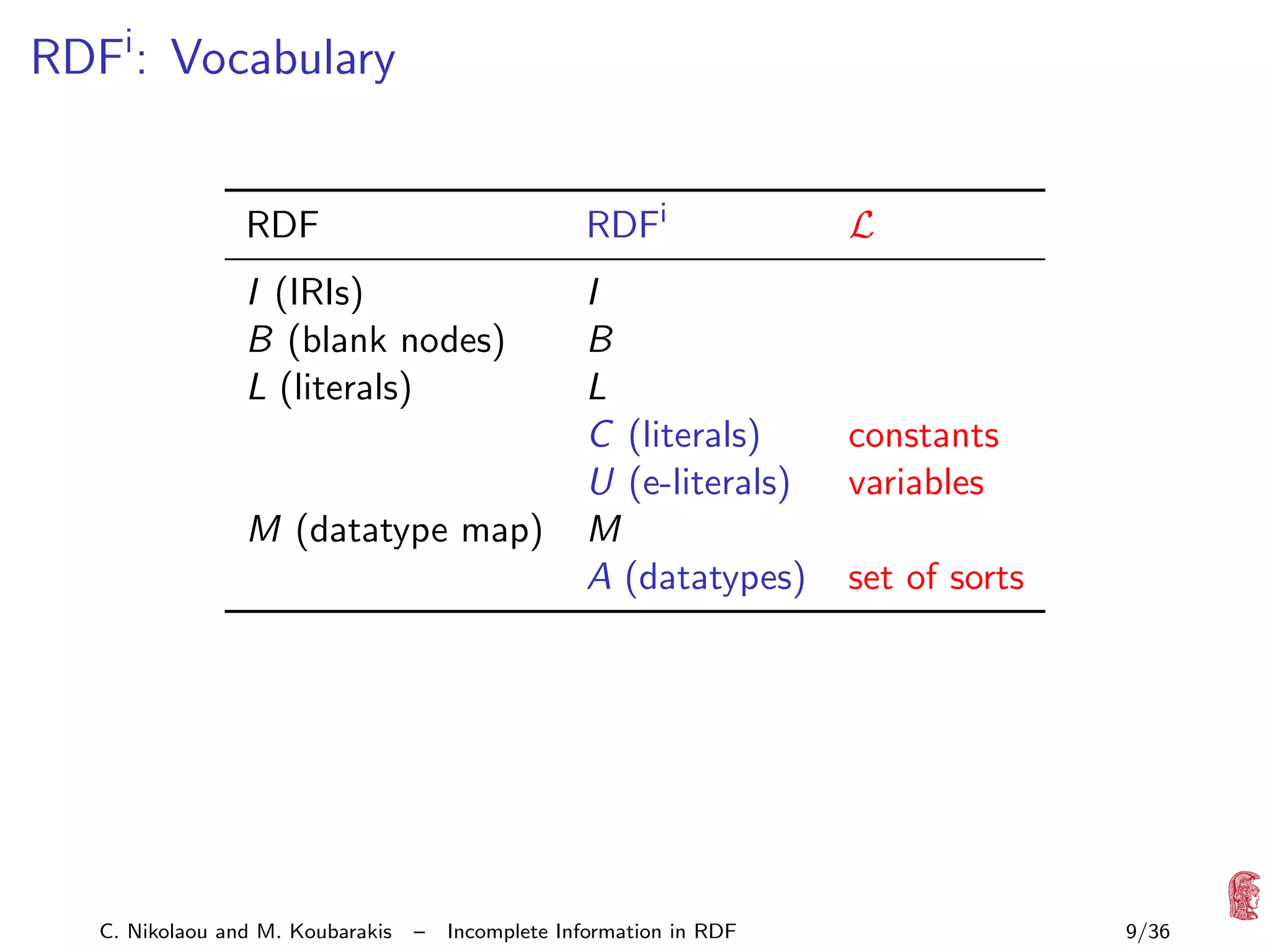
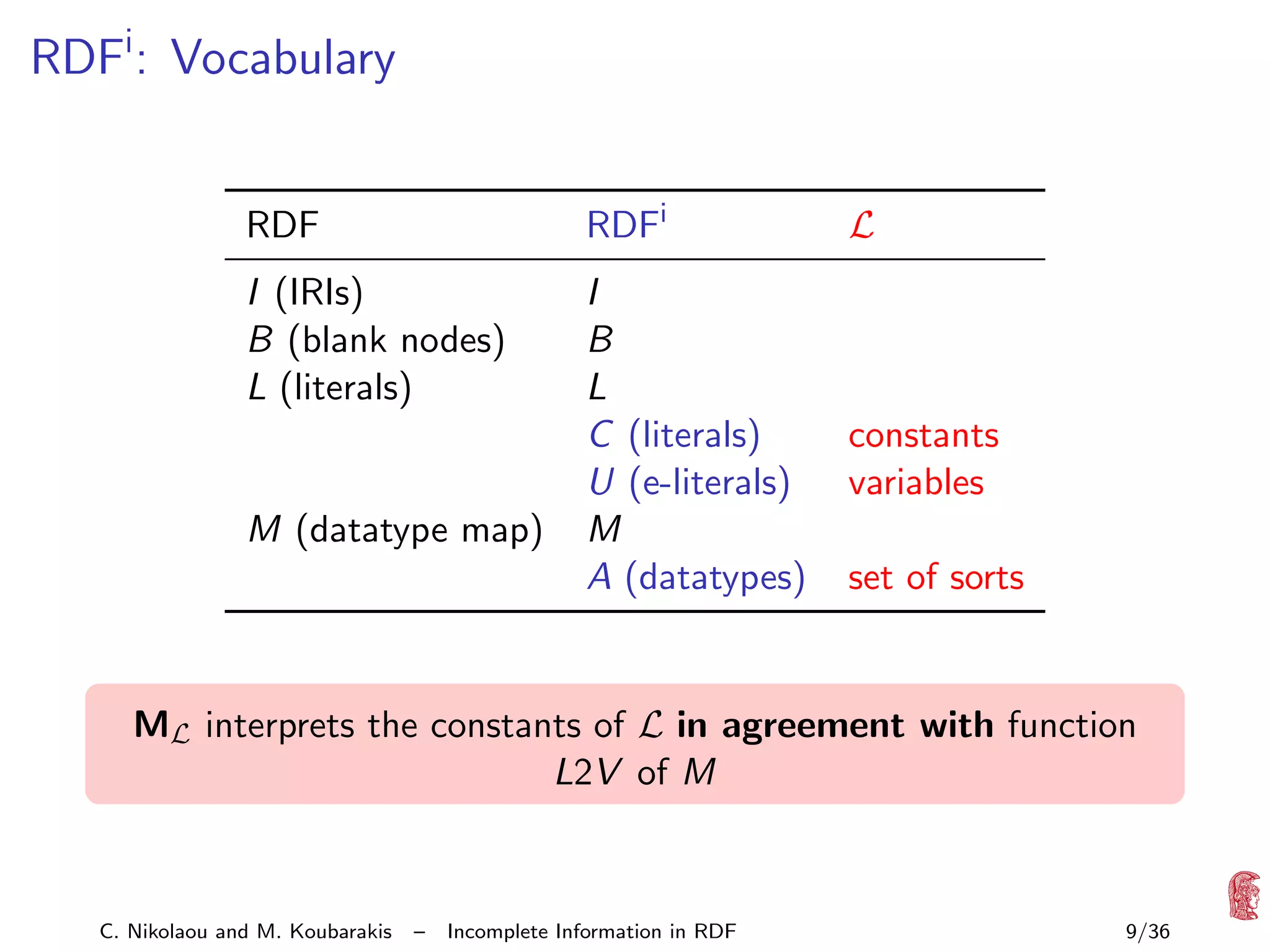
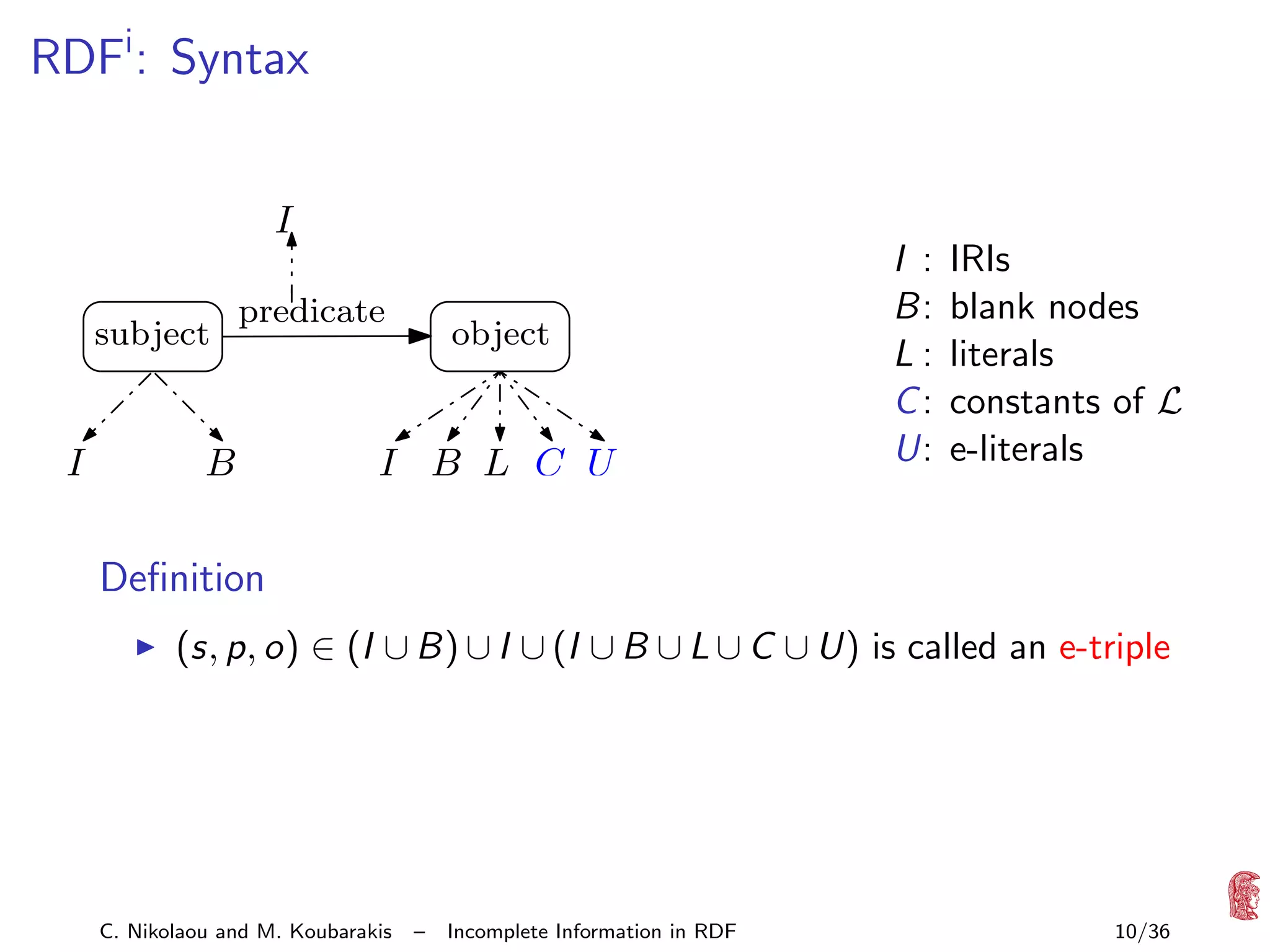
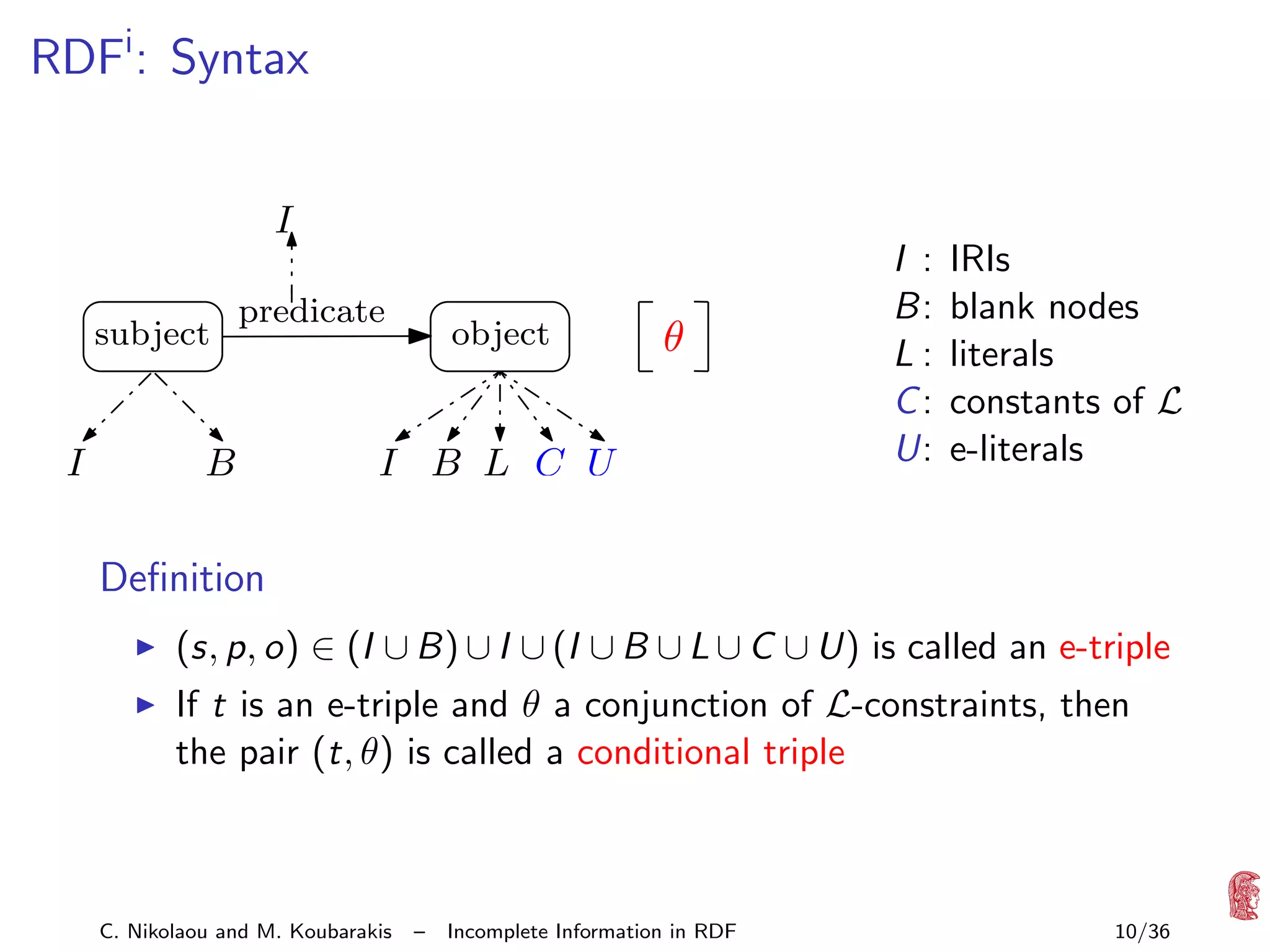
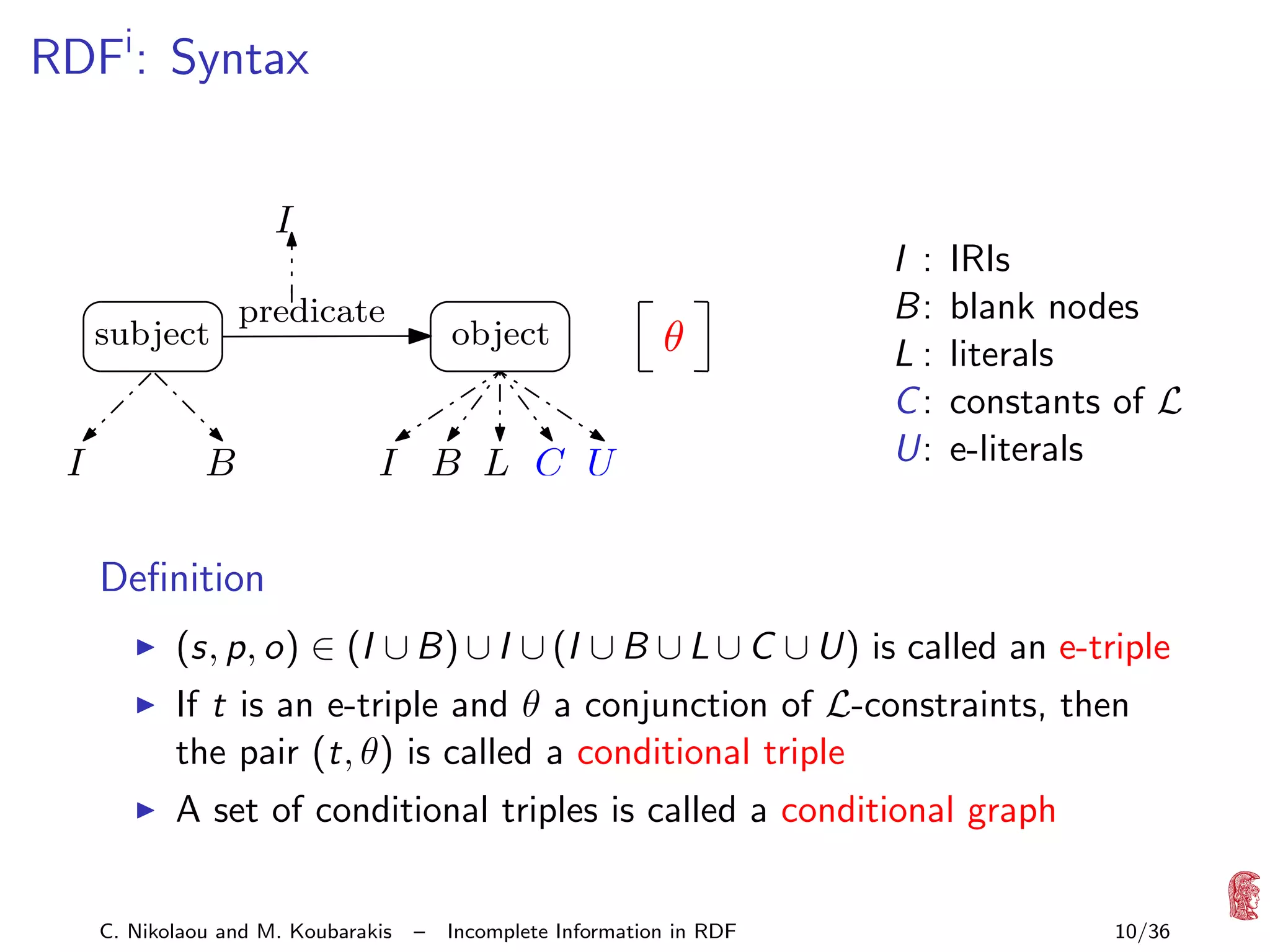
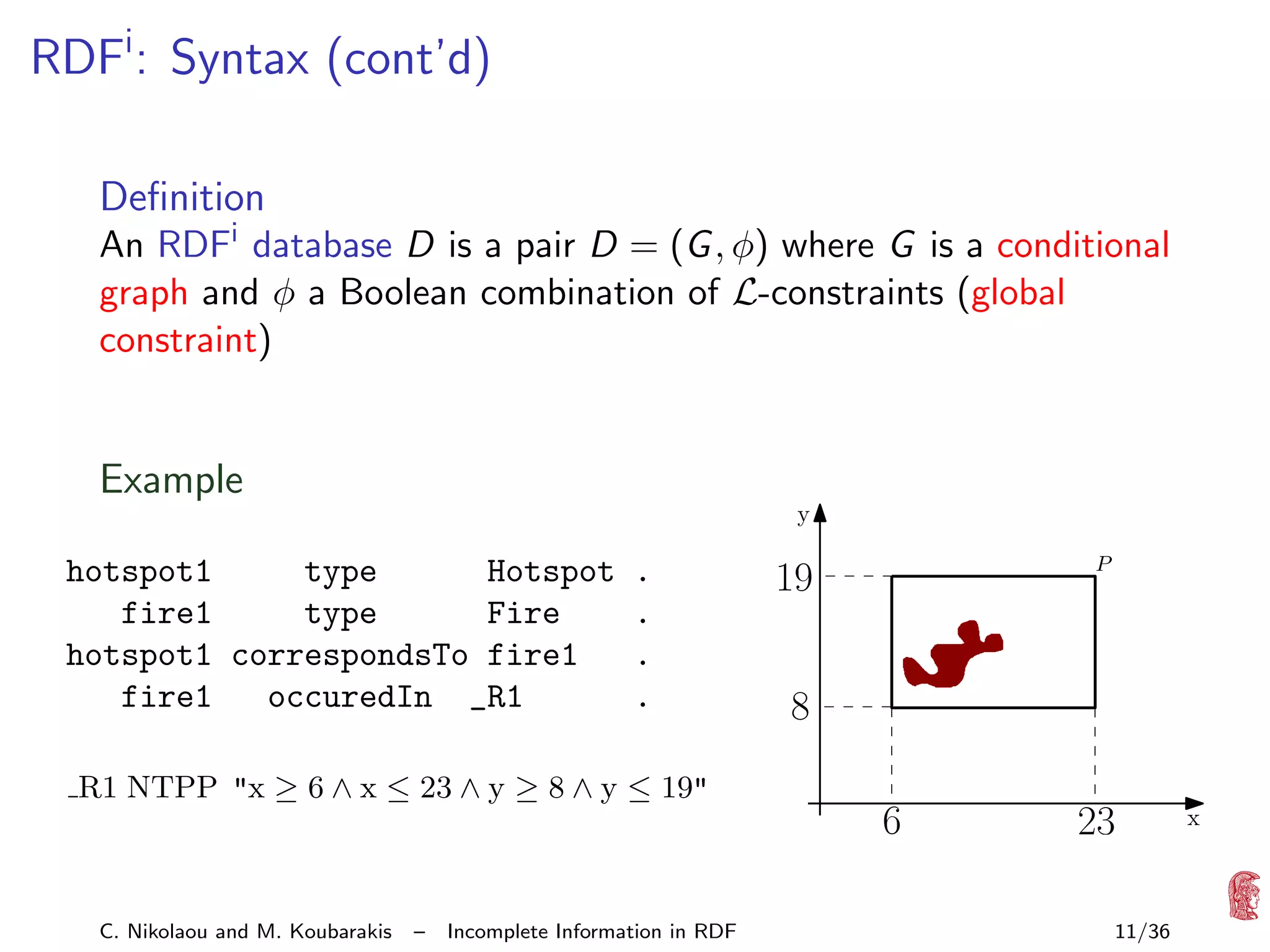
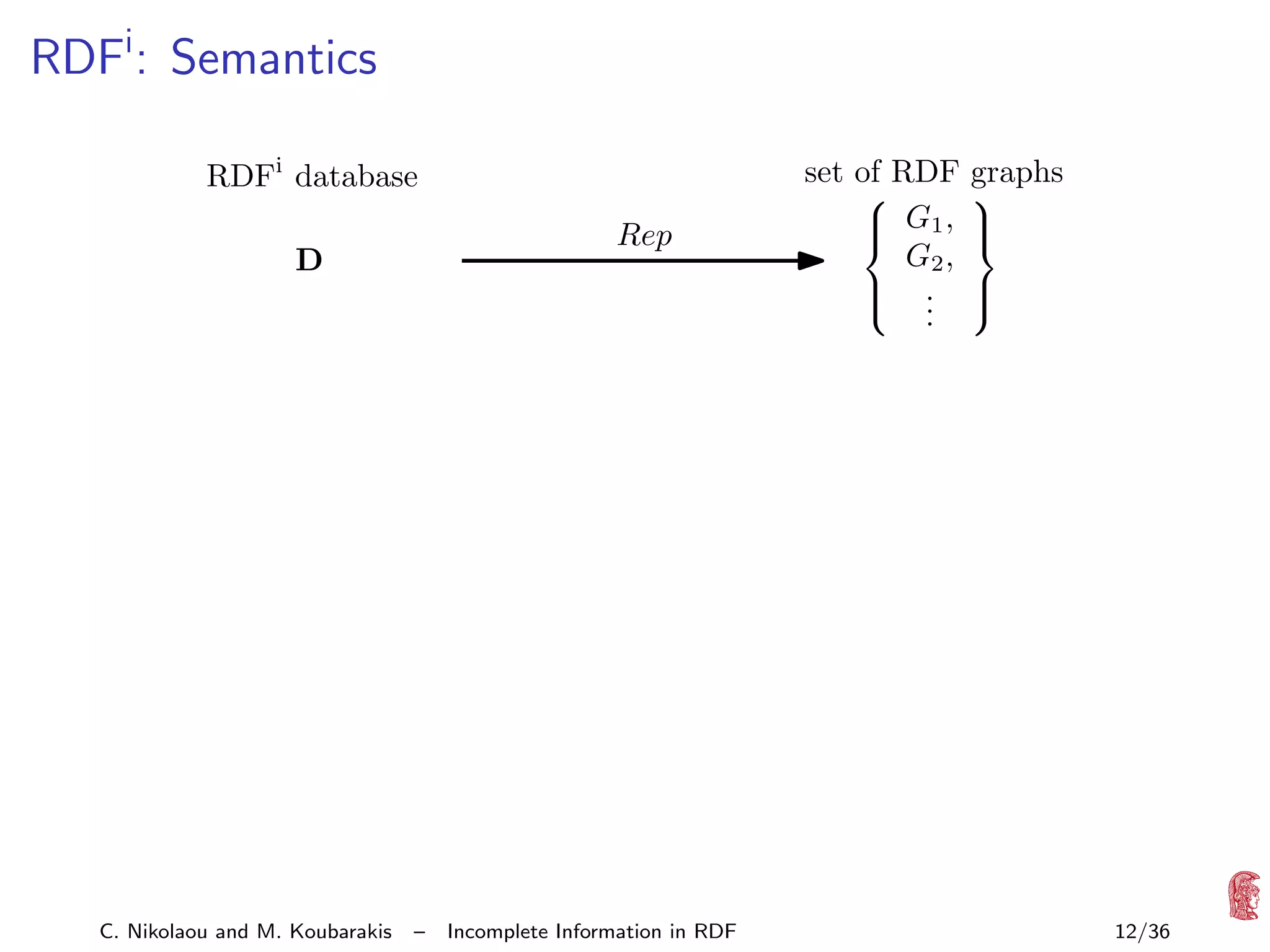

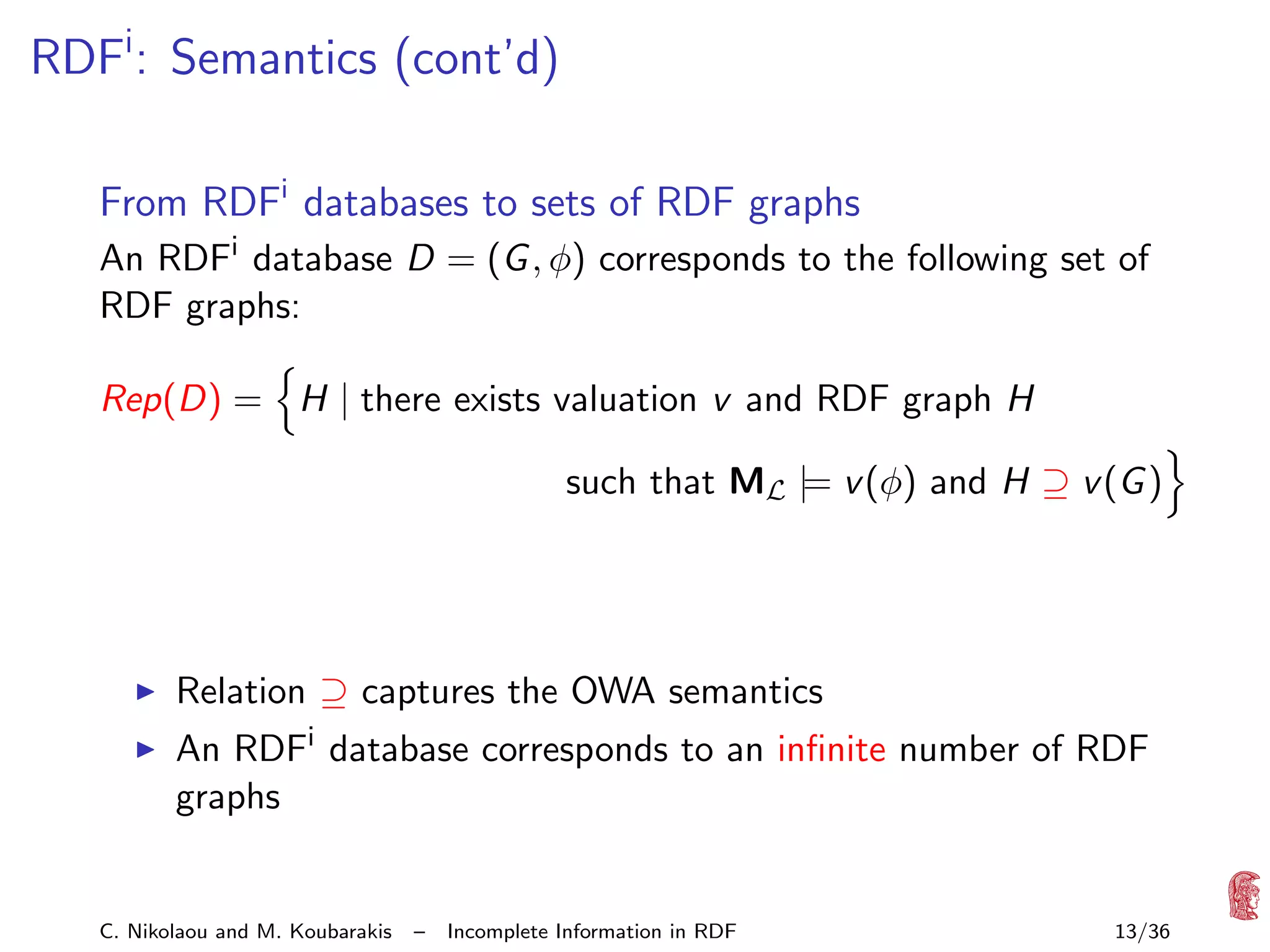

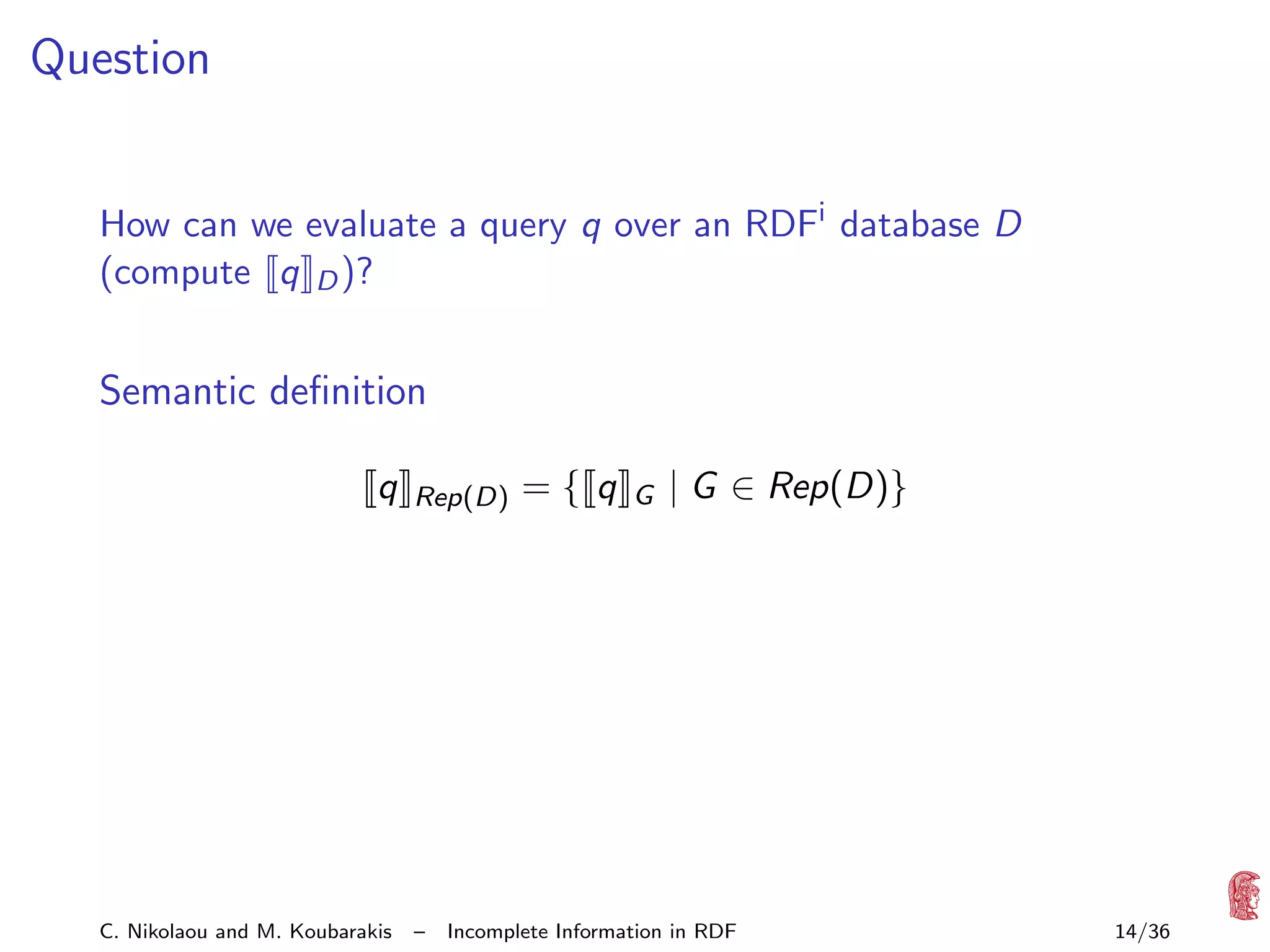
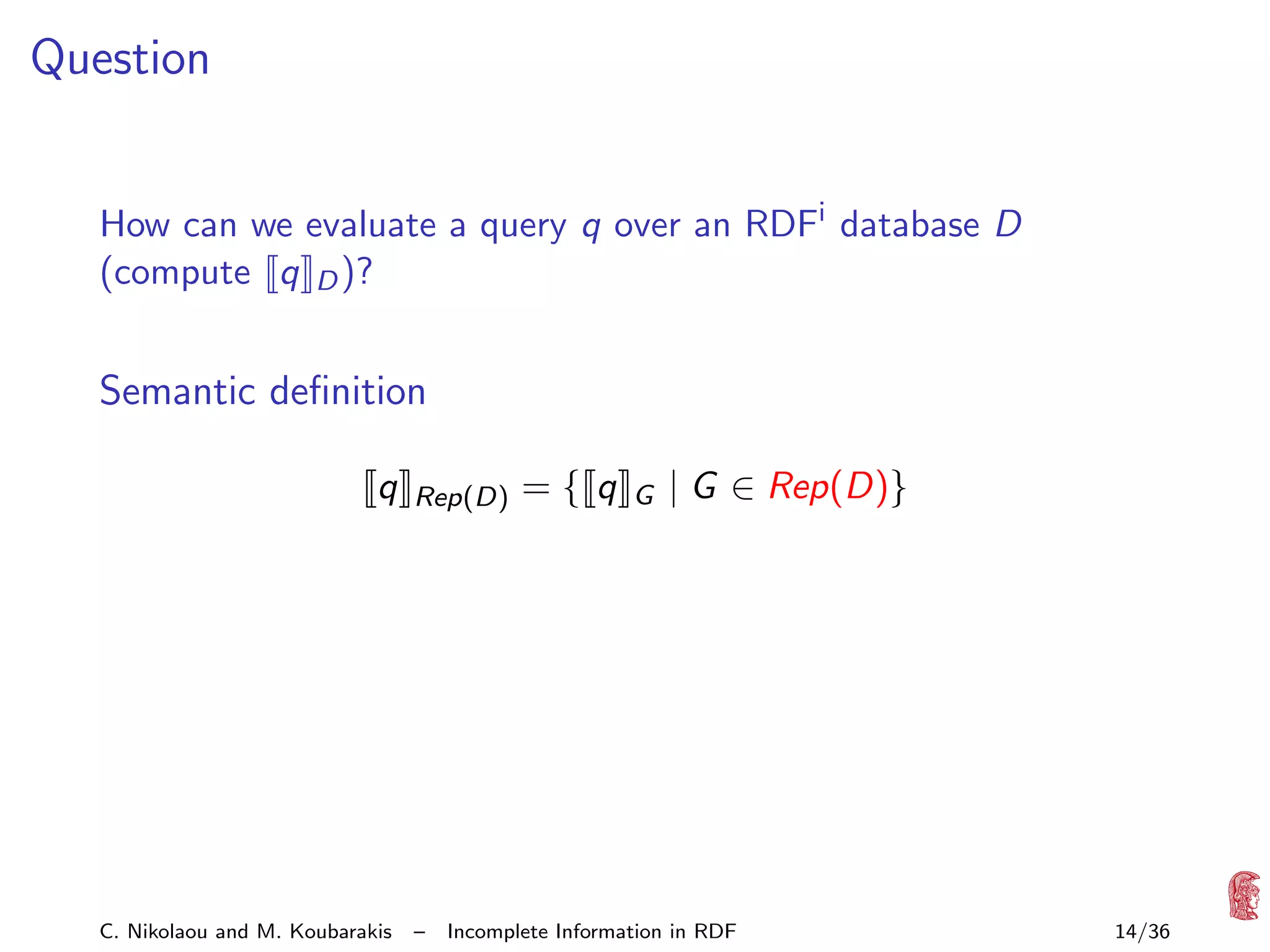
![Question
How can we evaluate a query q over an RDFi database D
(compute q D )?
Semantic definition
q
Rep(D)
={ q
G
| G ∈ Rep(D)}
In practice?
Start with SPARQL algebra of [P´rez/Arenas/Gutierrez ’06]
e
with set semantics
Define SPARQL query evaluation for RDFi databases
C. Nikolaou and M. Koubarakis
–
Incomplete Information in RDF
14/36](https://image.slidesharecdn.com/rr2013-presentation-131020155616-phpapp01/75/Incomplete-Information-in-RDF-27-2048.jpg)
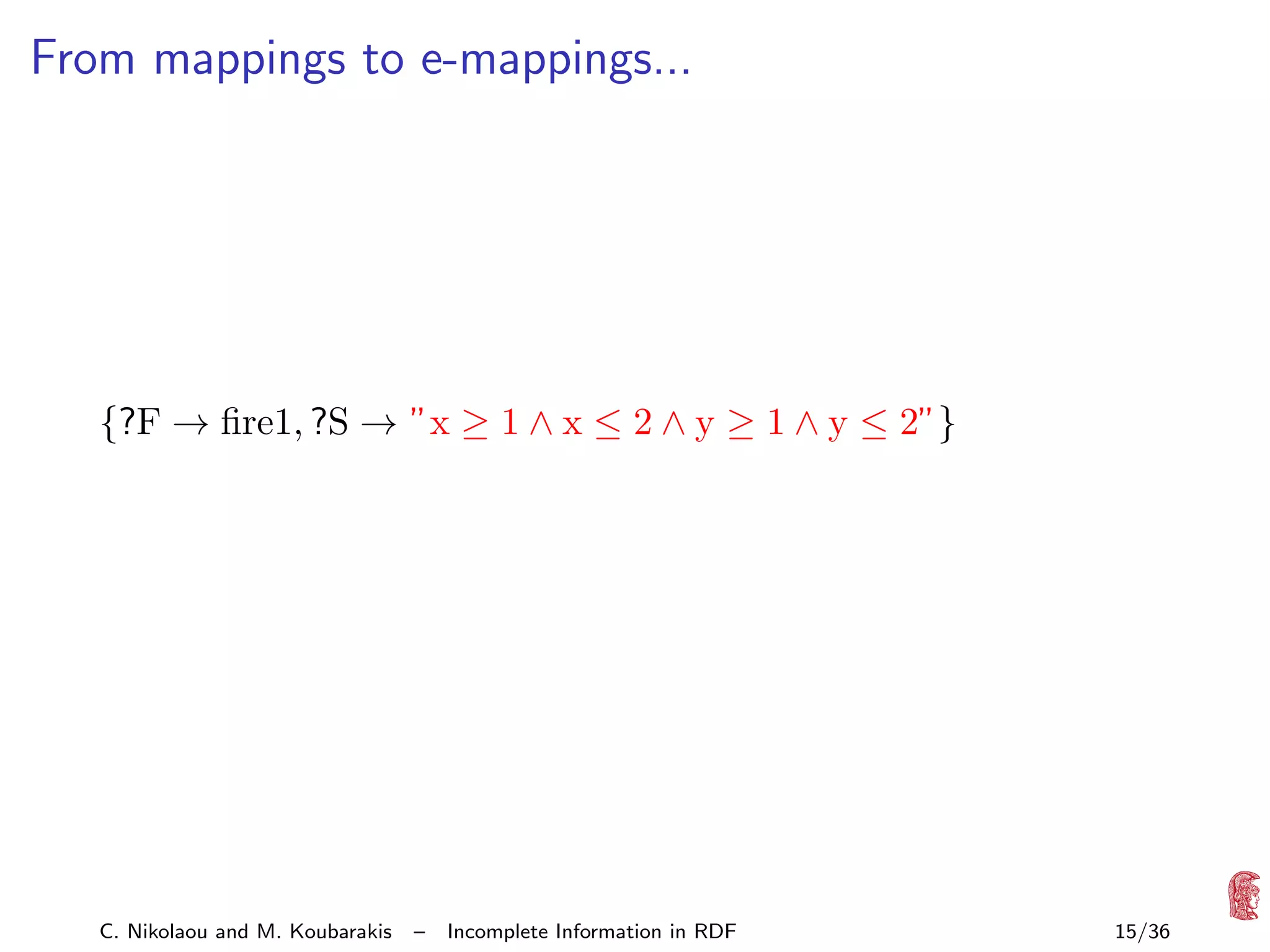
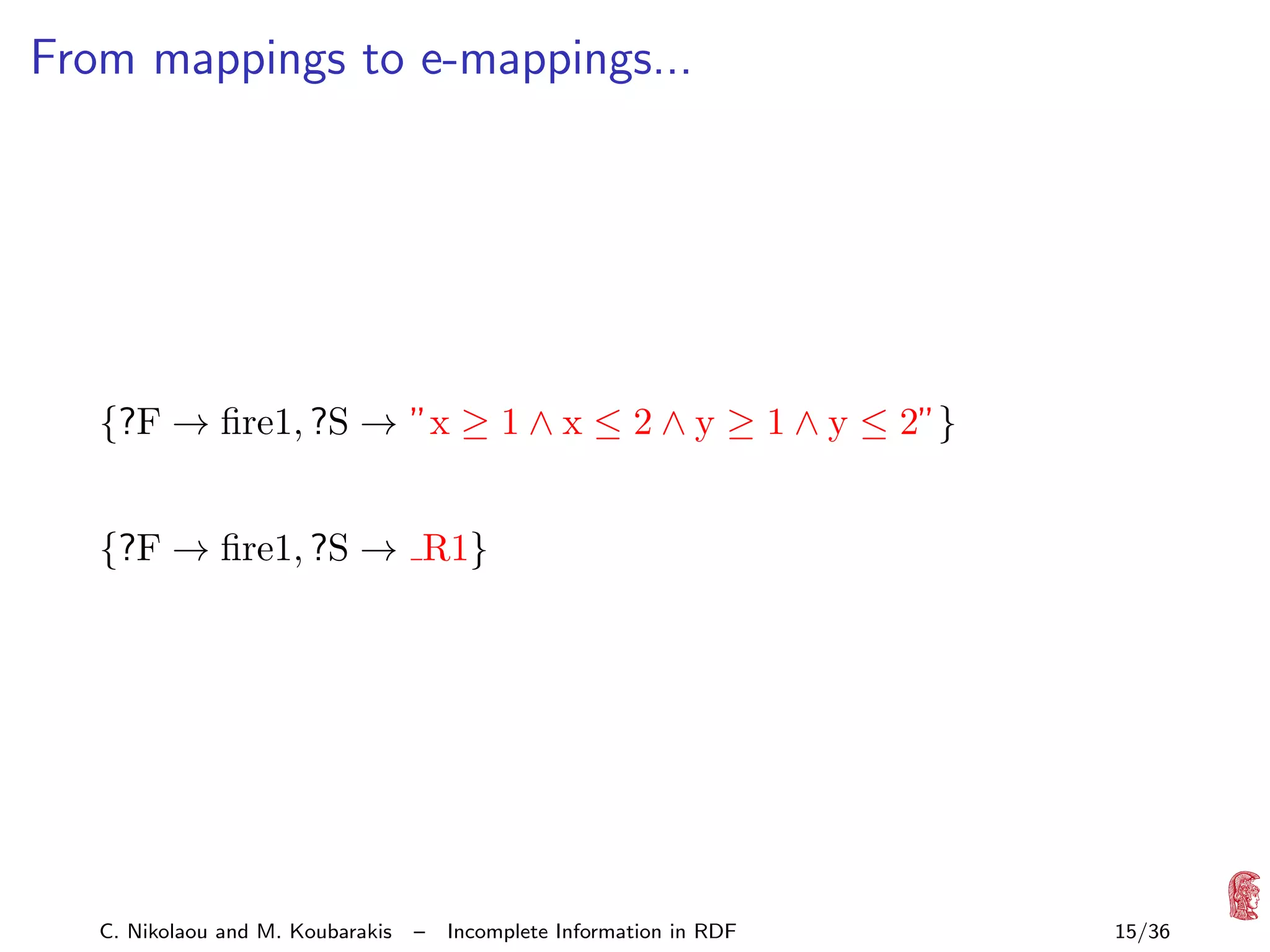
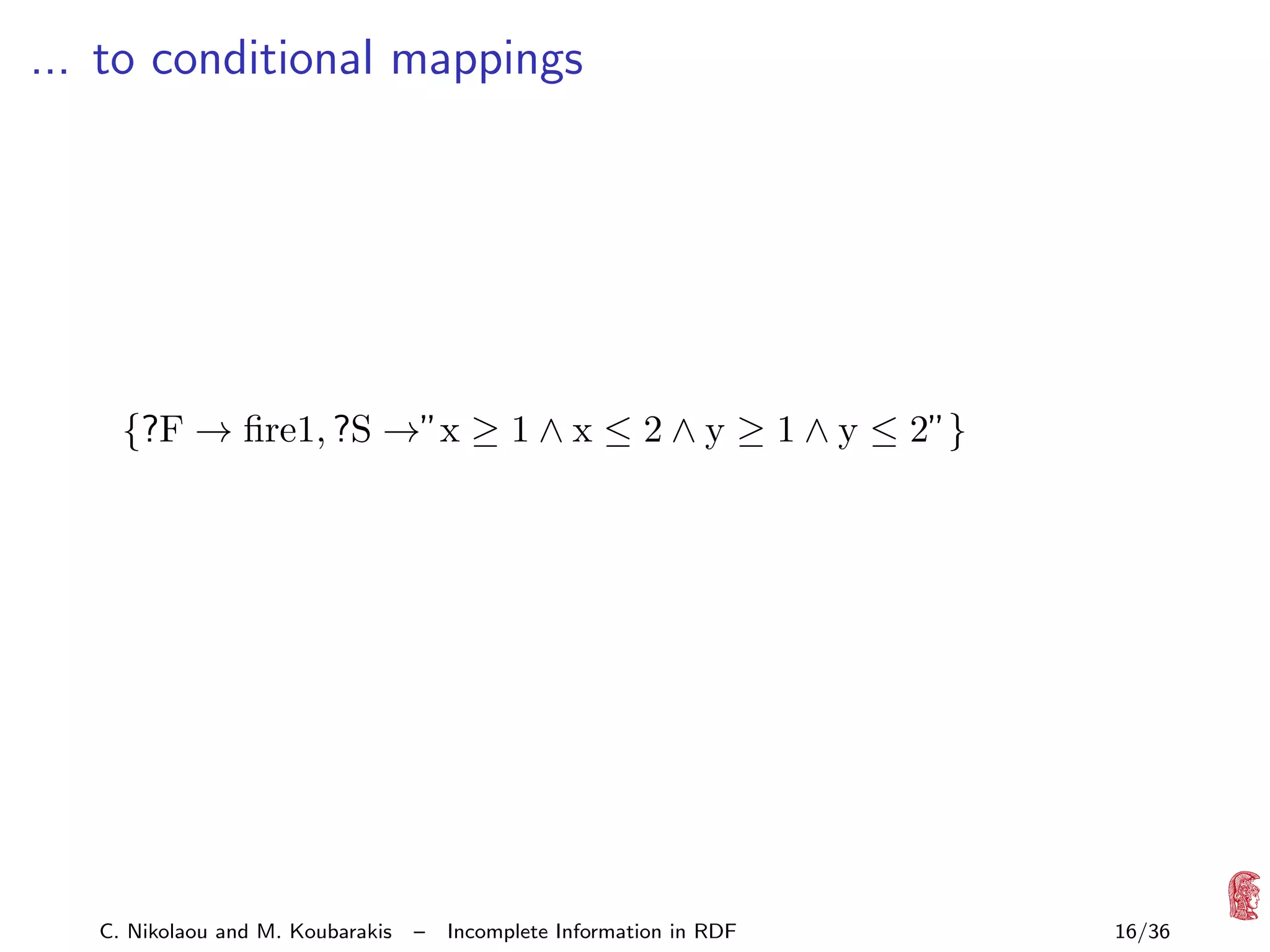

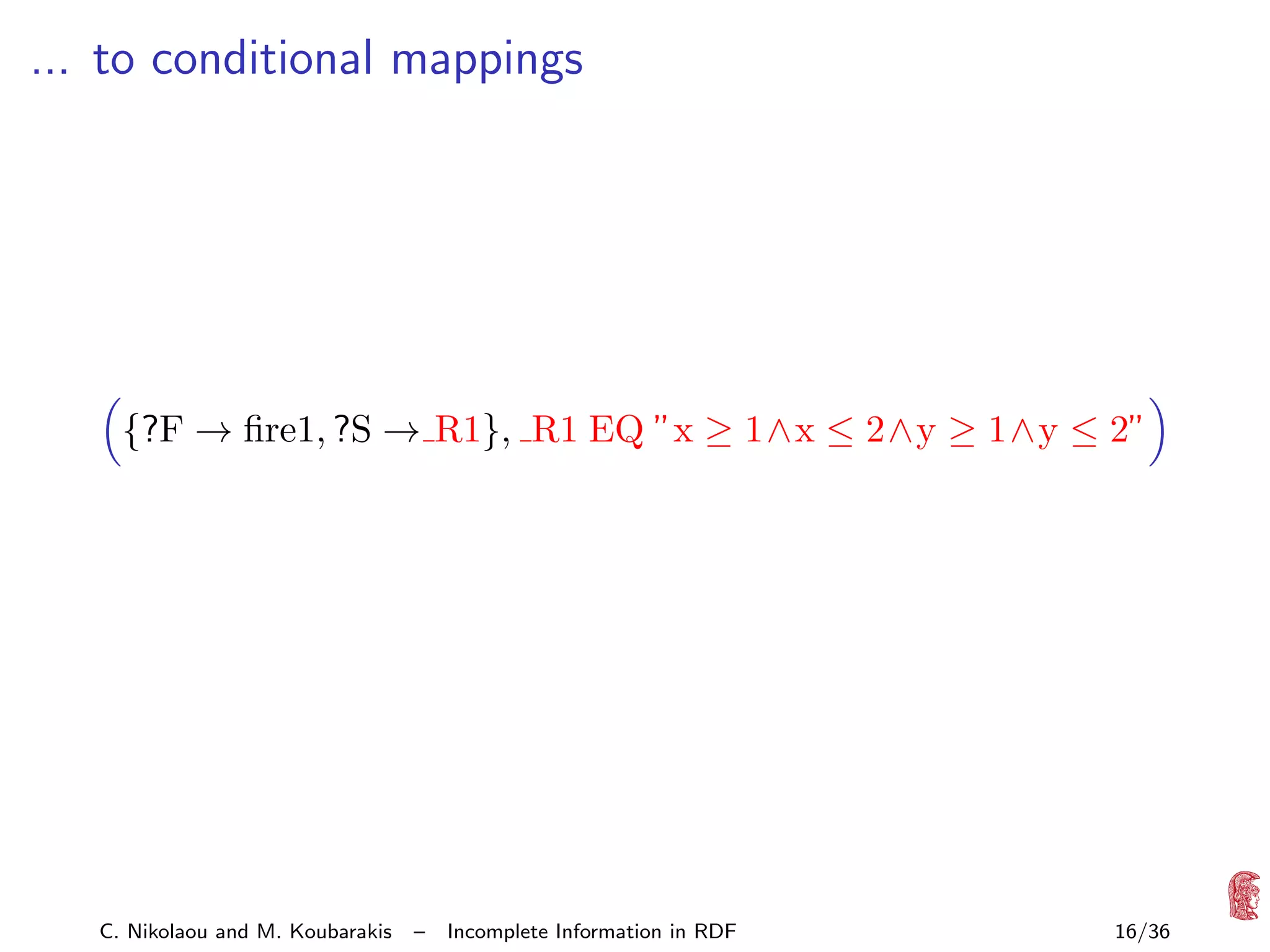
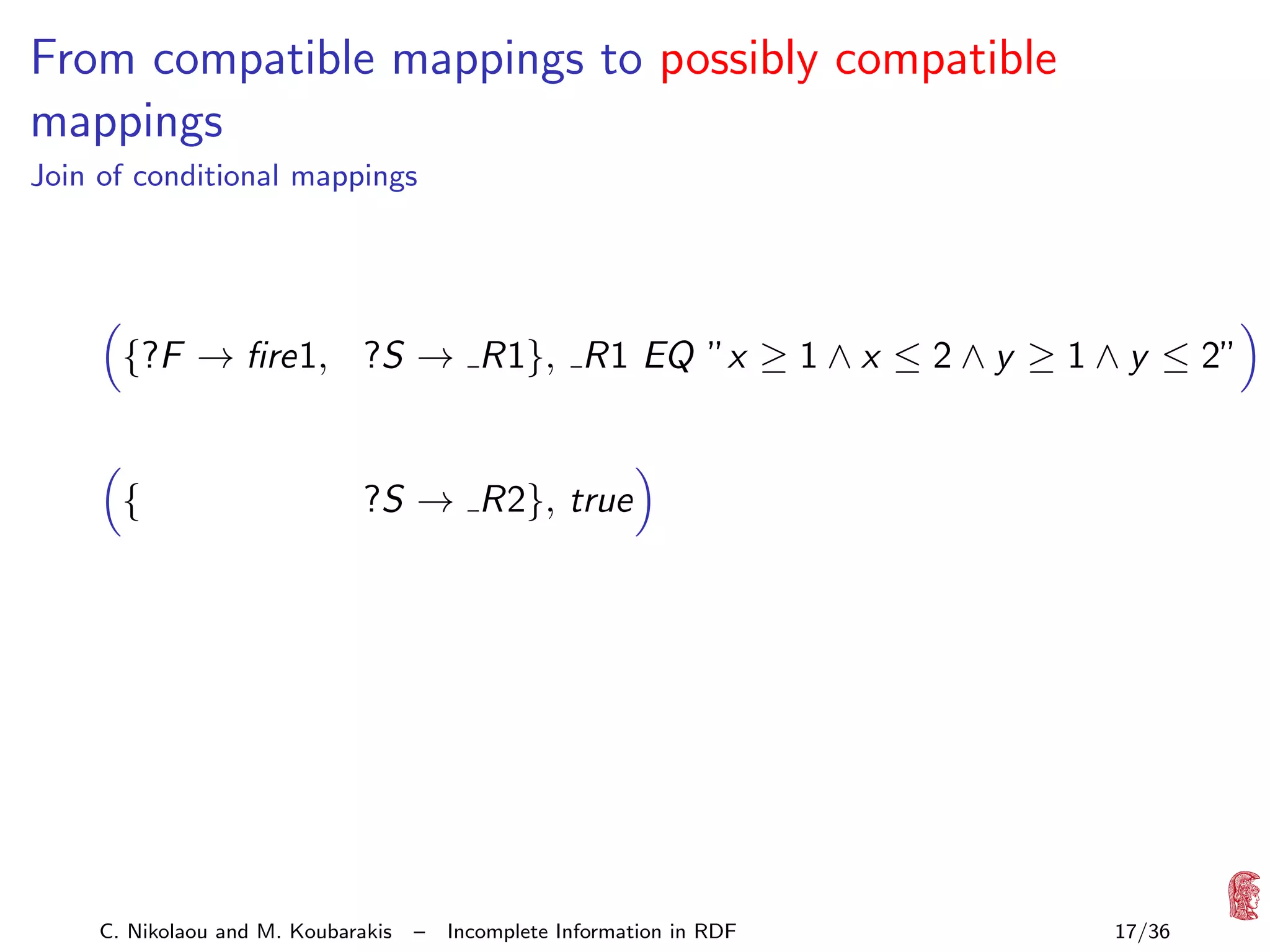
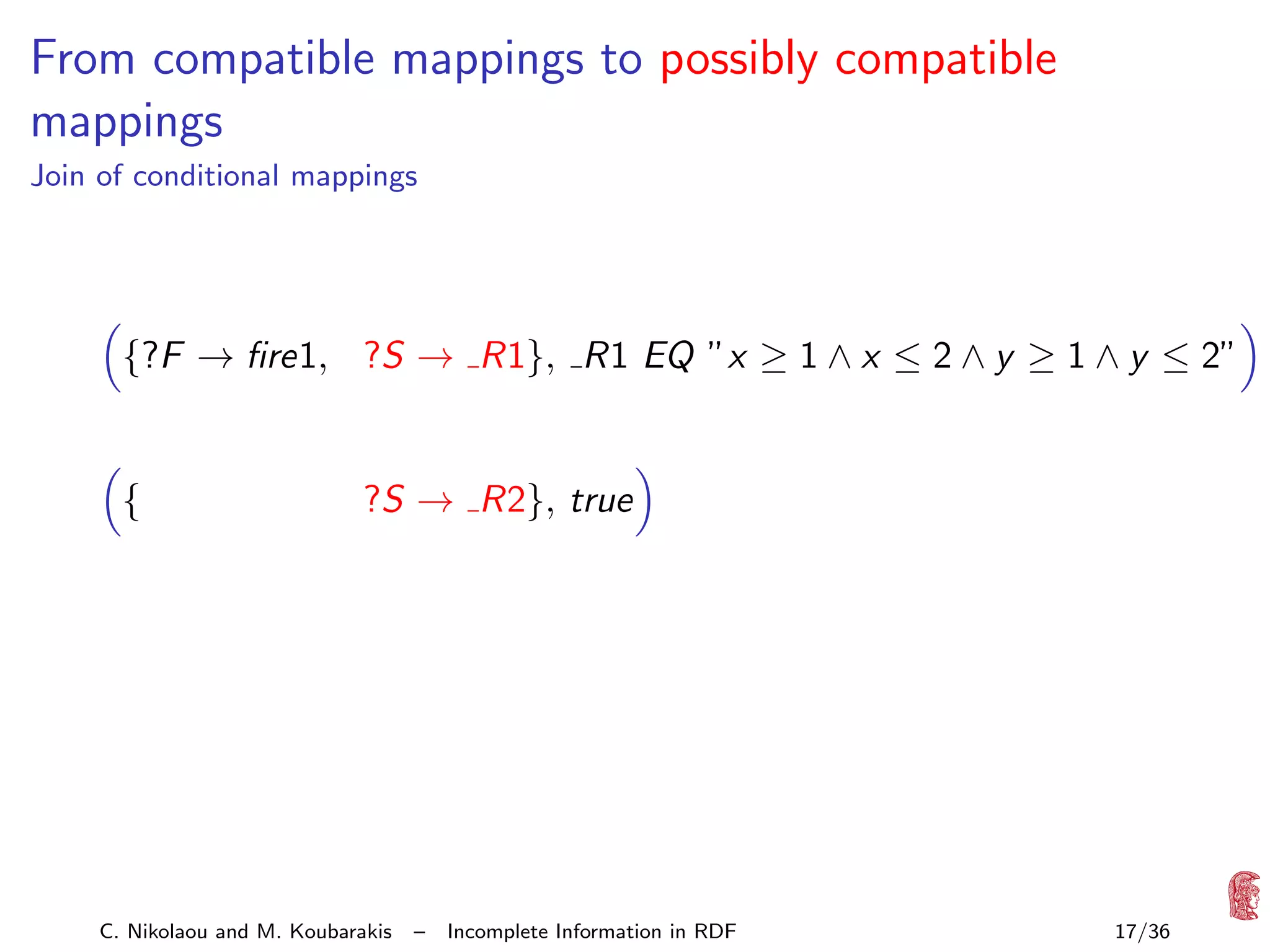
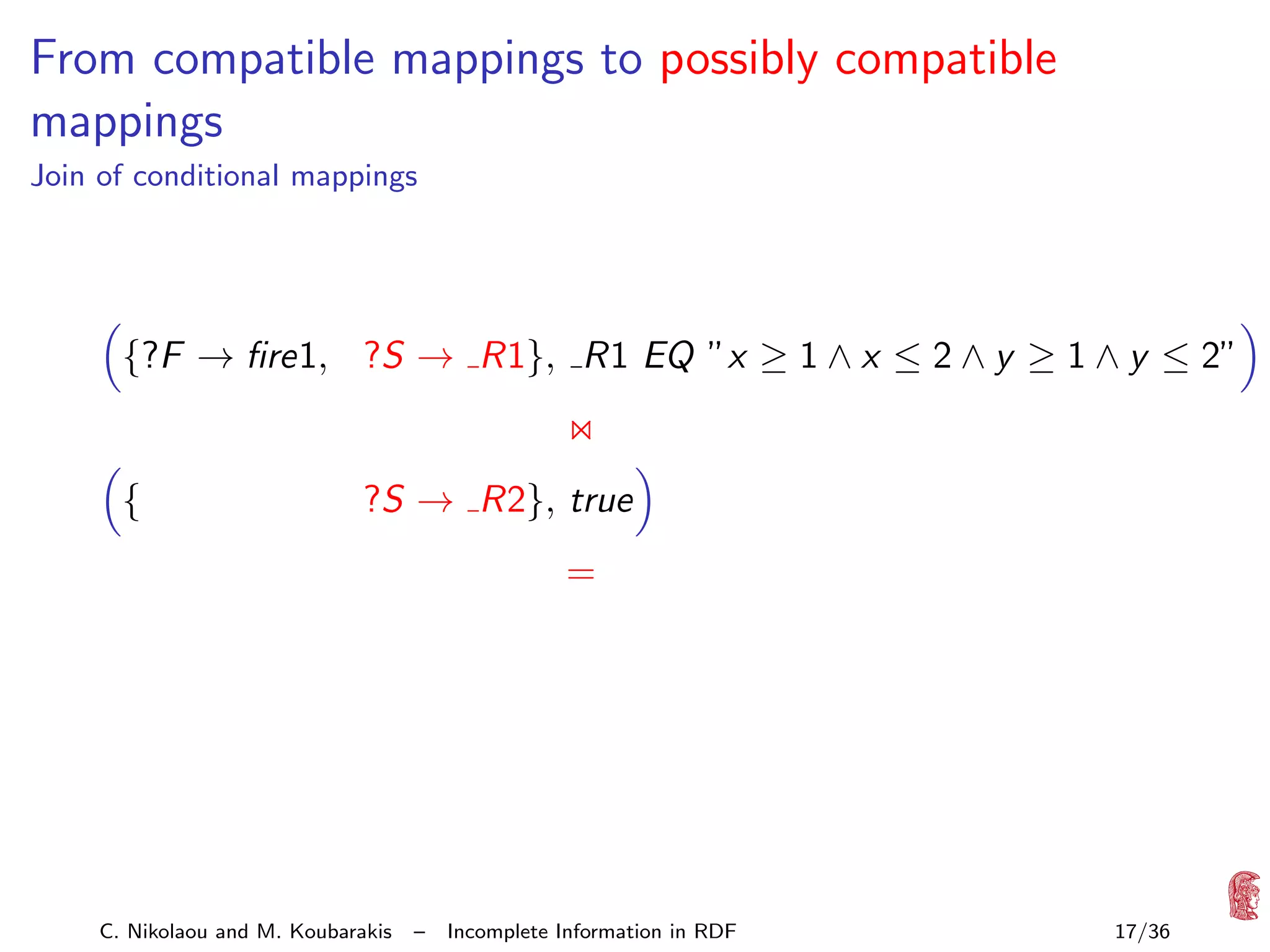
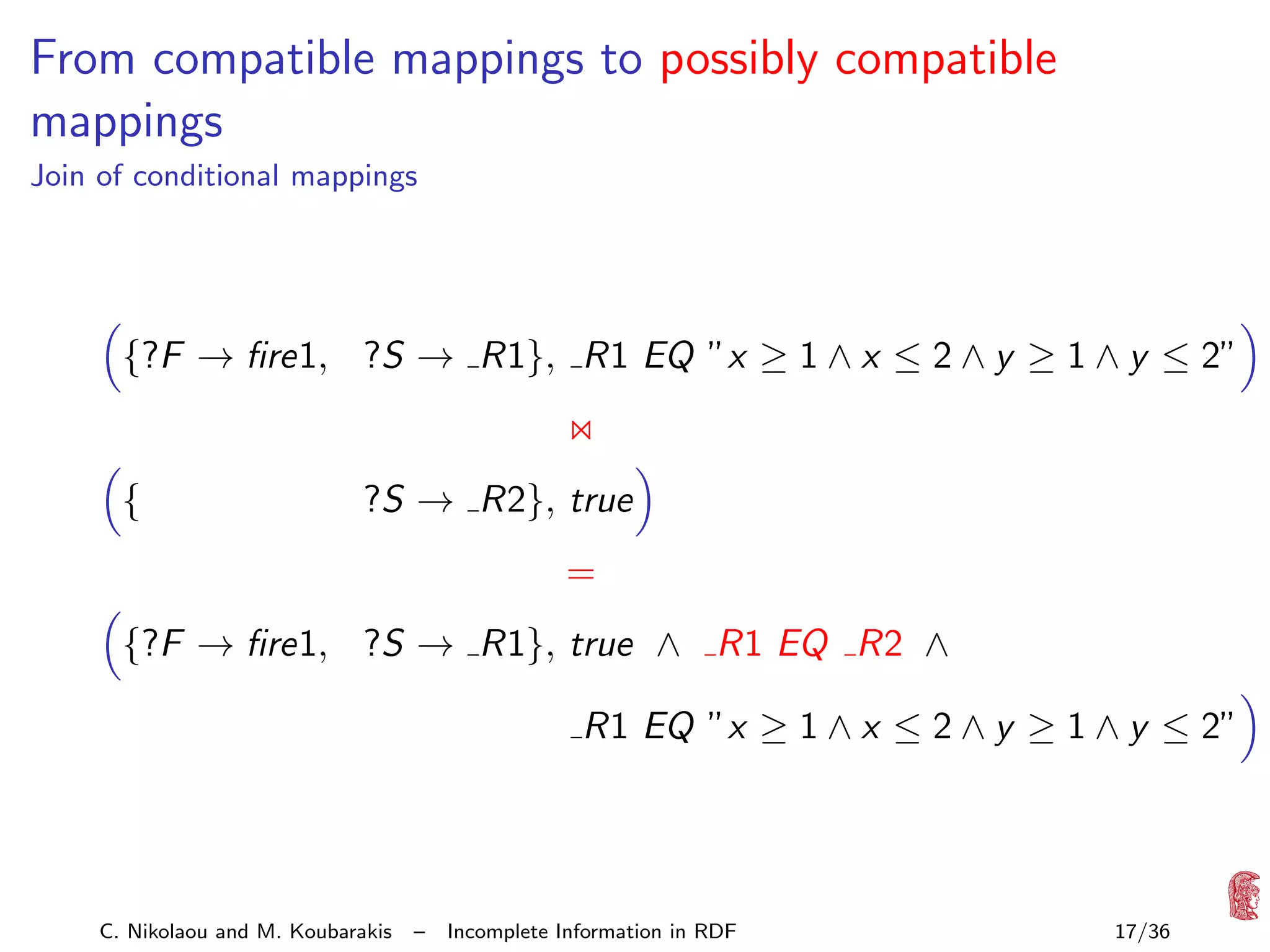
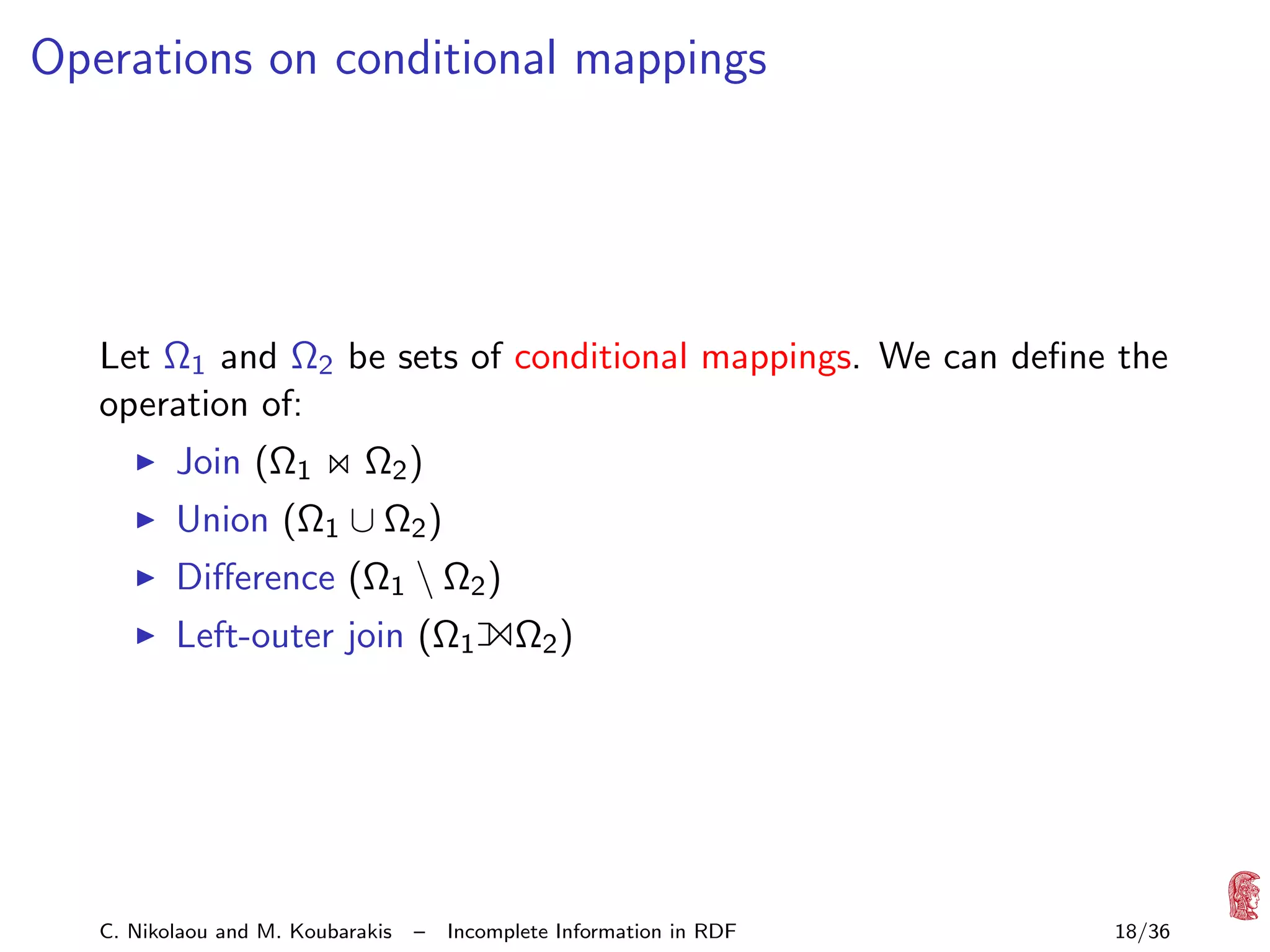
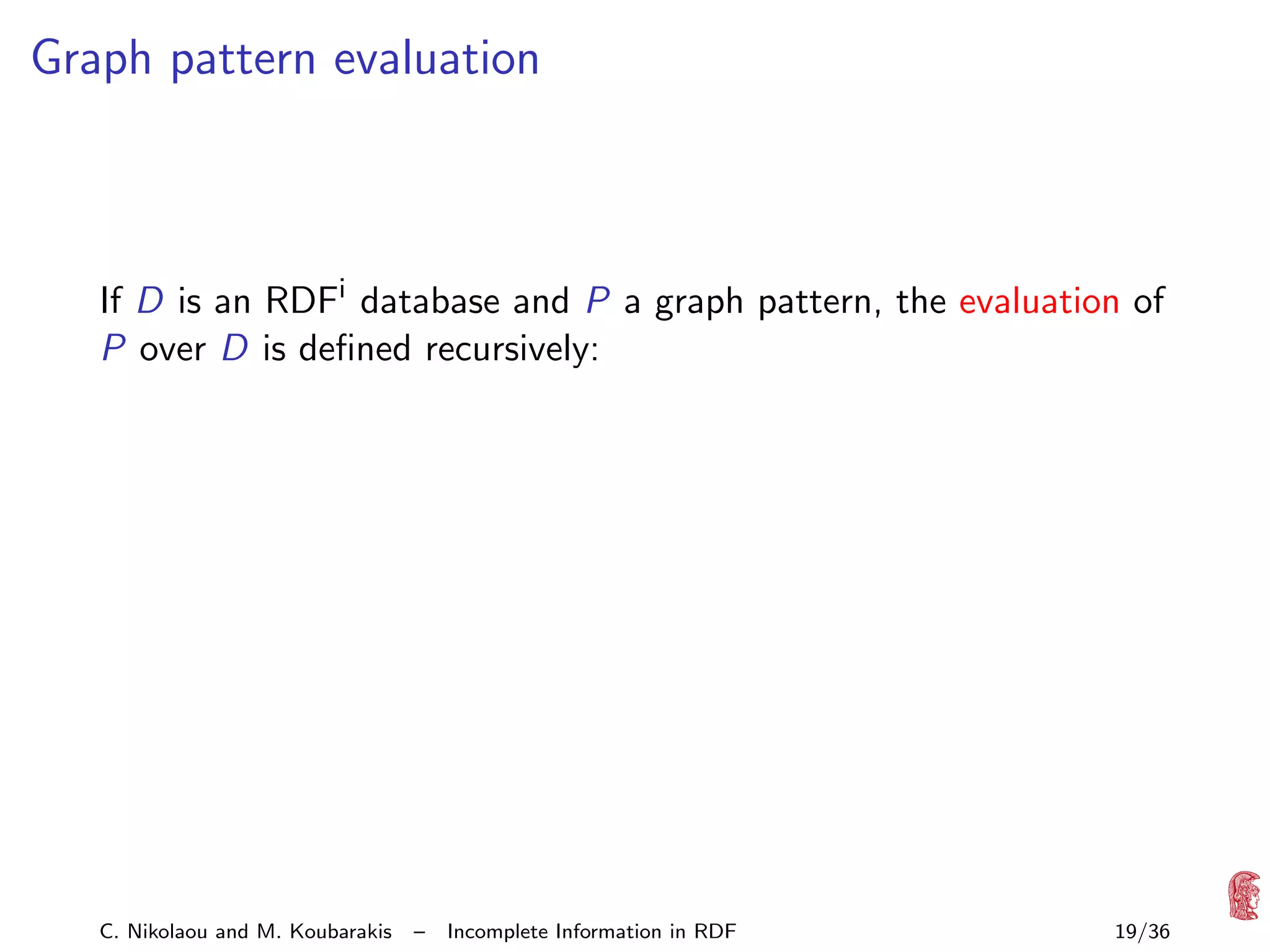
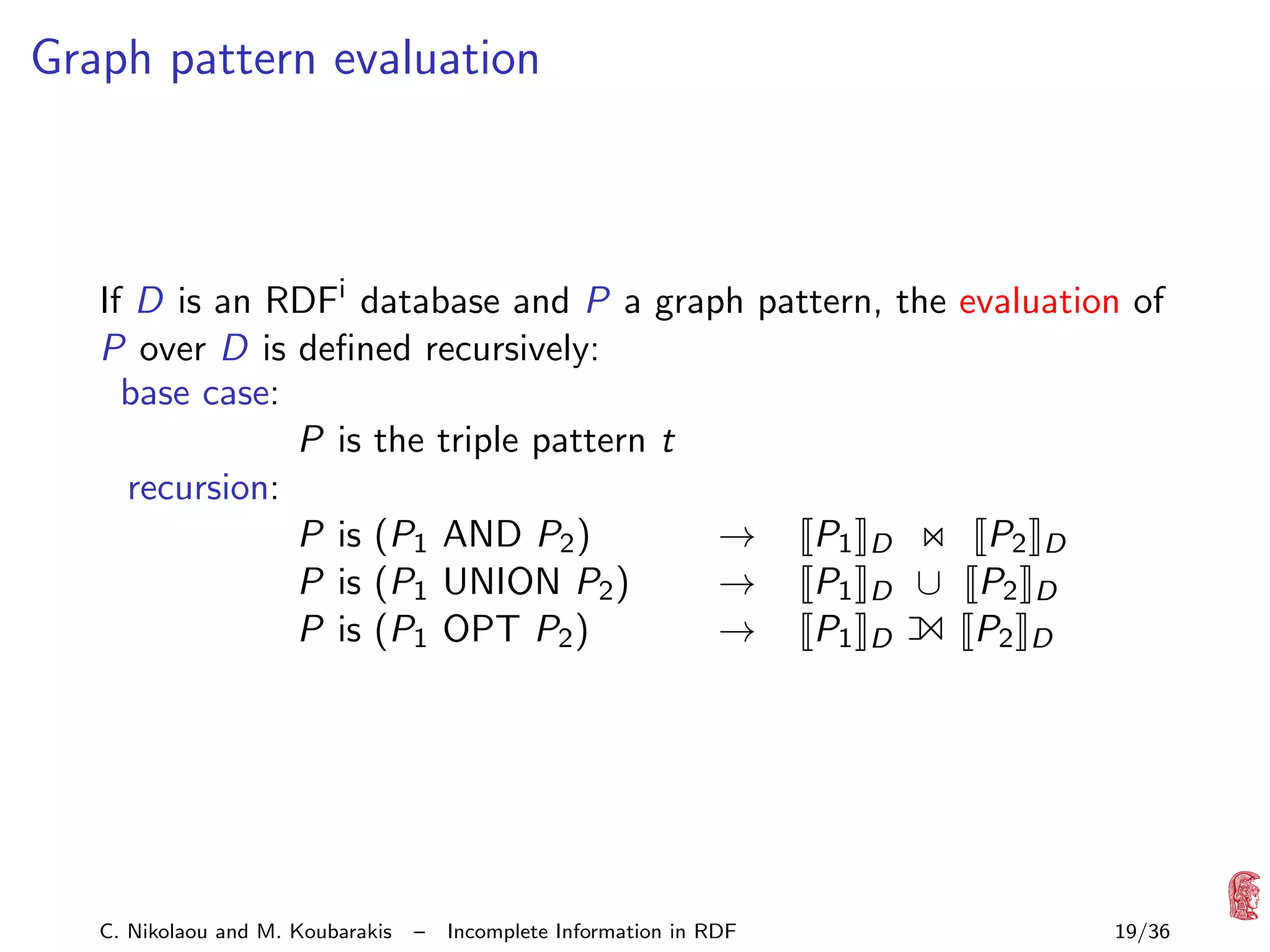
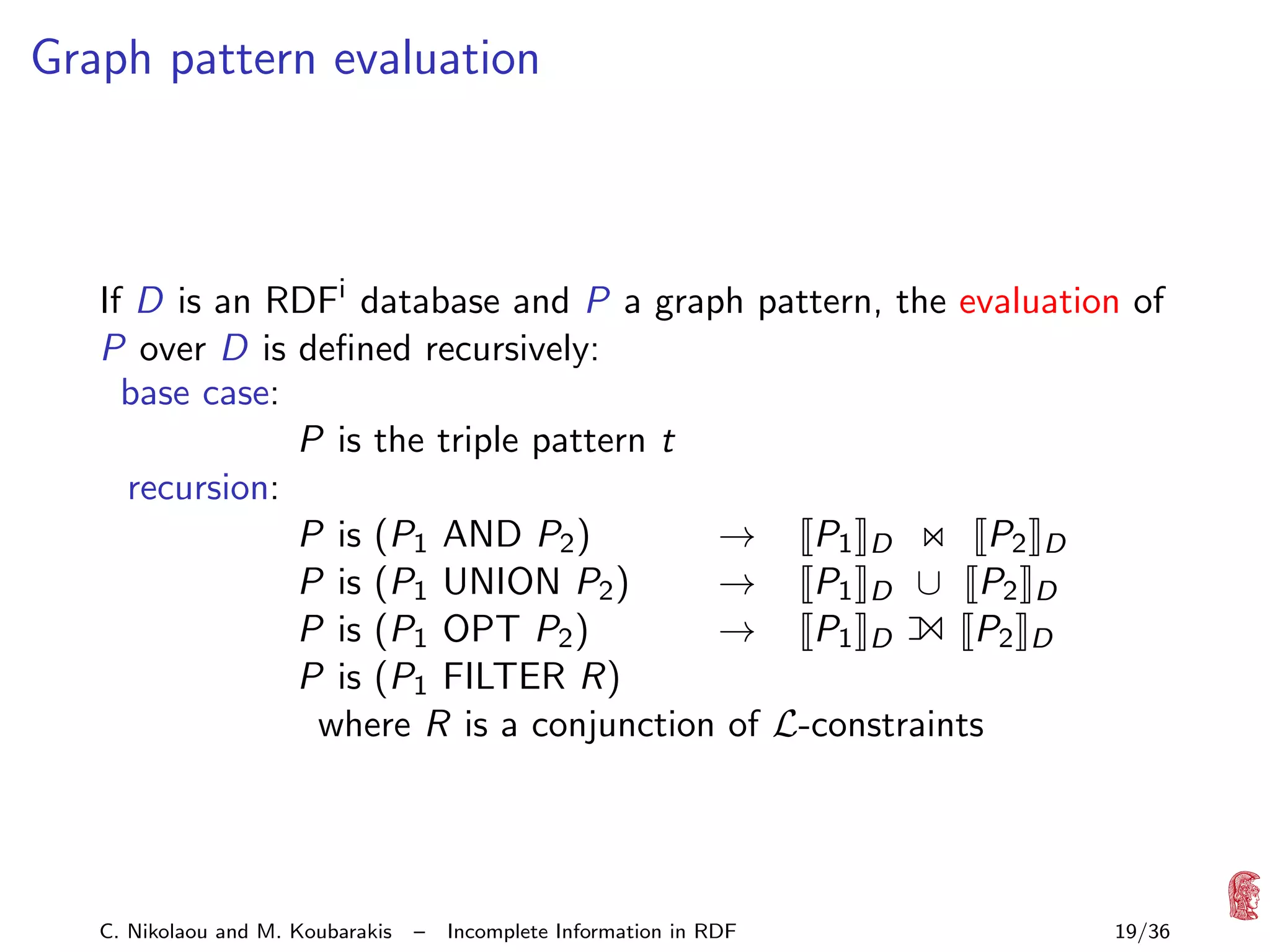
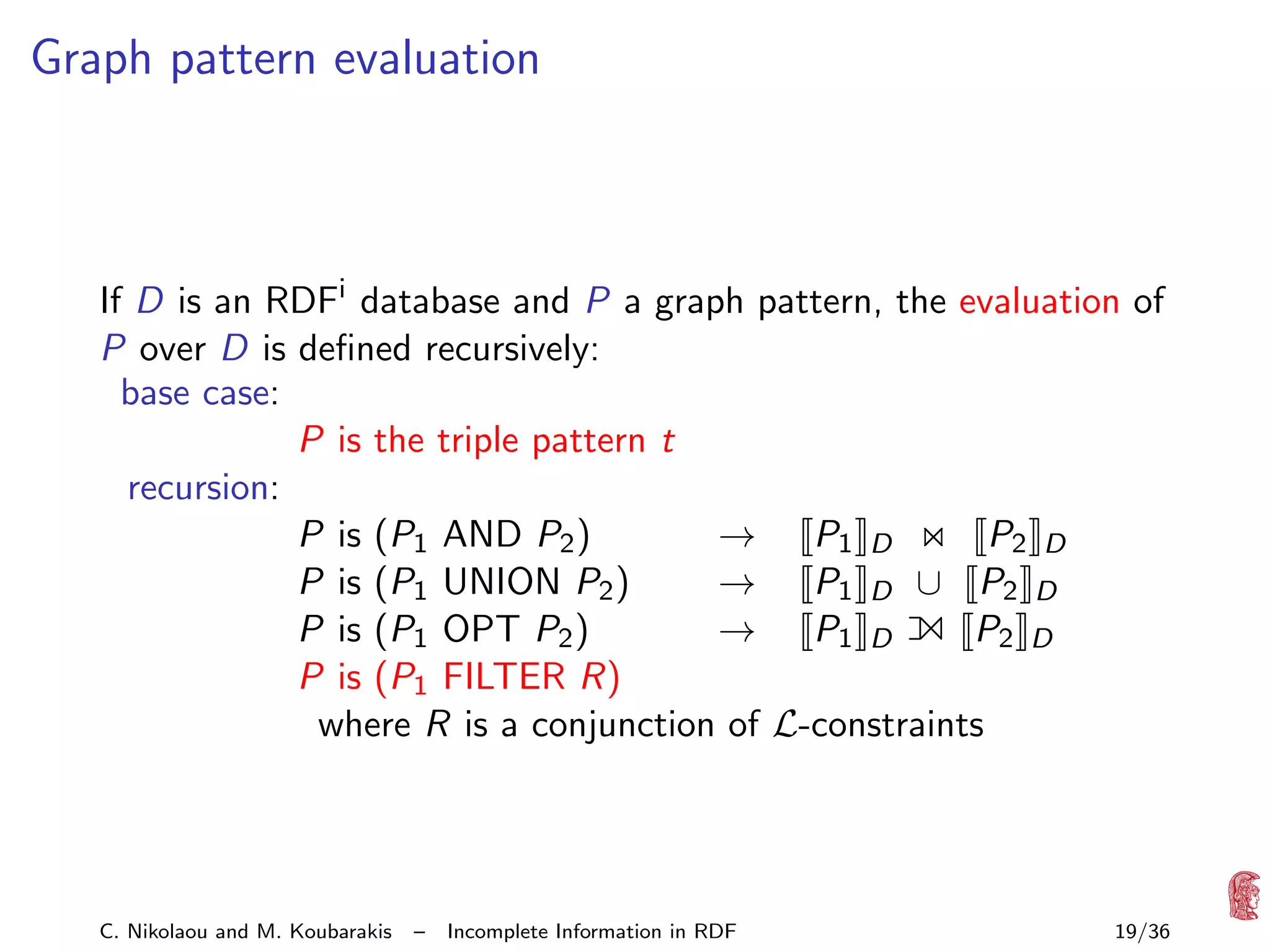

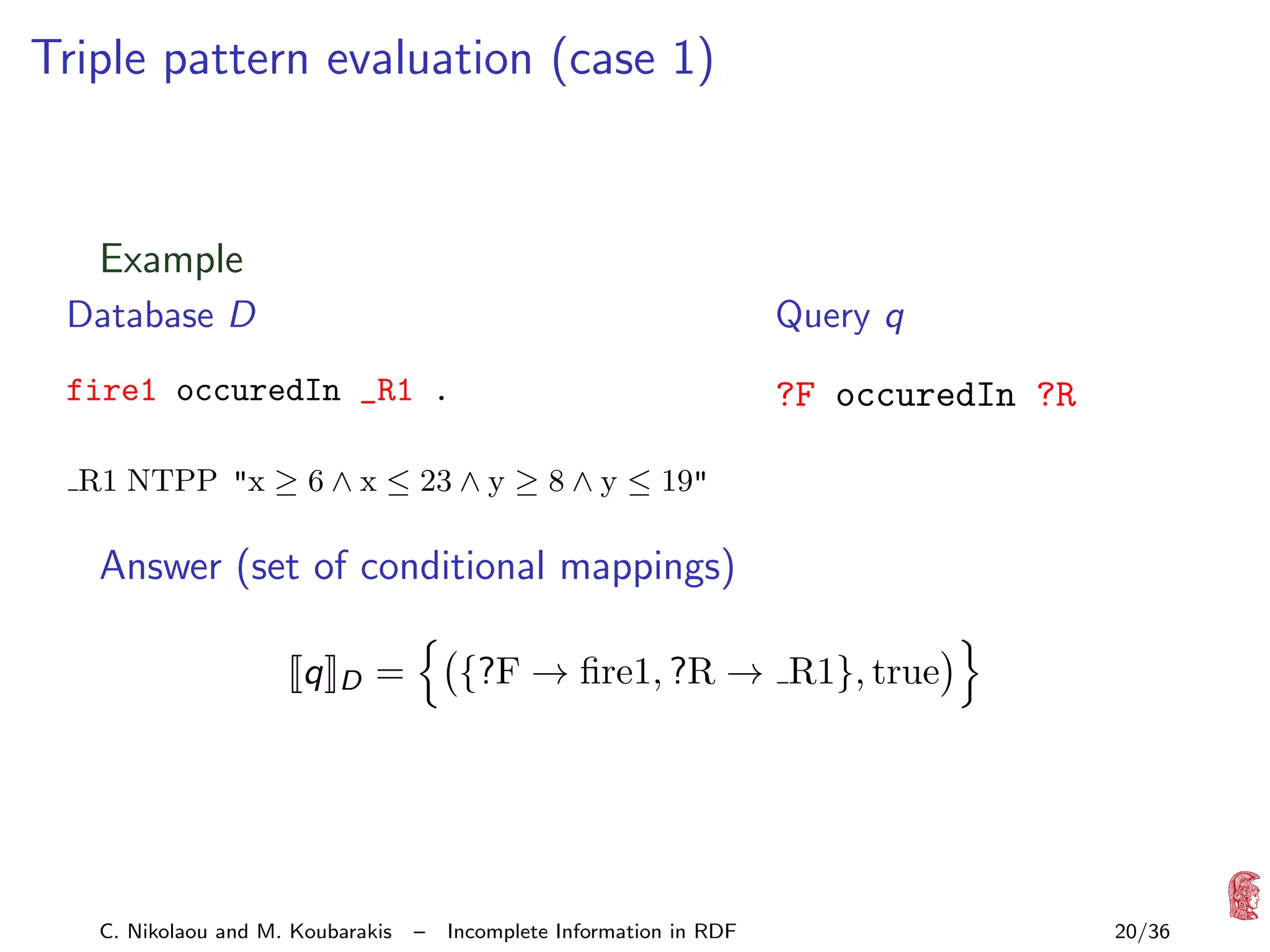
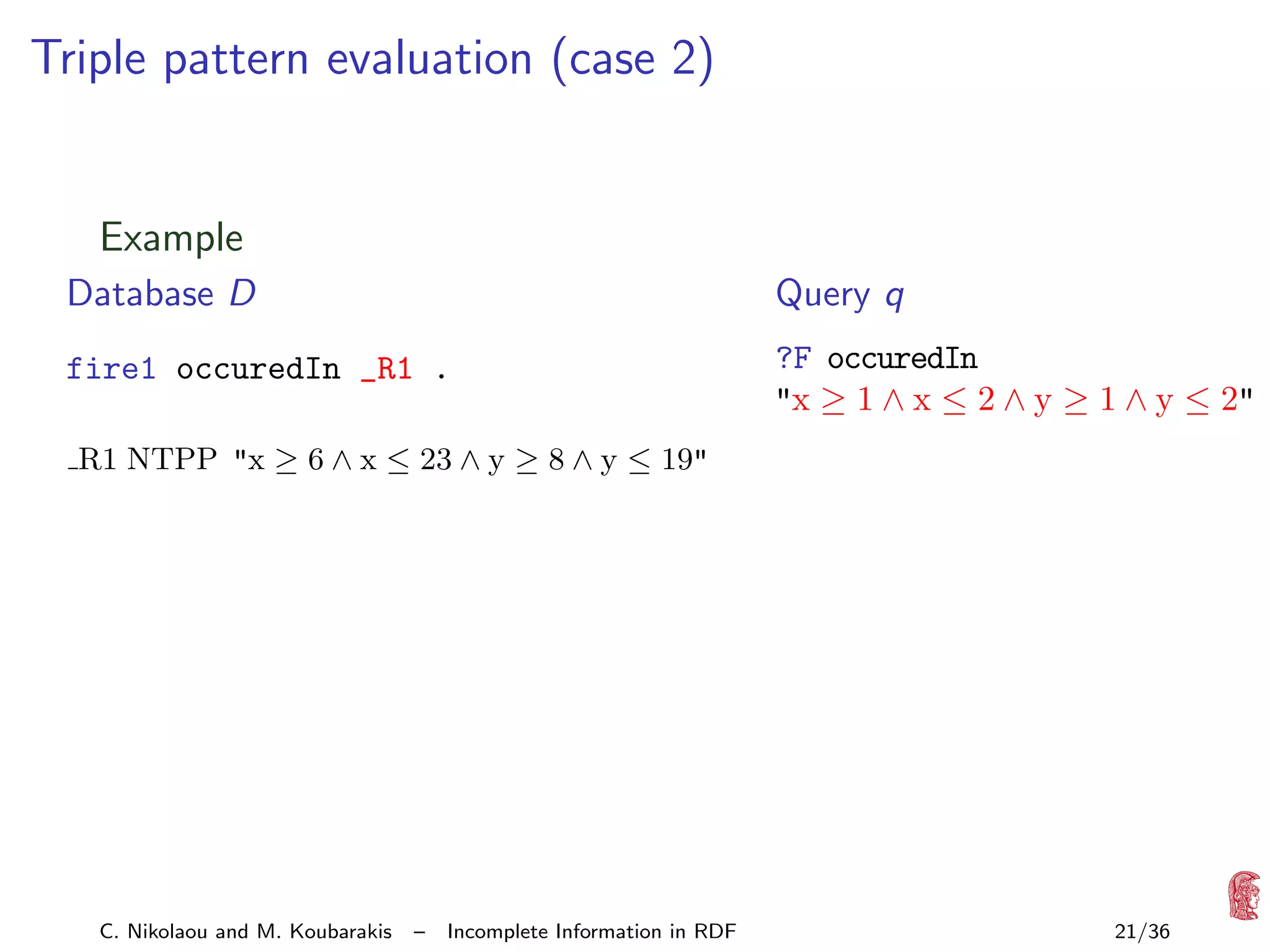
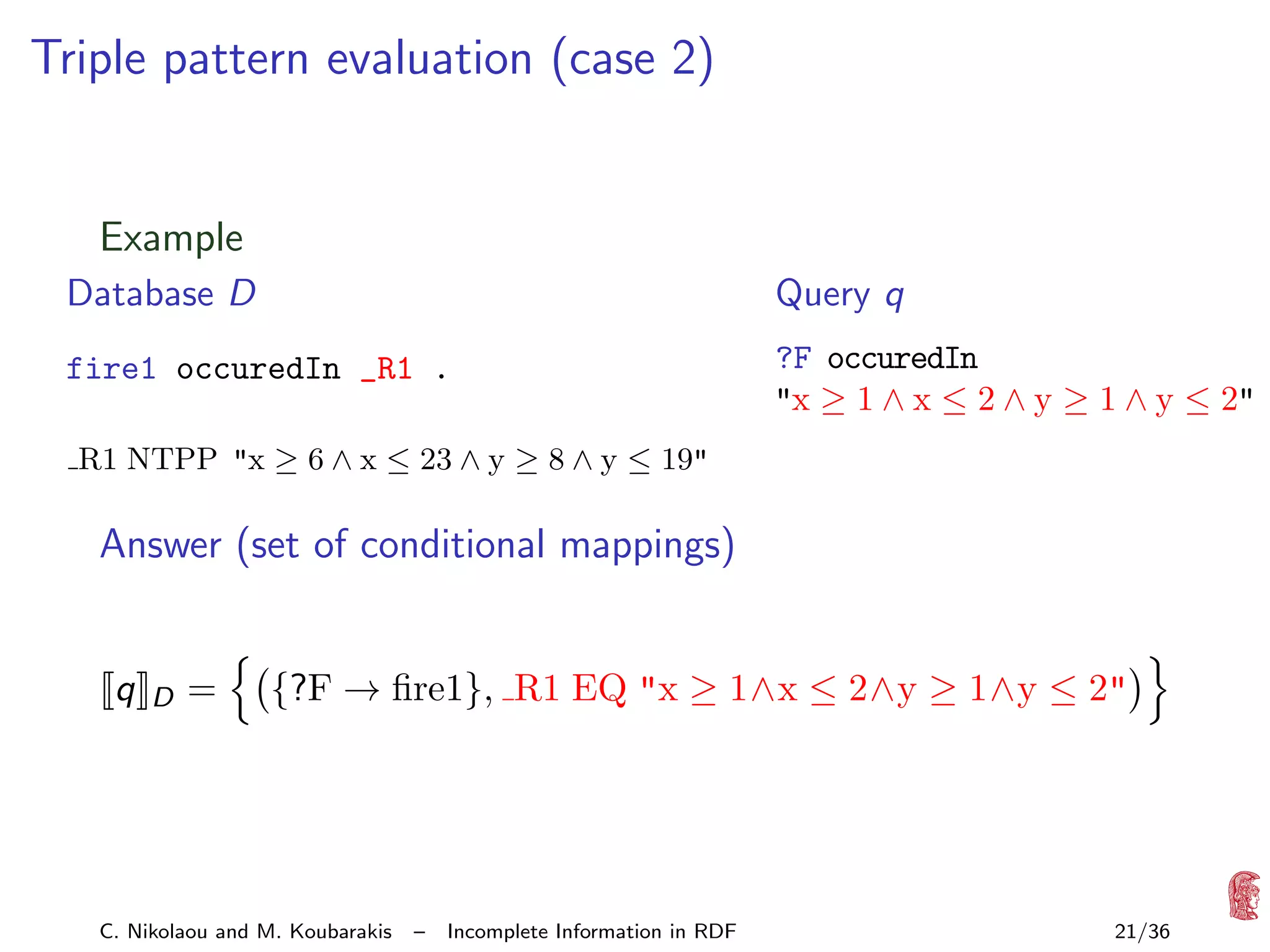
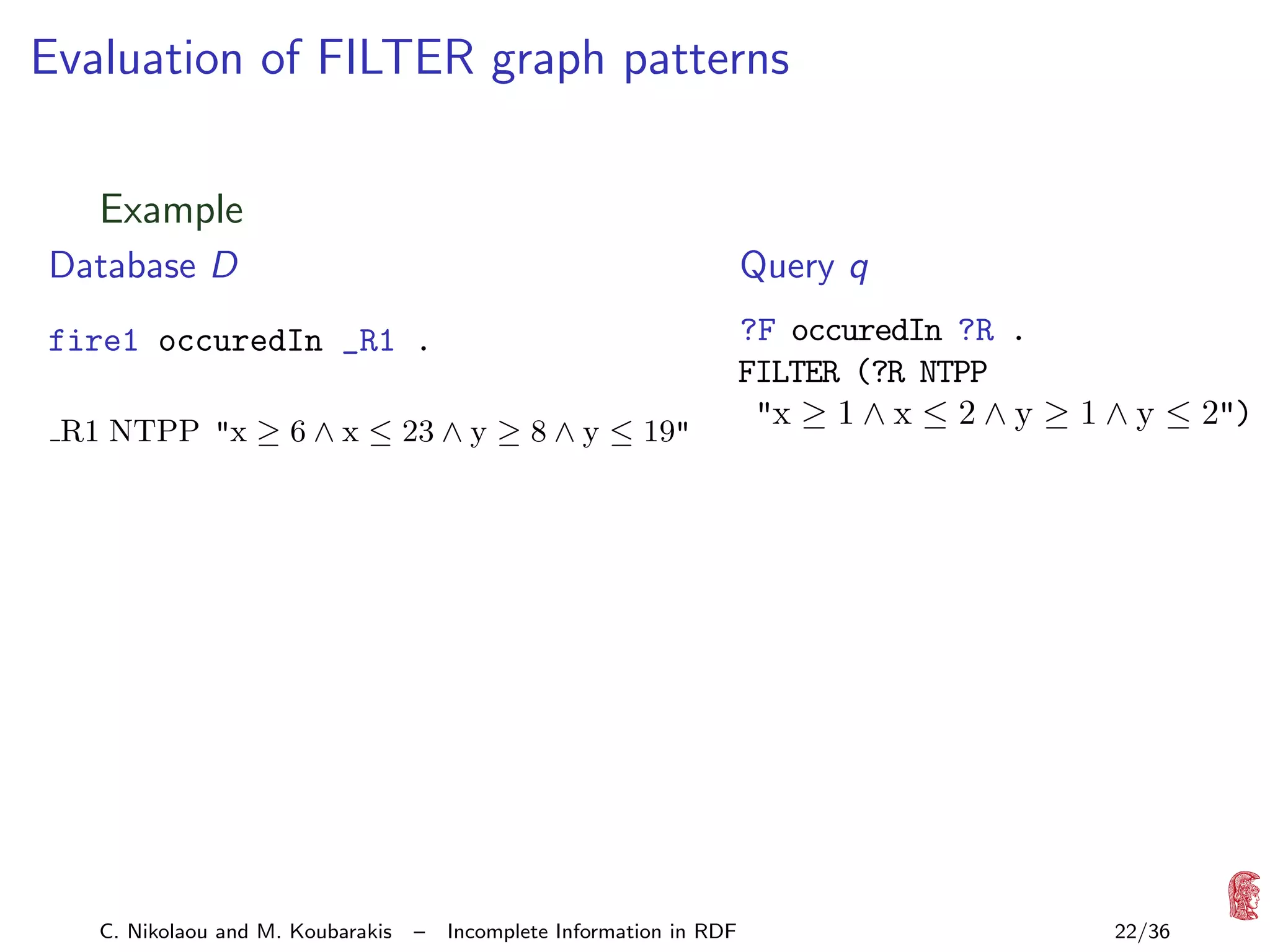
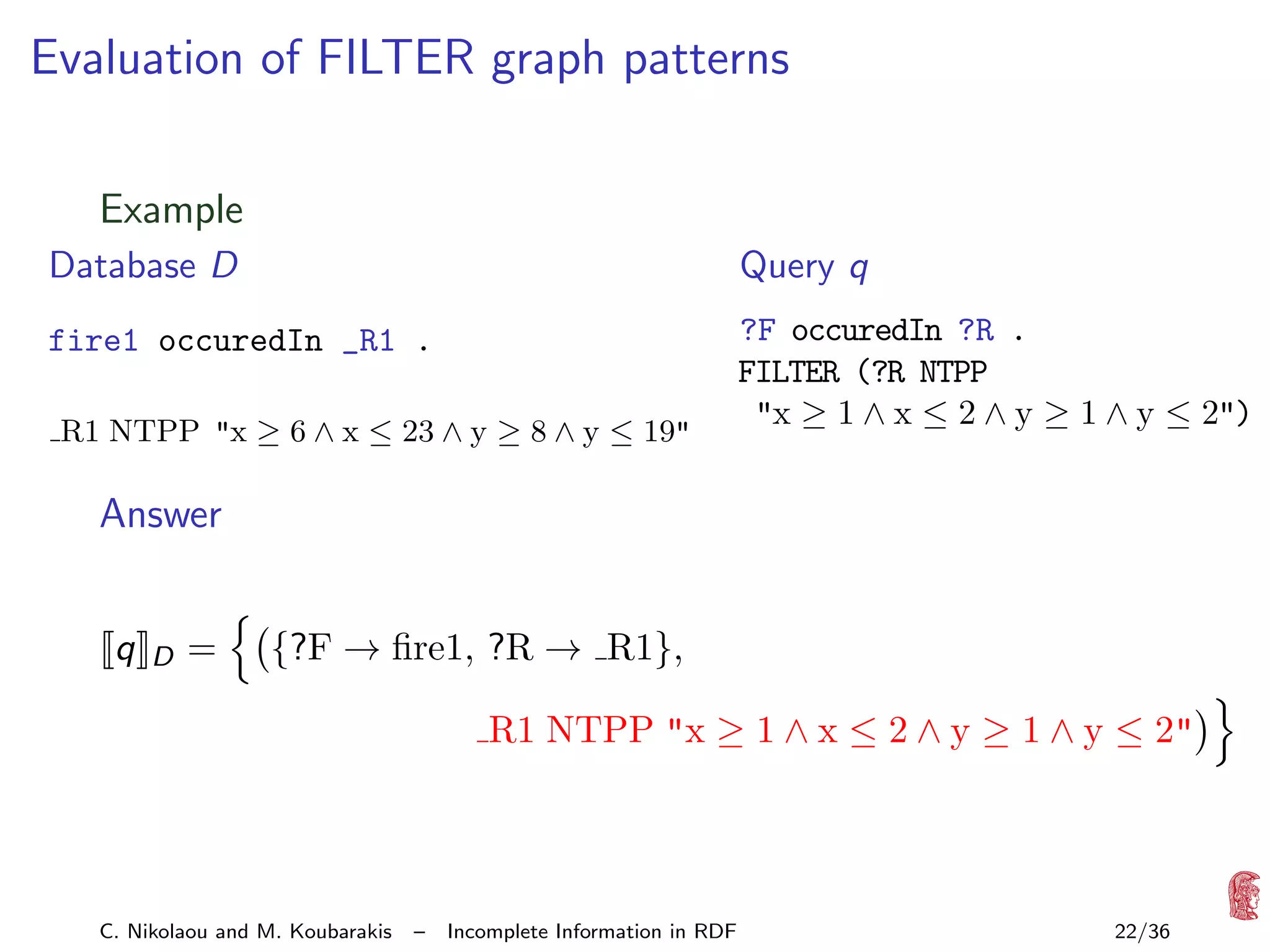
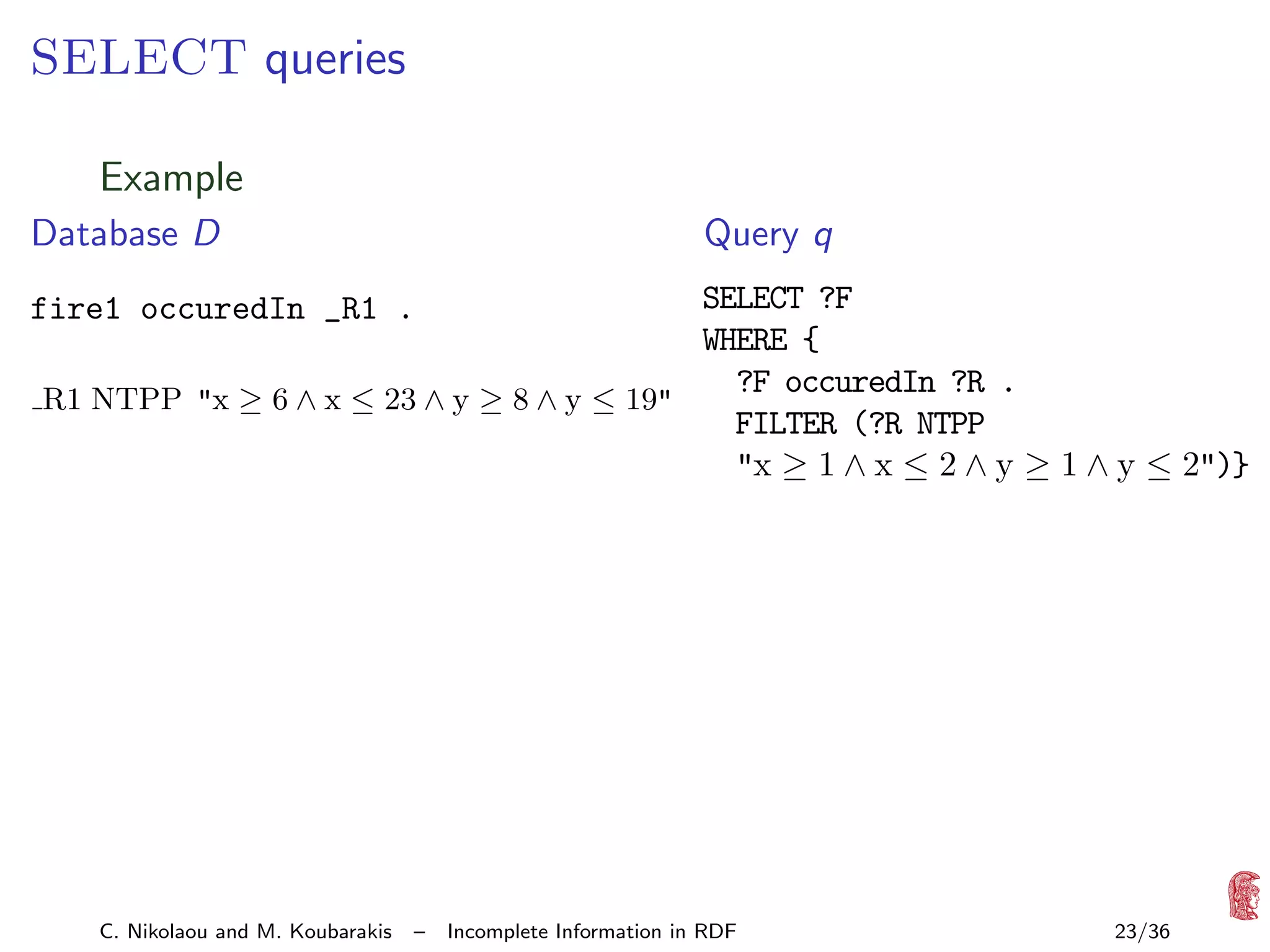

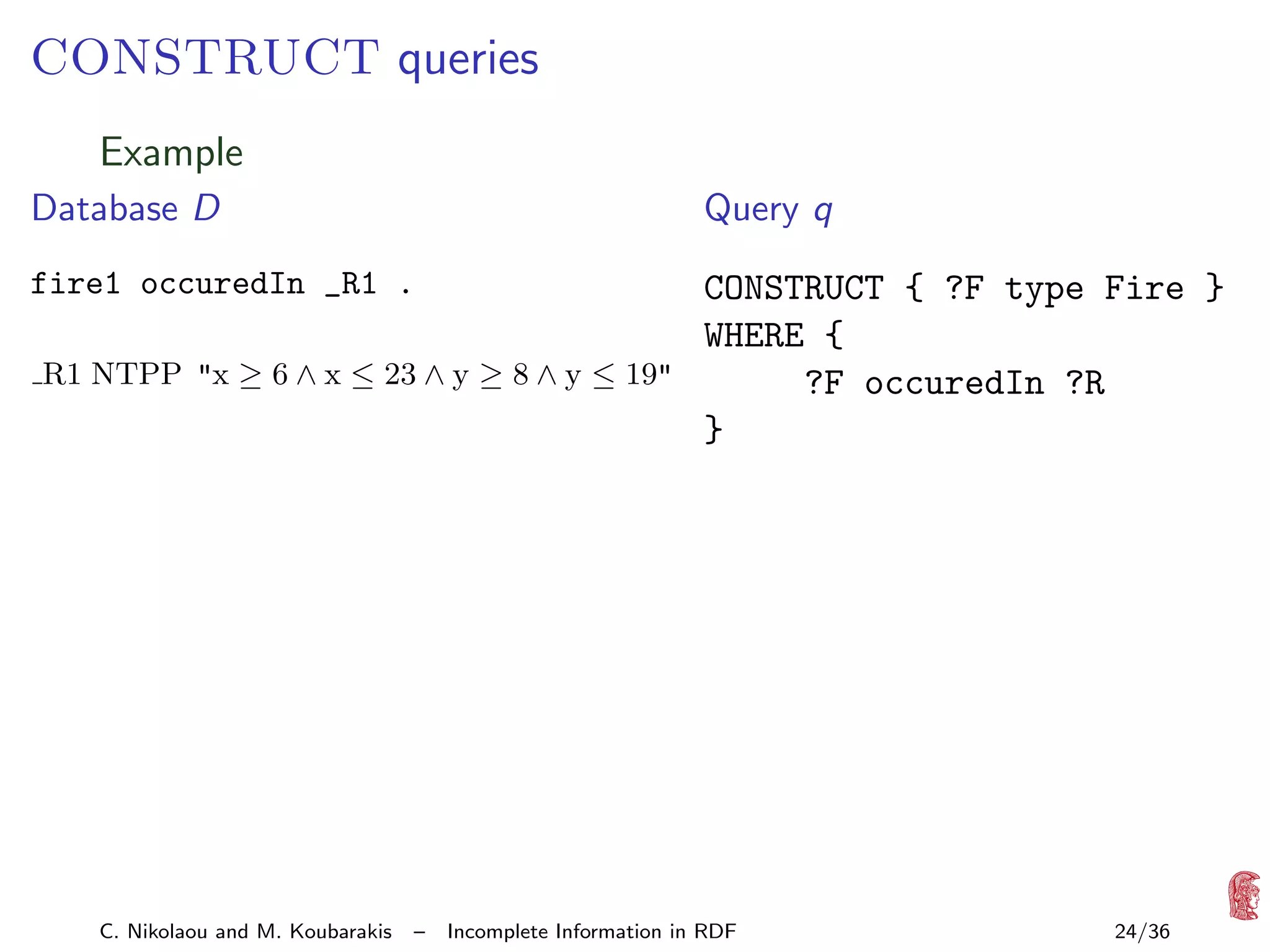

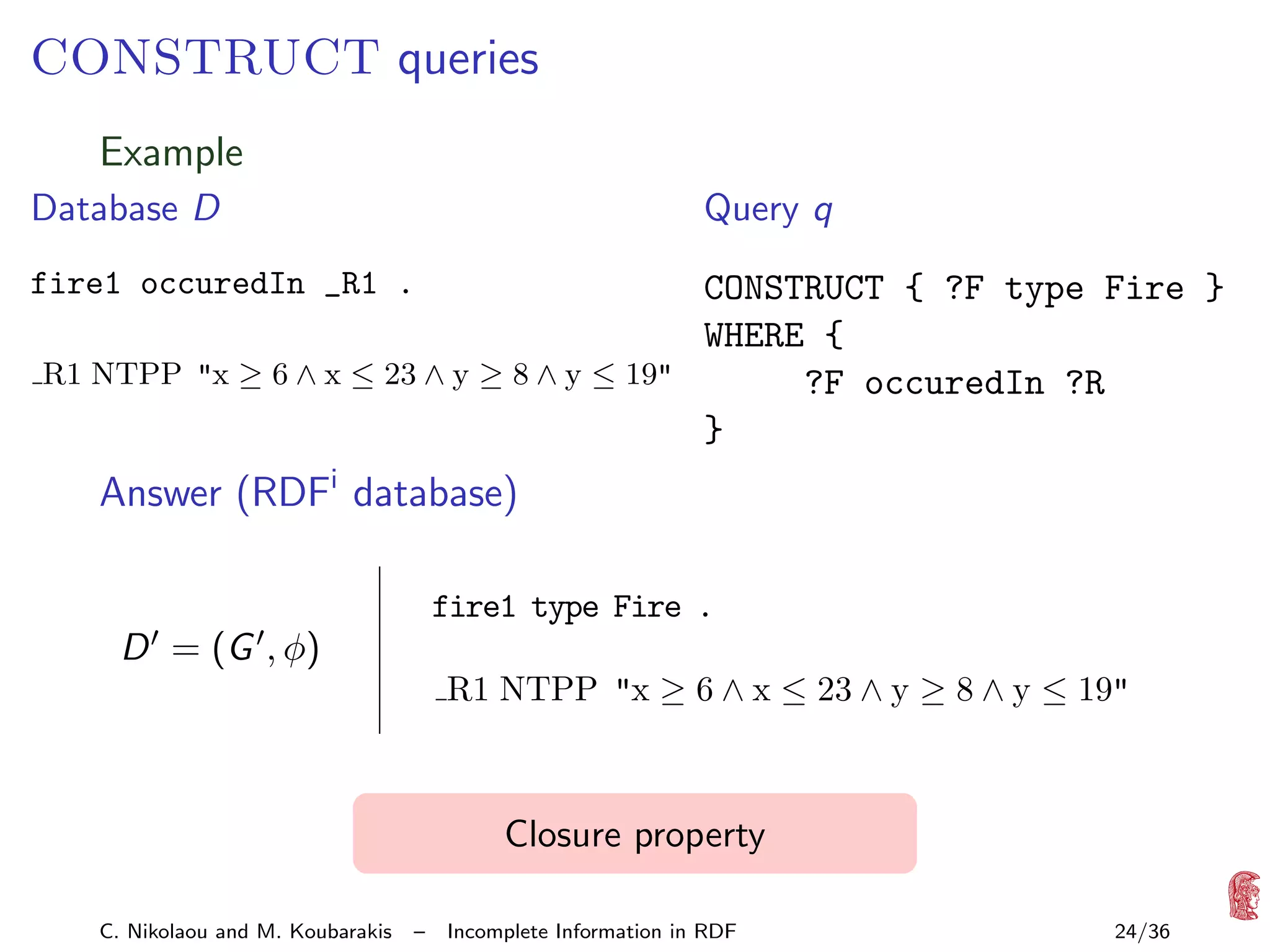
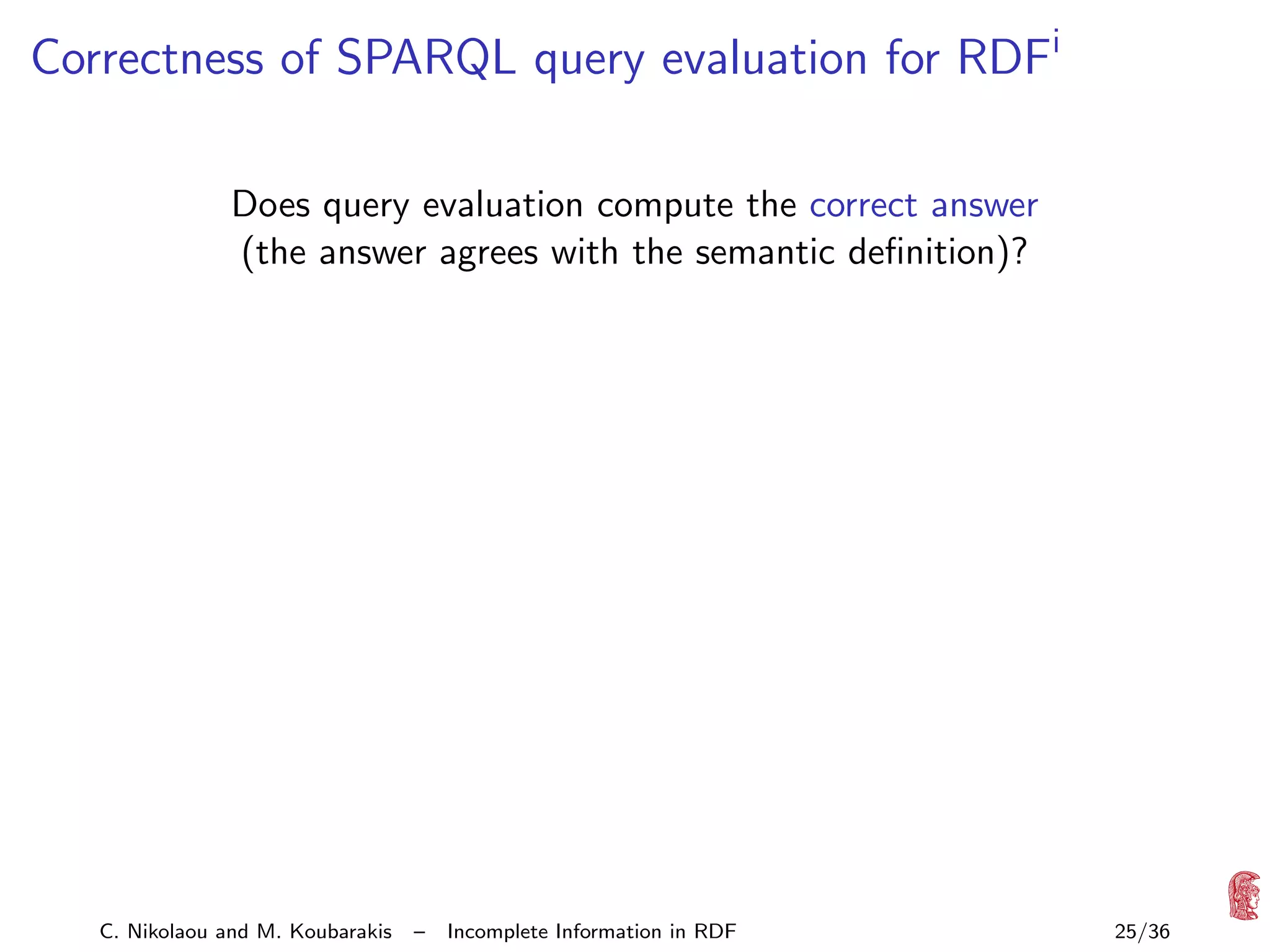
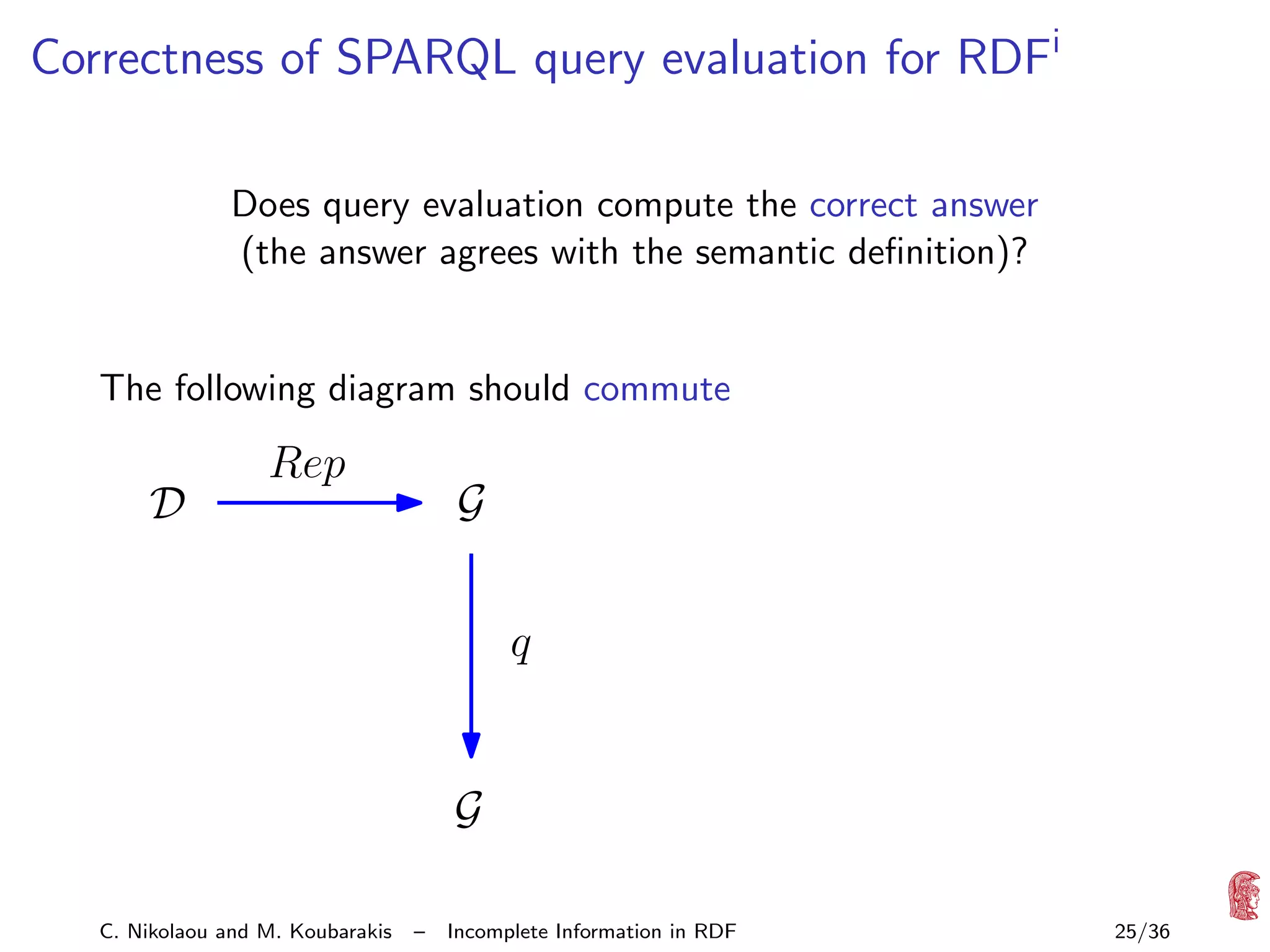
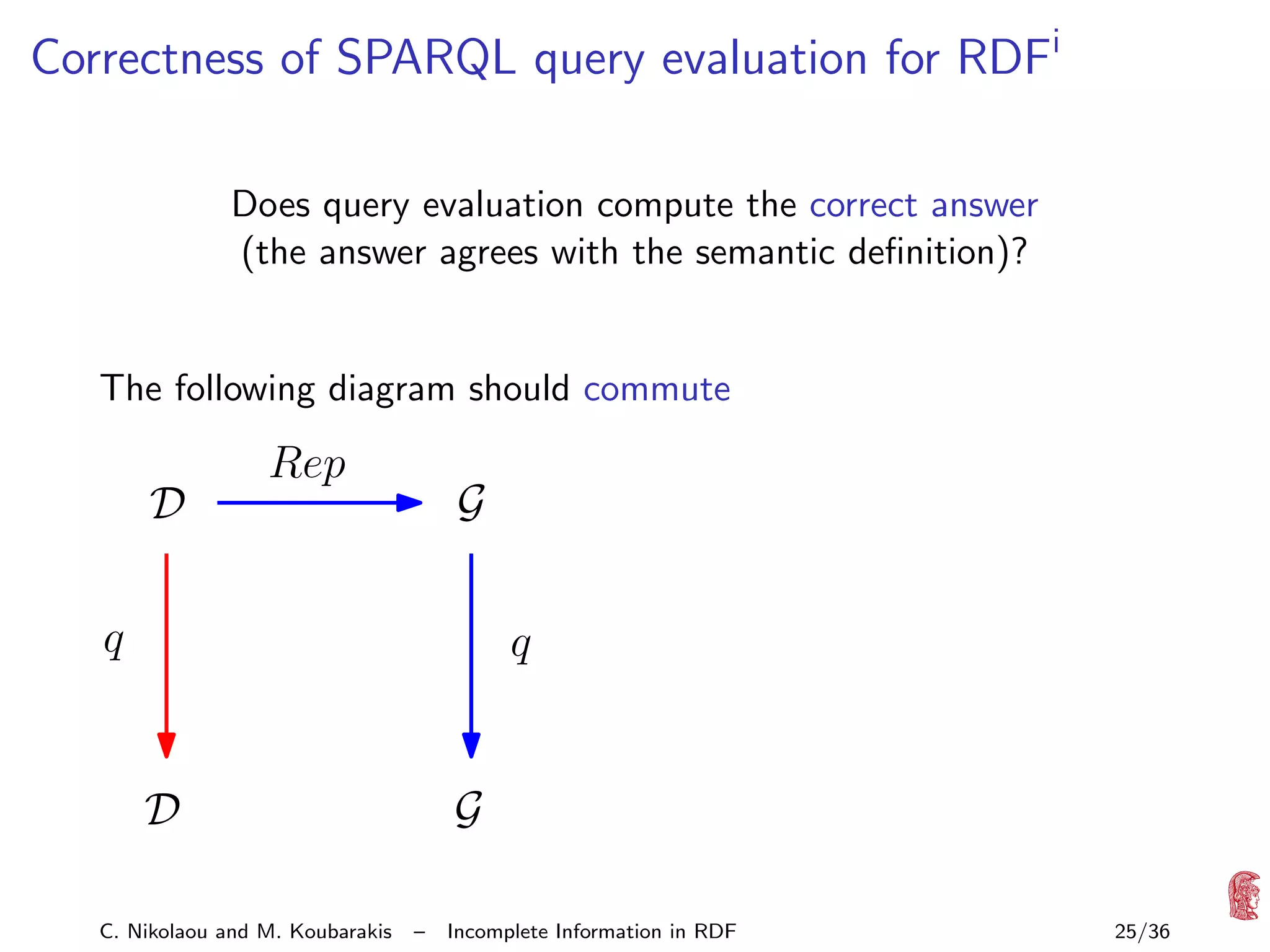
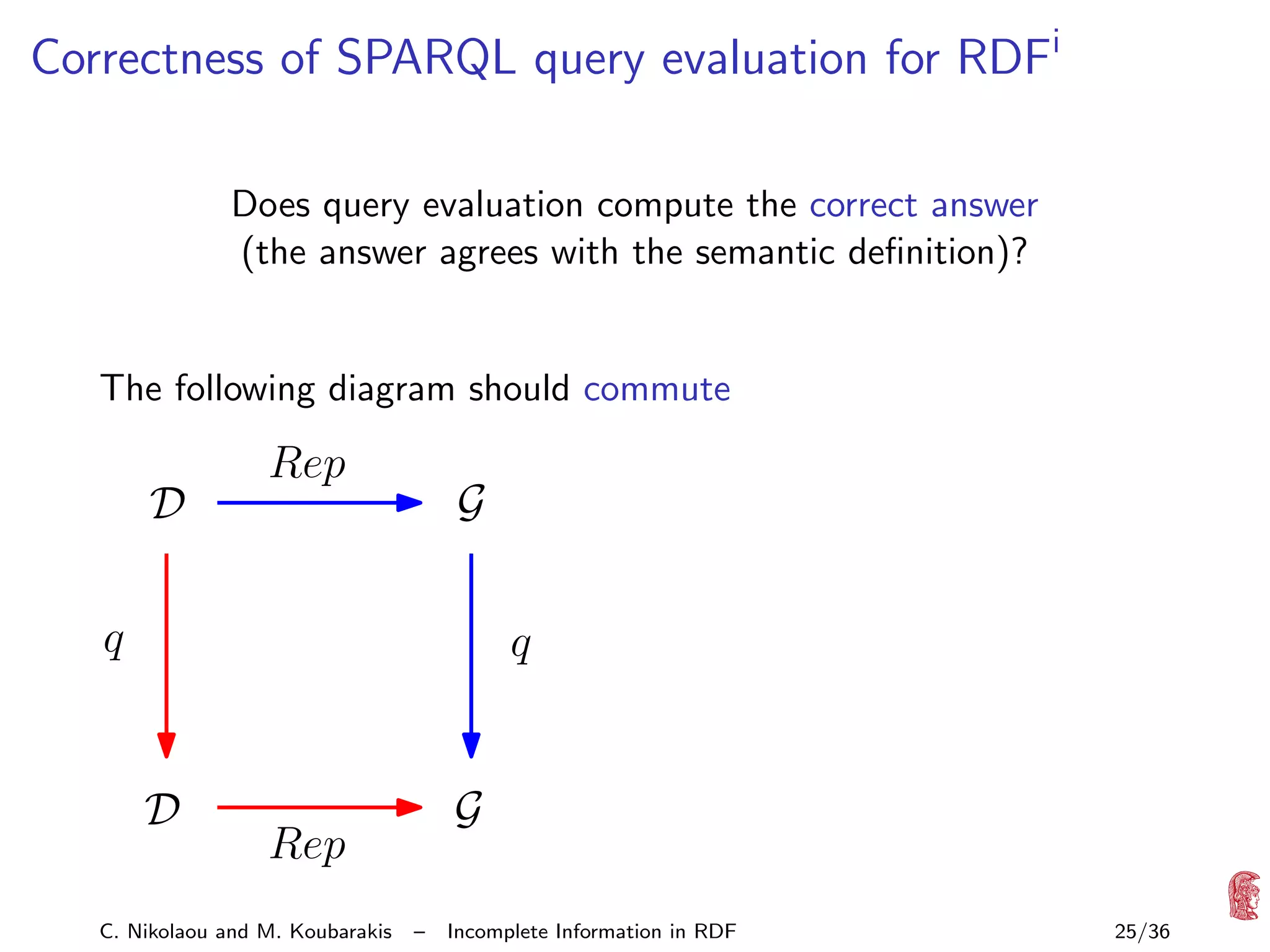
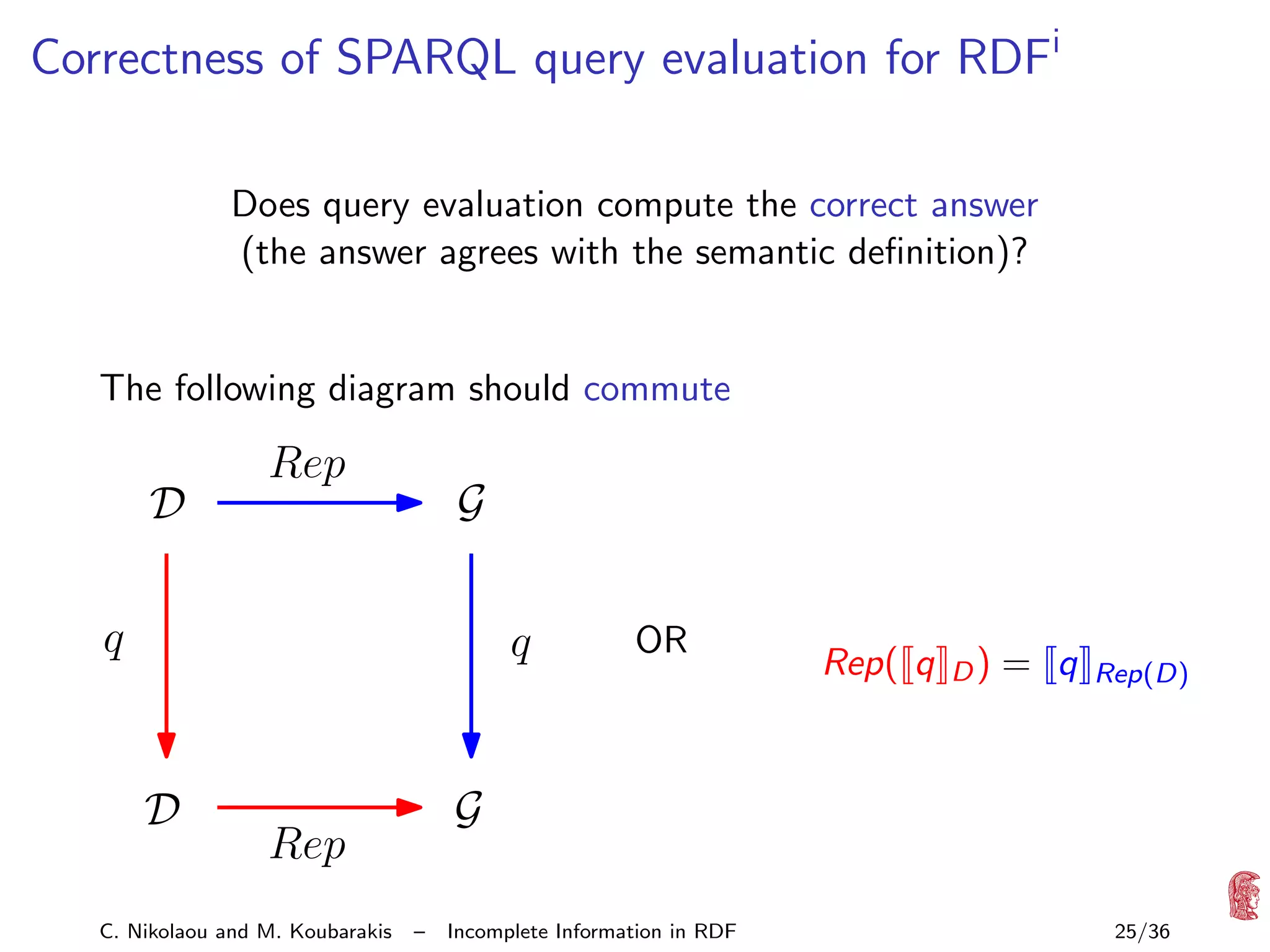
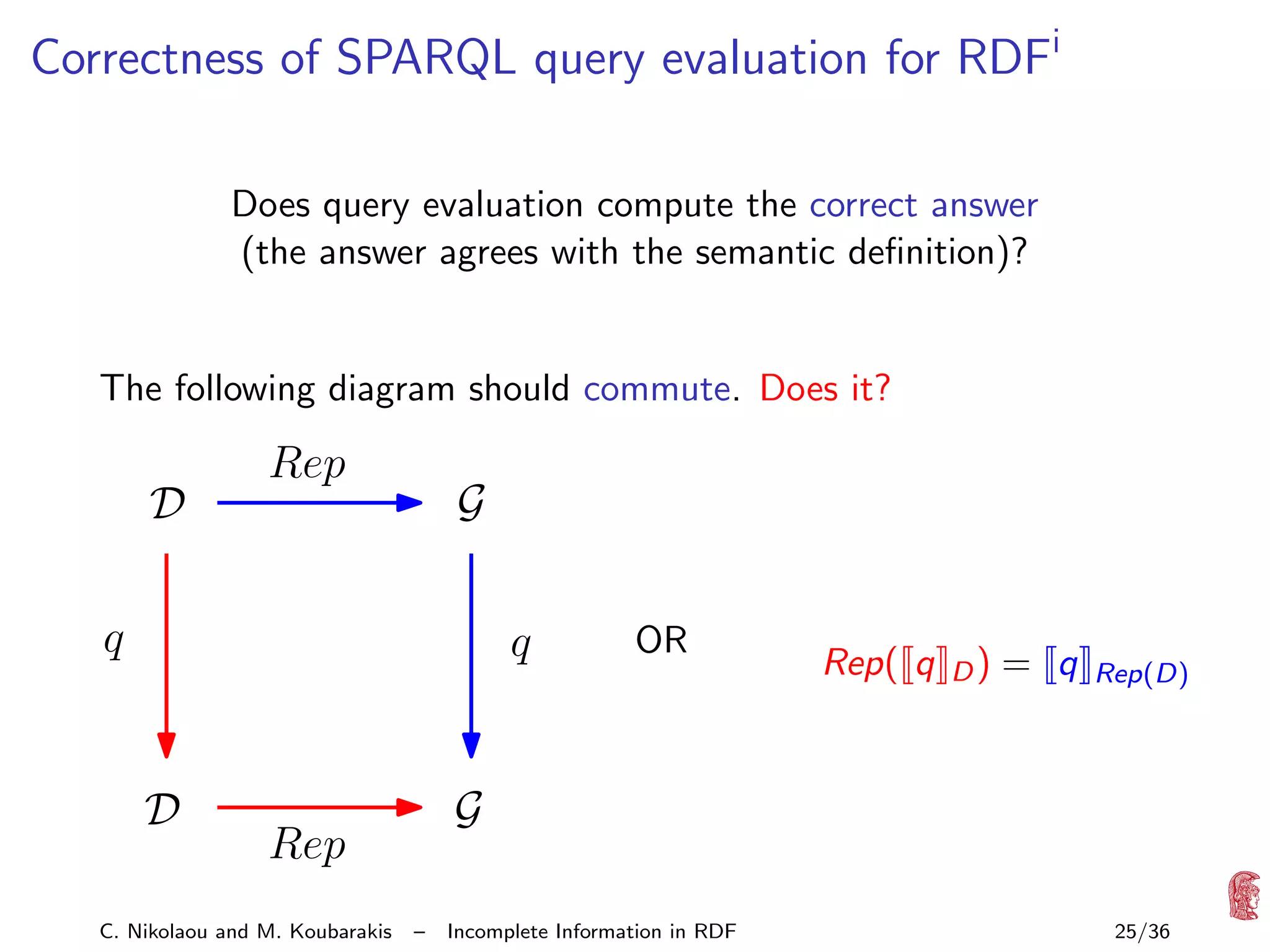

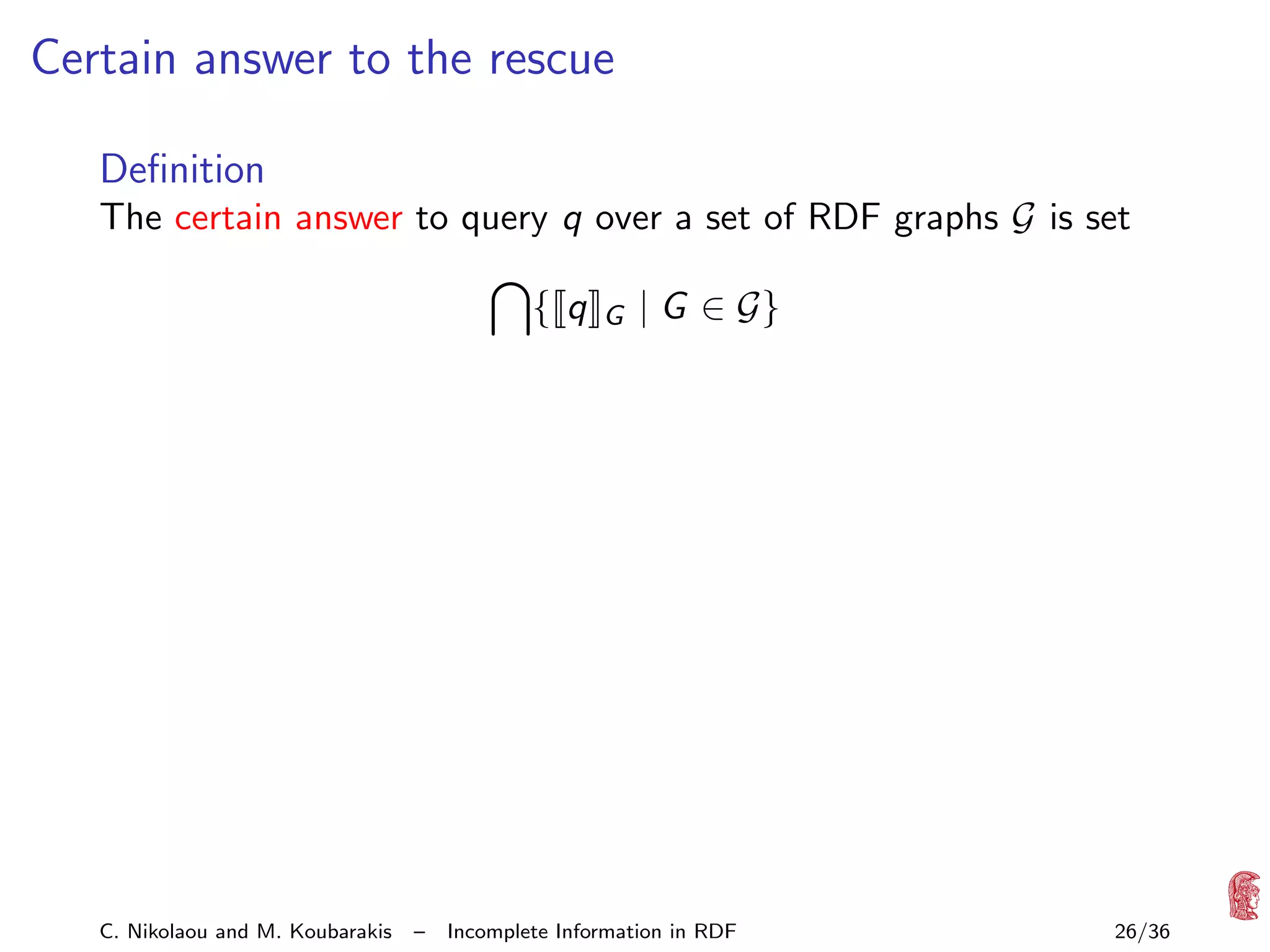
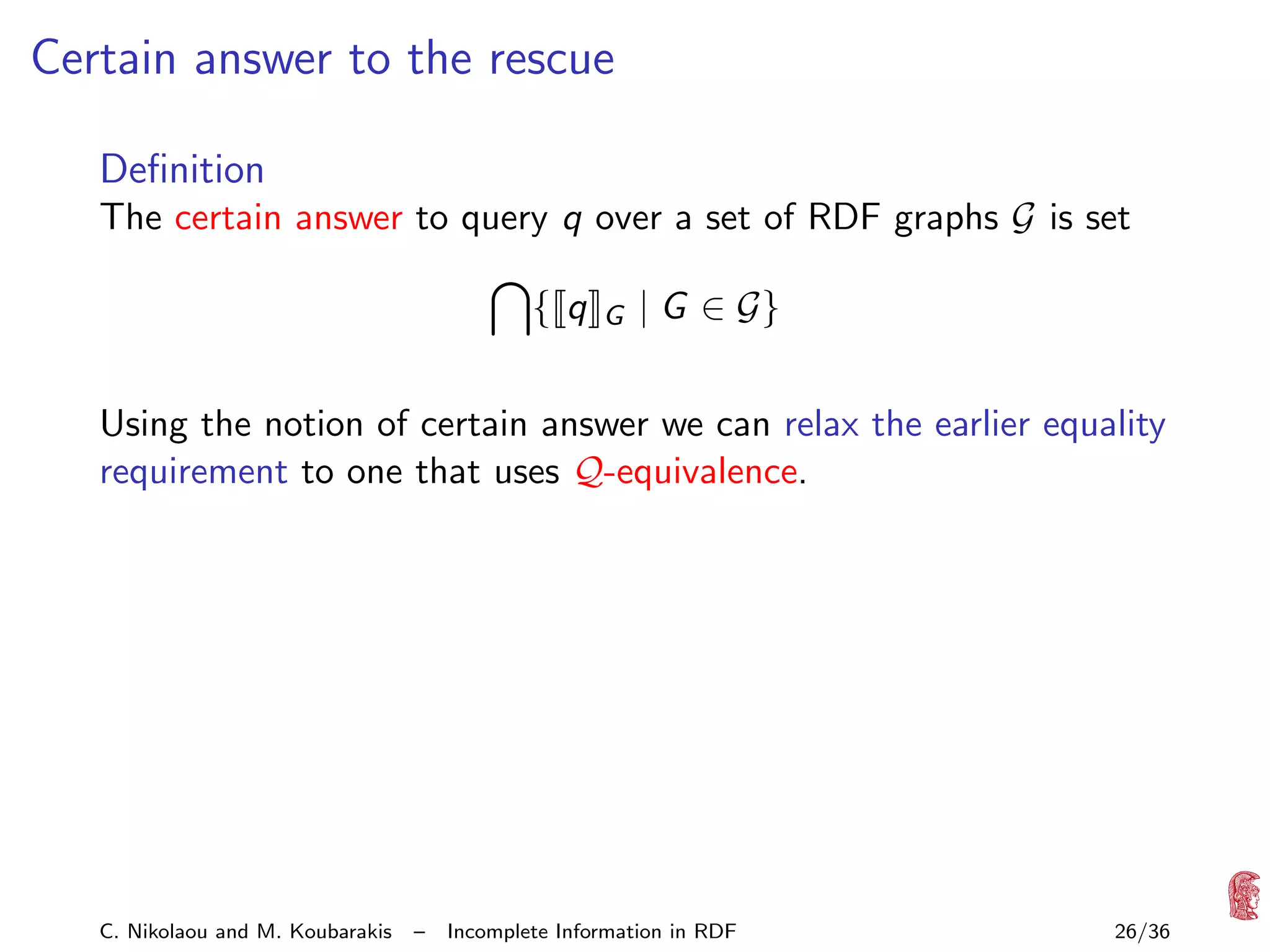

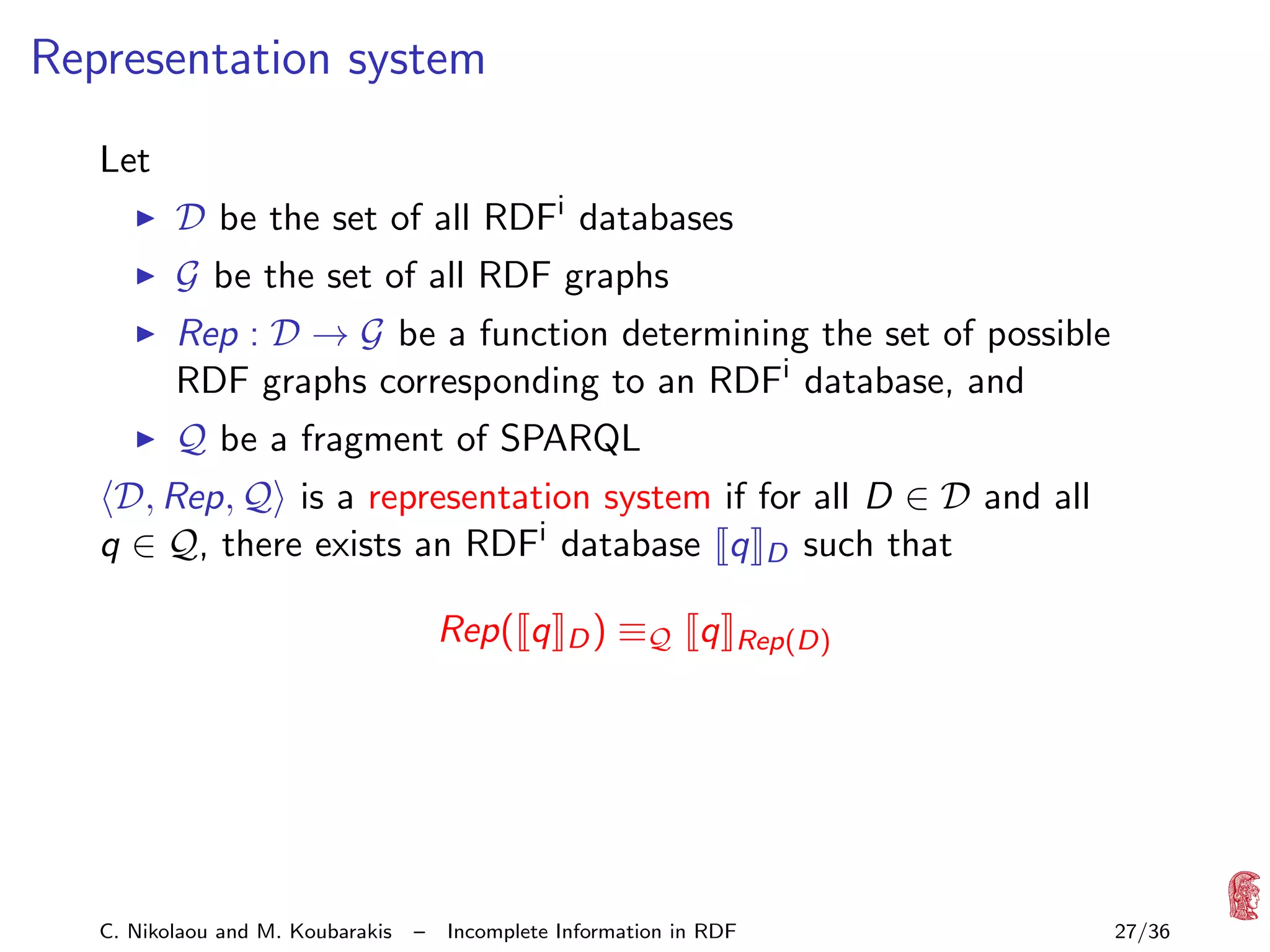
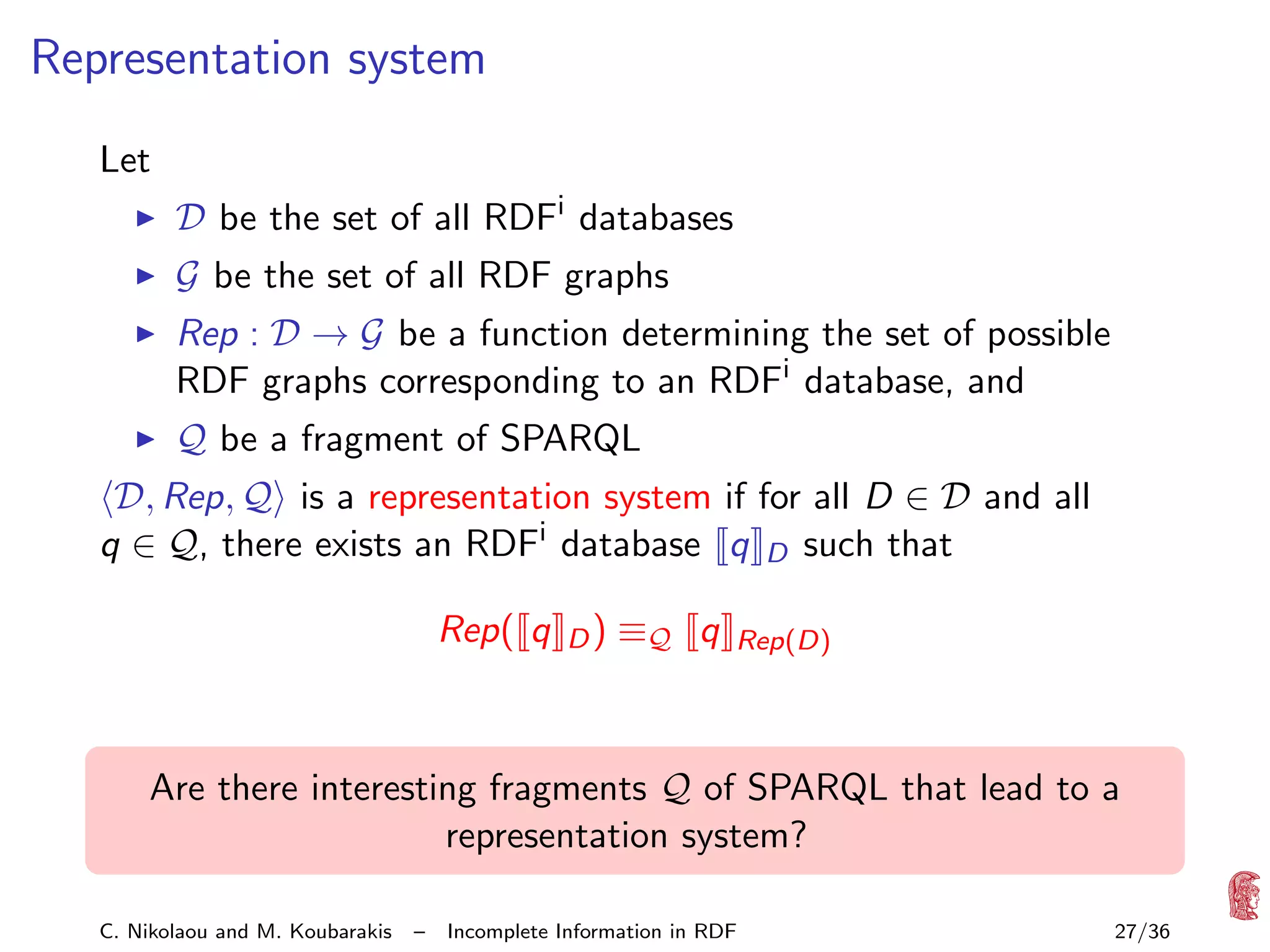
![Representation systems for RDFi
Theorem
The following fragments of SPARQL can give us representation
systems for RDFi (with D and Rep as defined):
QC : CONSTRUCT queries using only AND, UNION,
AUF
and FILTER graph patterns, and without blank nodes in their
templates
QC : CONSTRUCT queries using only well-designed
WD
graph patterns, and without blank nodes in their templates
Well-designed graph patterns [P´rez/Arenas/Gutierrez ’06]
e
AND, FILTER, OPT fragment
P FILTER R: safe
P1 OPT P2 : variables in P2 are properly scoped
C. Nikolaou and M. Koubarakis
–
Incomplete Information in RDF
28/36](https://image.slidesharecdn.com/rr2013-presentation-131020155616-phpapp01/75/Incomplete-Information-in-RDF-65-2048.jpg)
![Representation systems for RDFi (cont’d)
Monotonicity
Definition
A fragment Q of SPARQL is monotone if for every q ∈ Q and
RDF graphs G and H such that G ⊆ H, it is q G ⊆ q H .
Proposition [Arenas/P´rez ’11]
e
The fragment of SPARQL corresponding to AND, UNION,
and FILTER graph patterns is monotone.
The fragment of SPARQL corresponding to well-designed
graph patterns is weakly-monotone ( ).
Proposition
Fragments QC and QC are monotone.
AUF
WD
C. Nikolaou and M. Koubarakis
–
Incomplete Information in RDF
29/36](https://image.slidesharecdn.com/rr2013-presentation-131020155616-phpapp01/75/Incomplete-Information-in-RDF-66-2048.jpg)
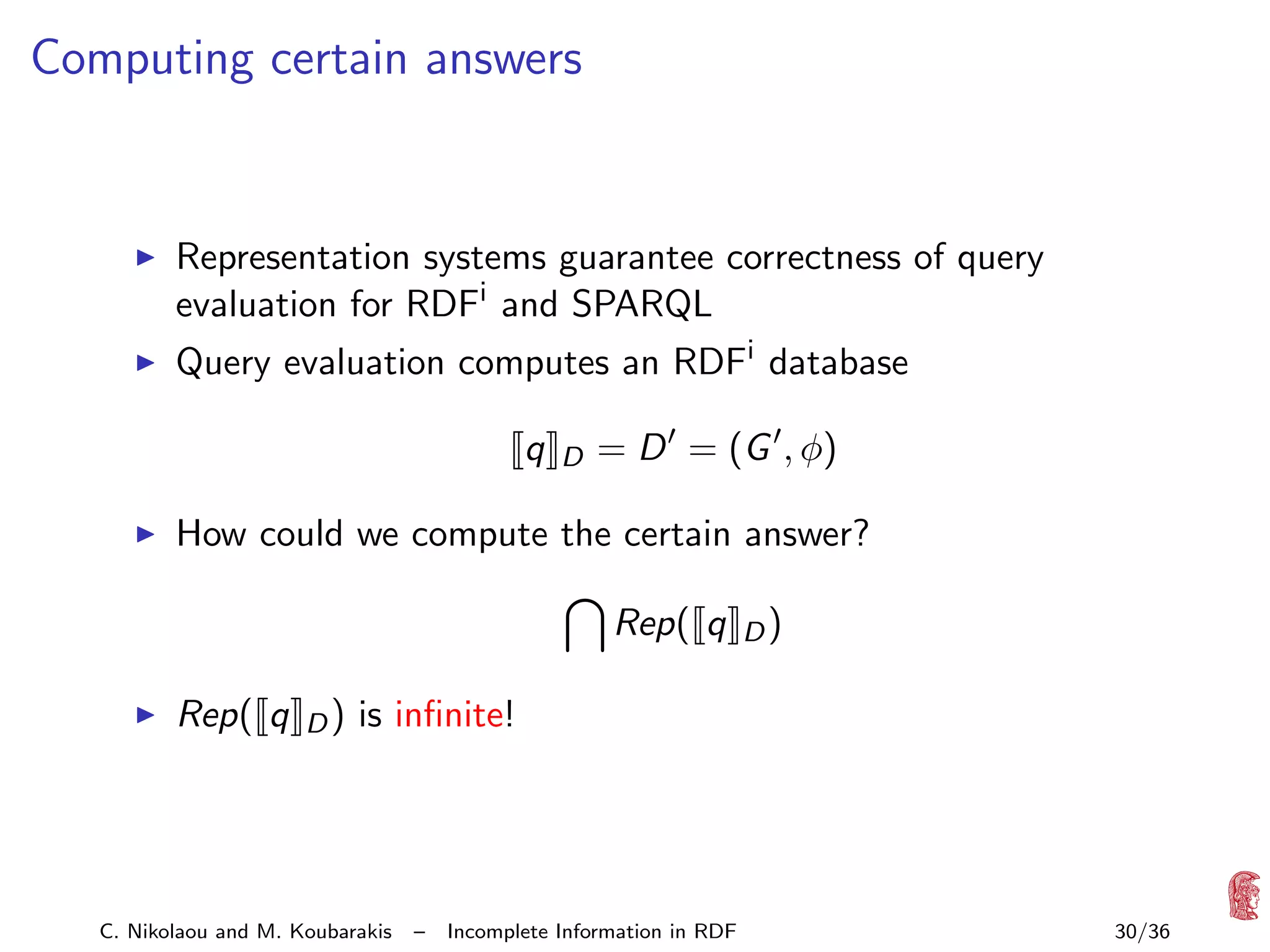
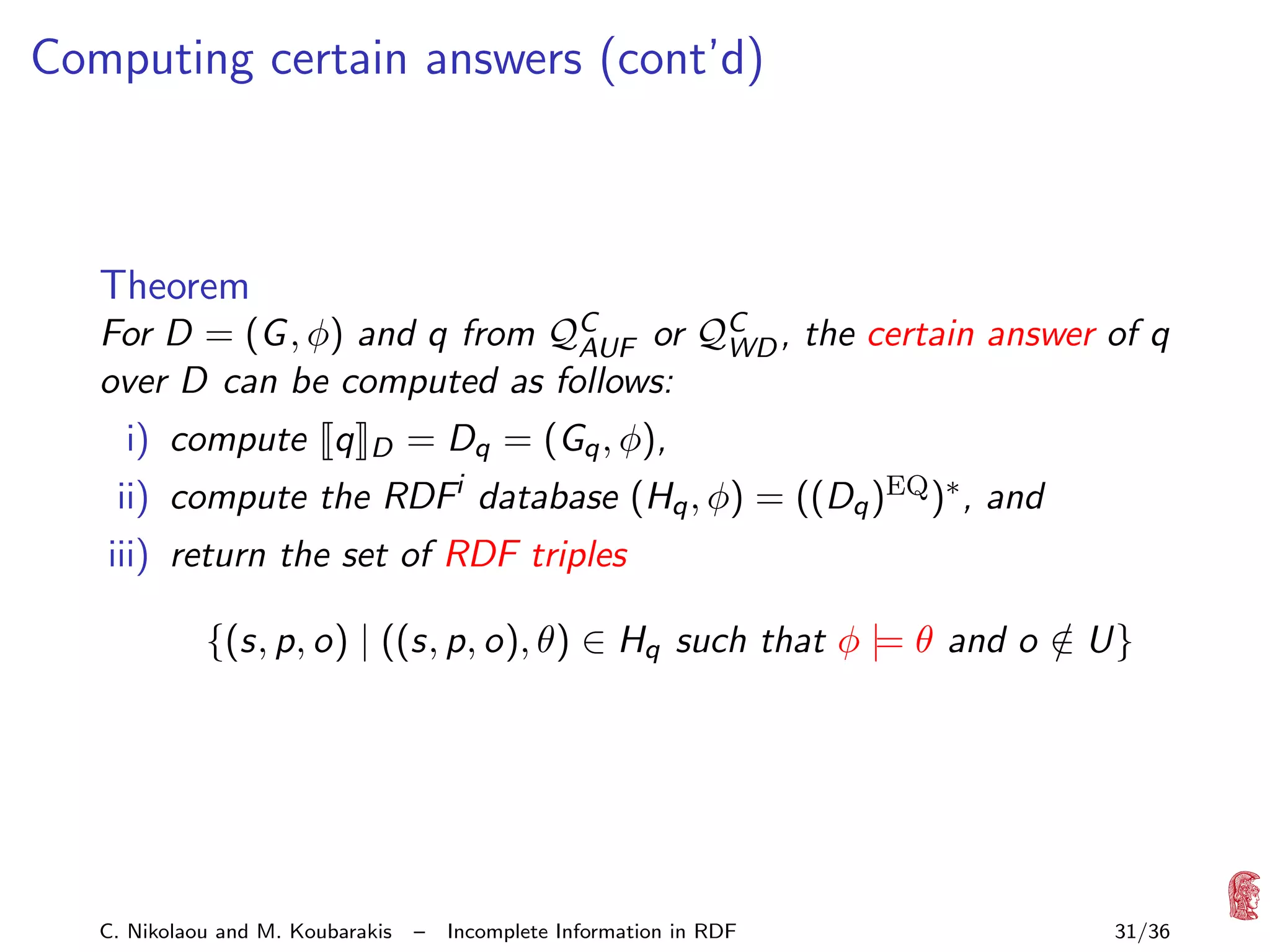
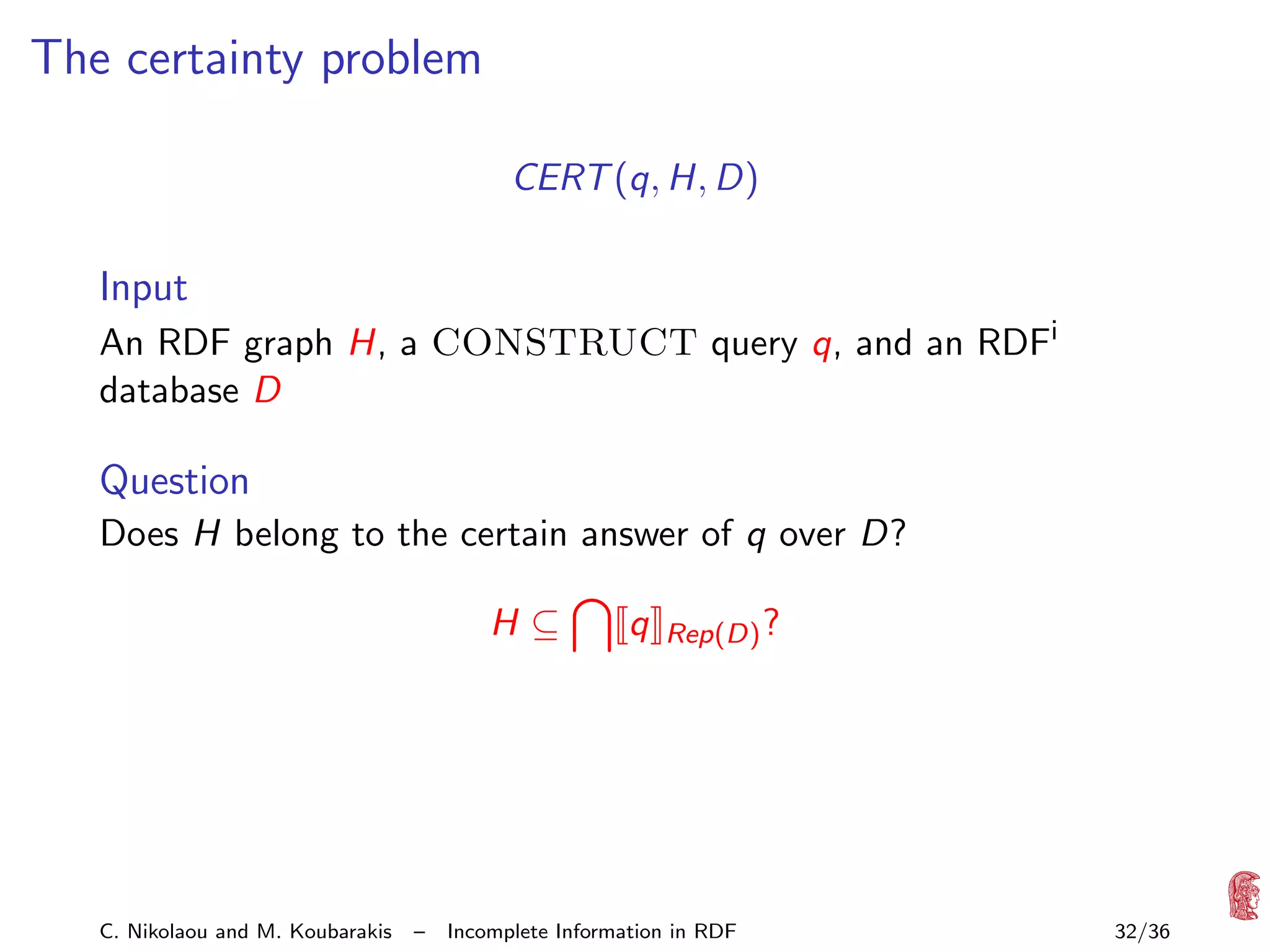
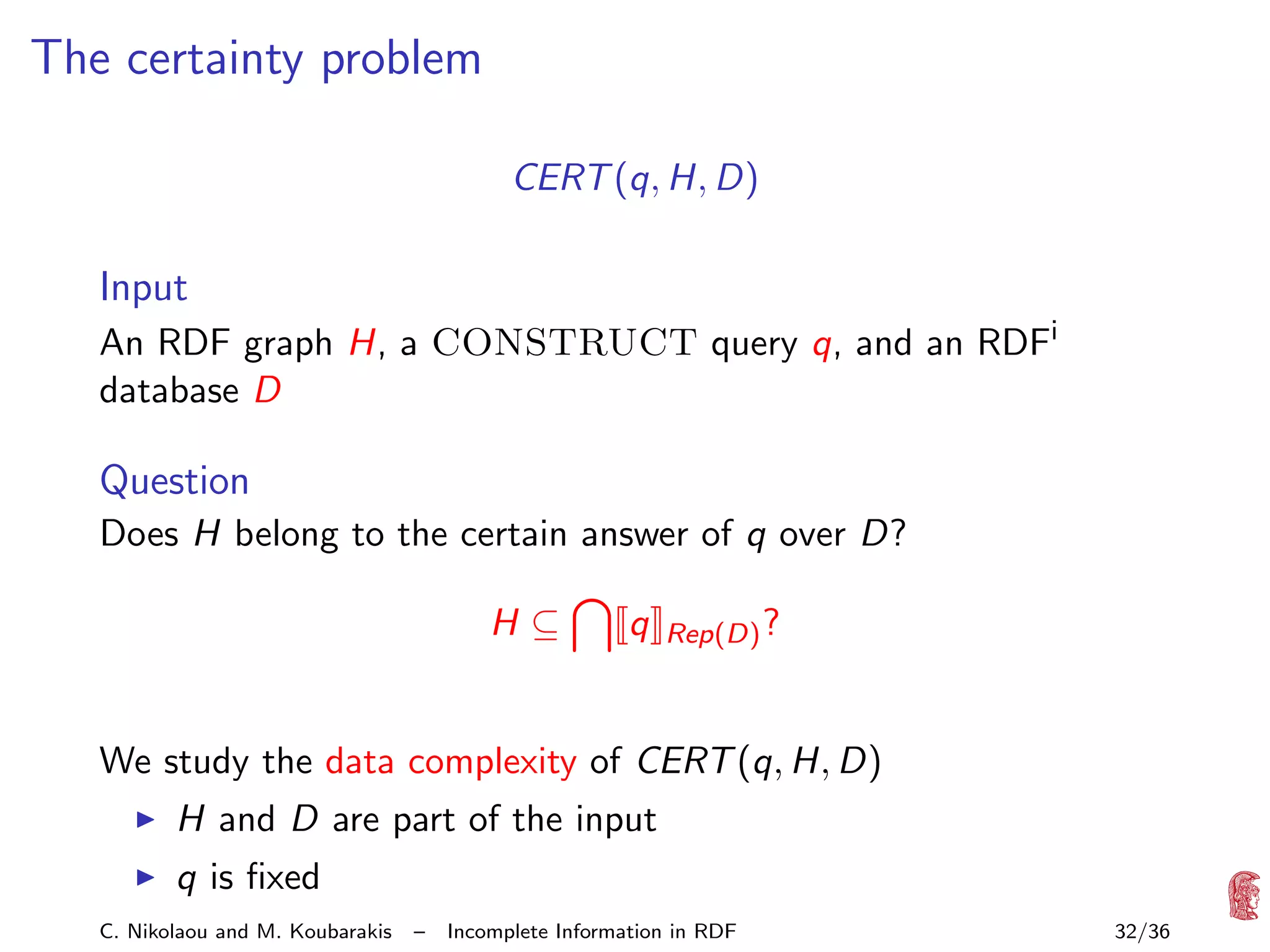
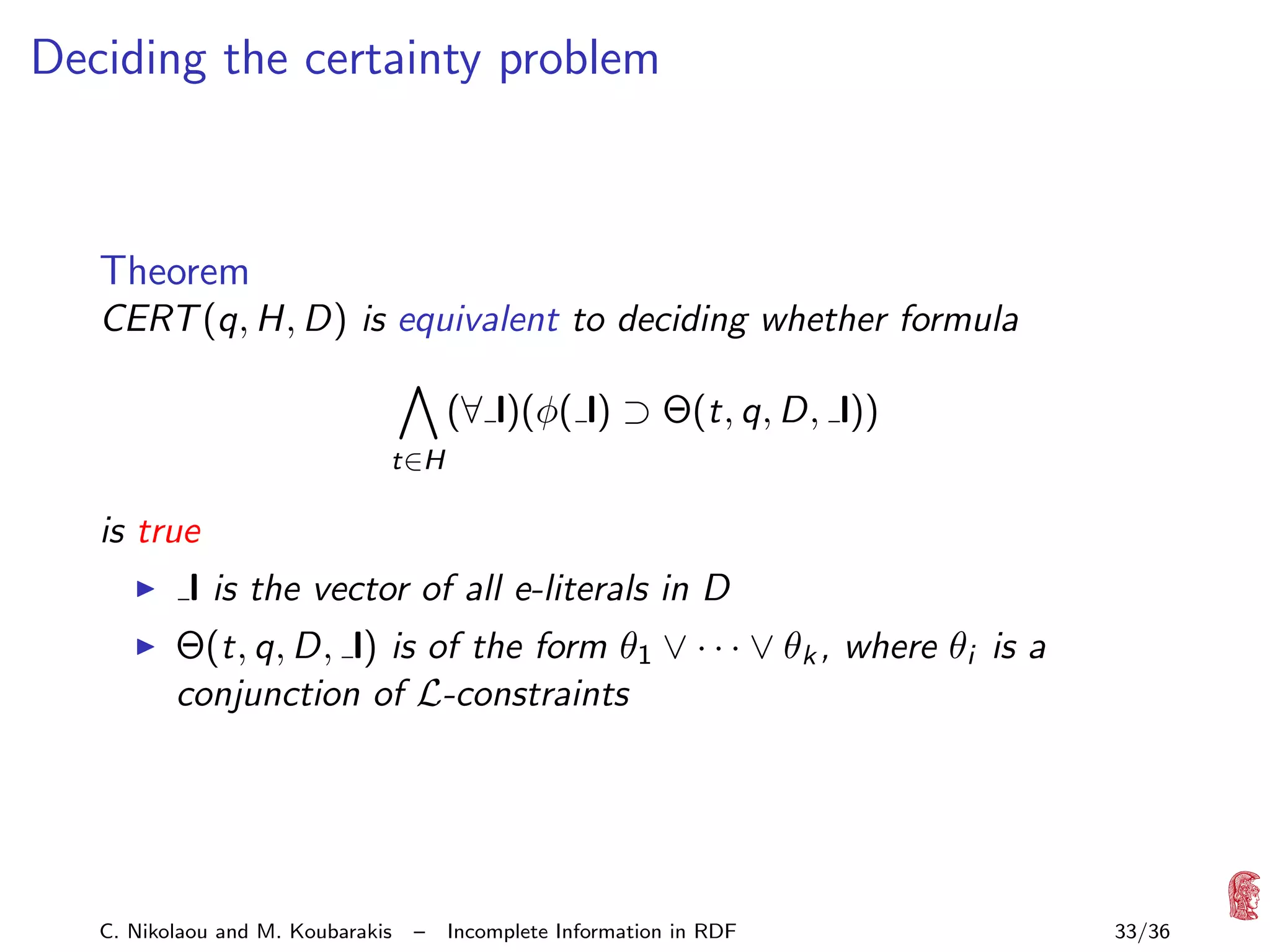


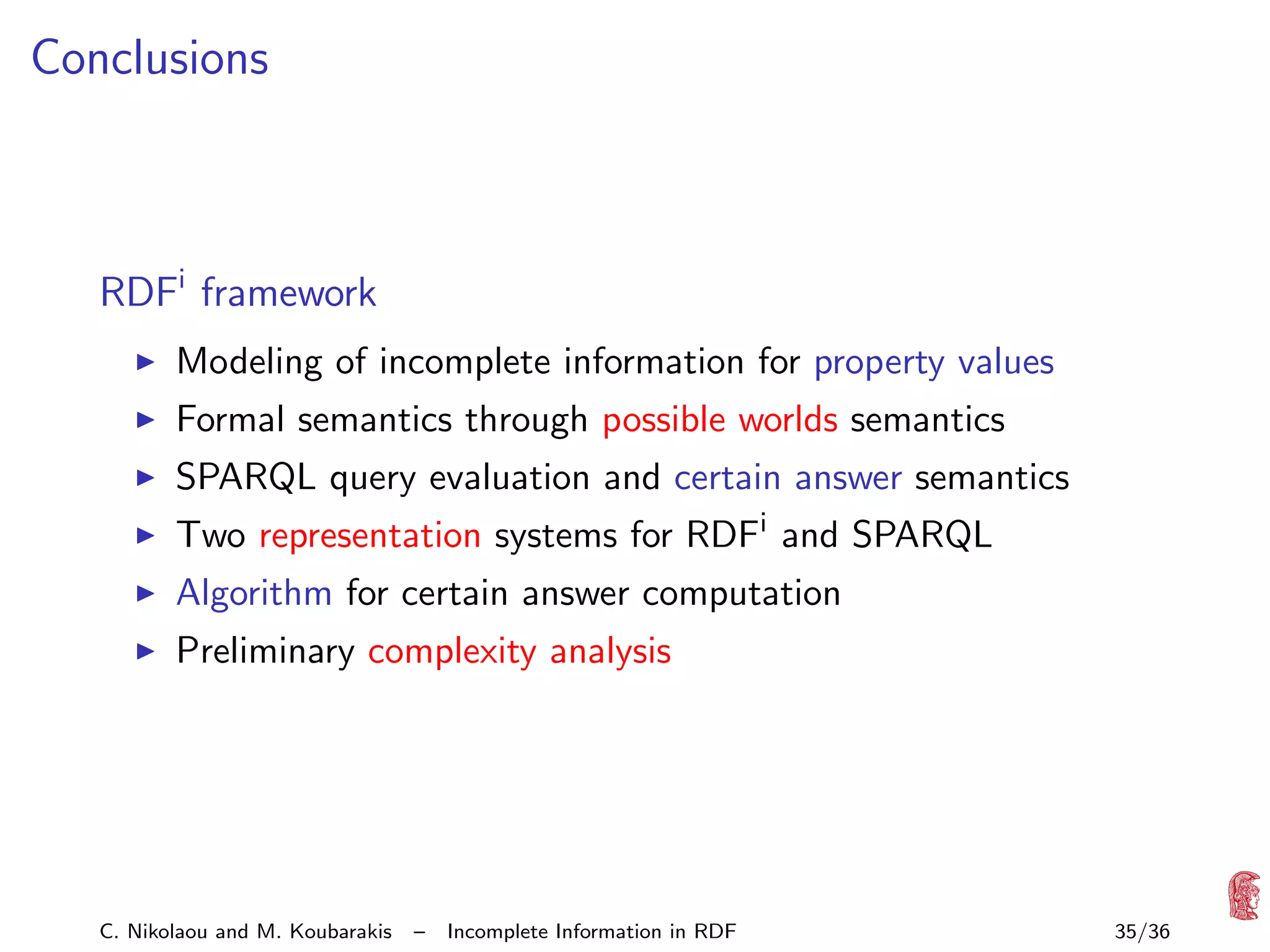
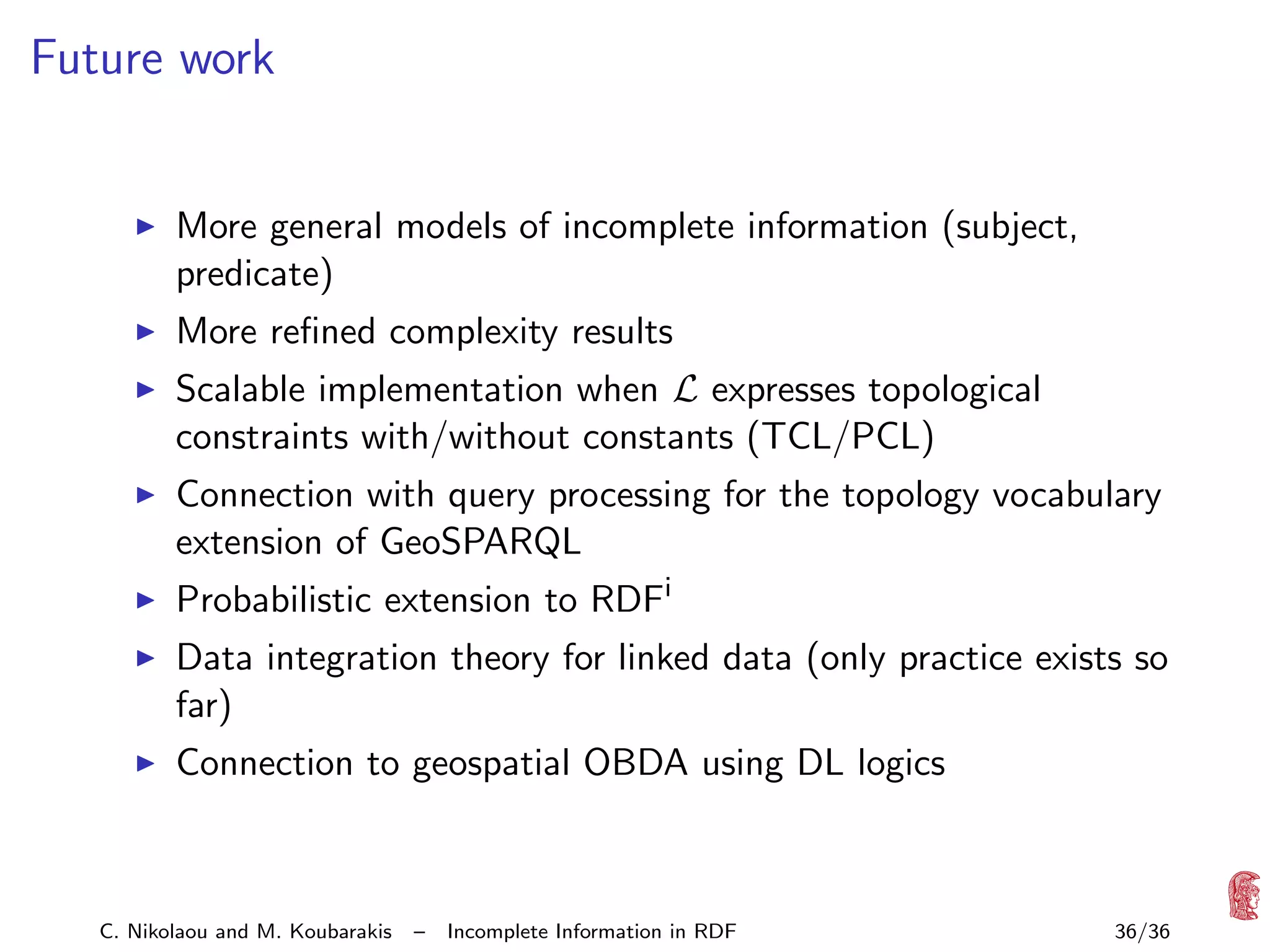

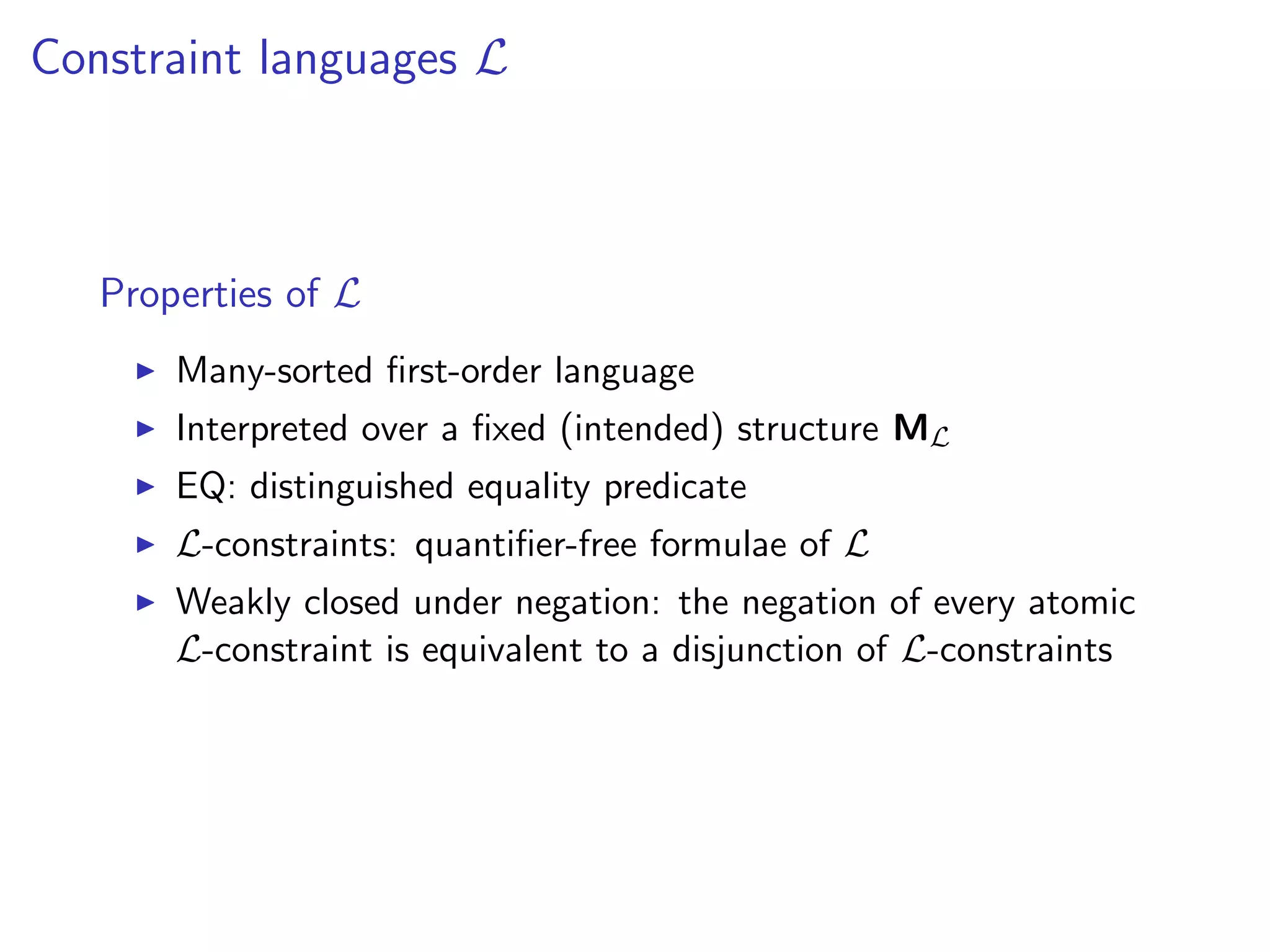
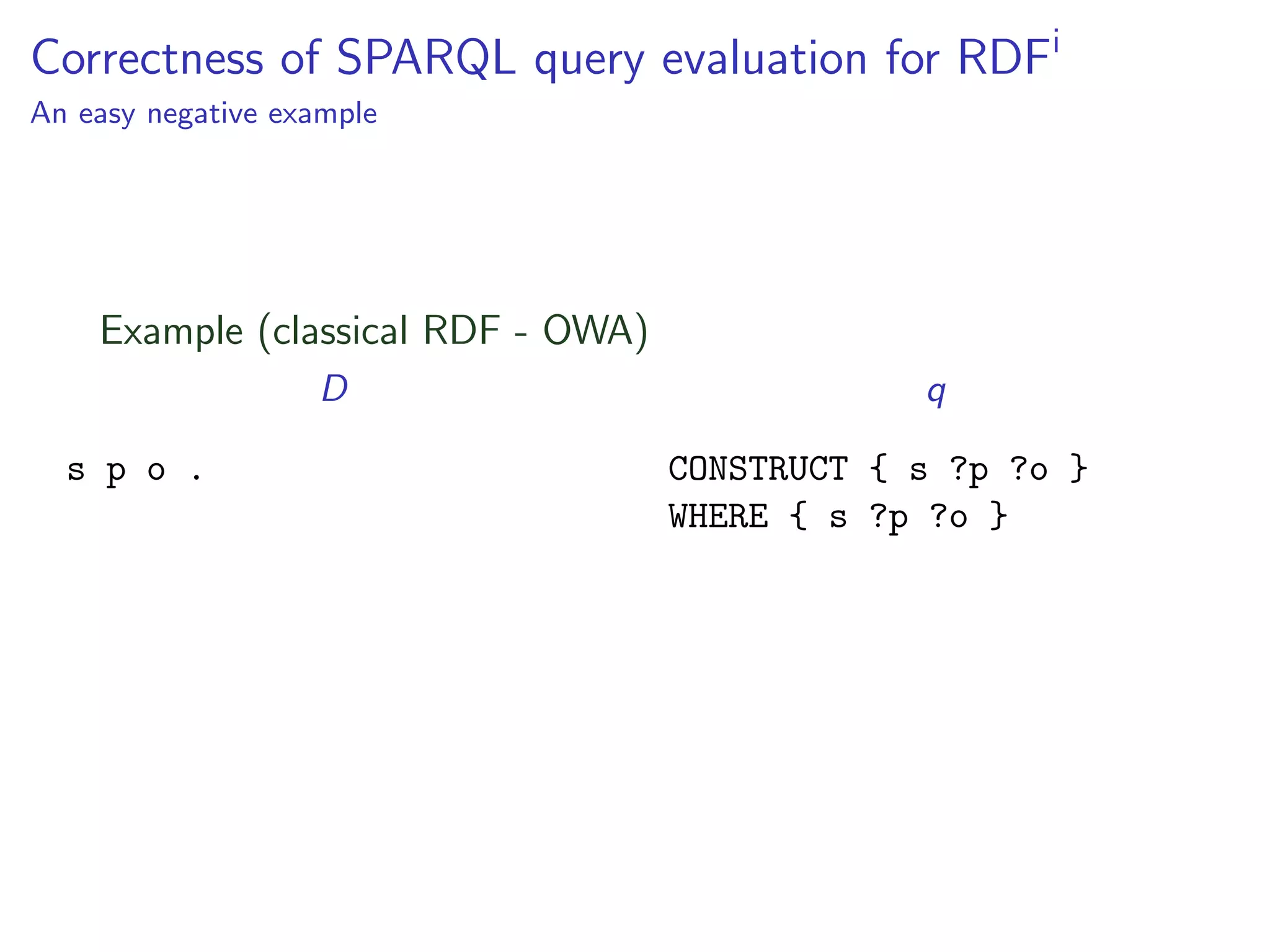
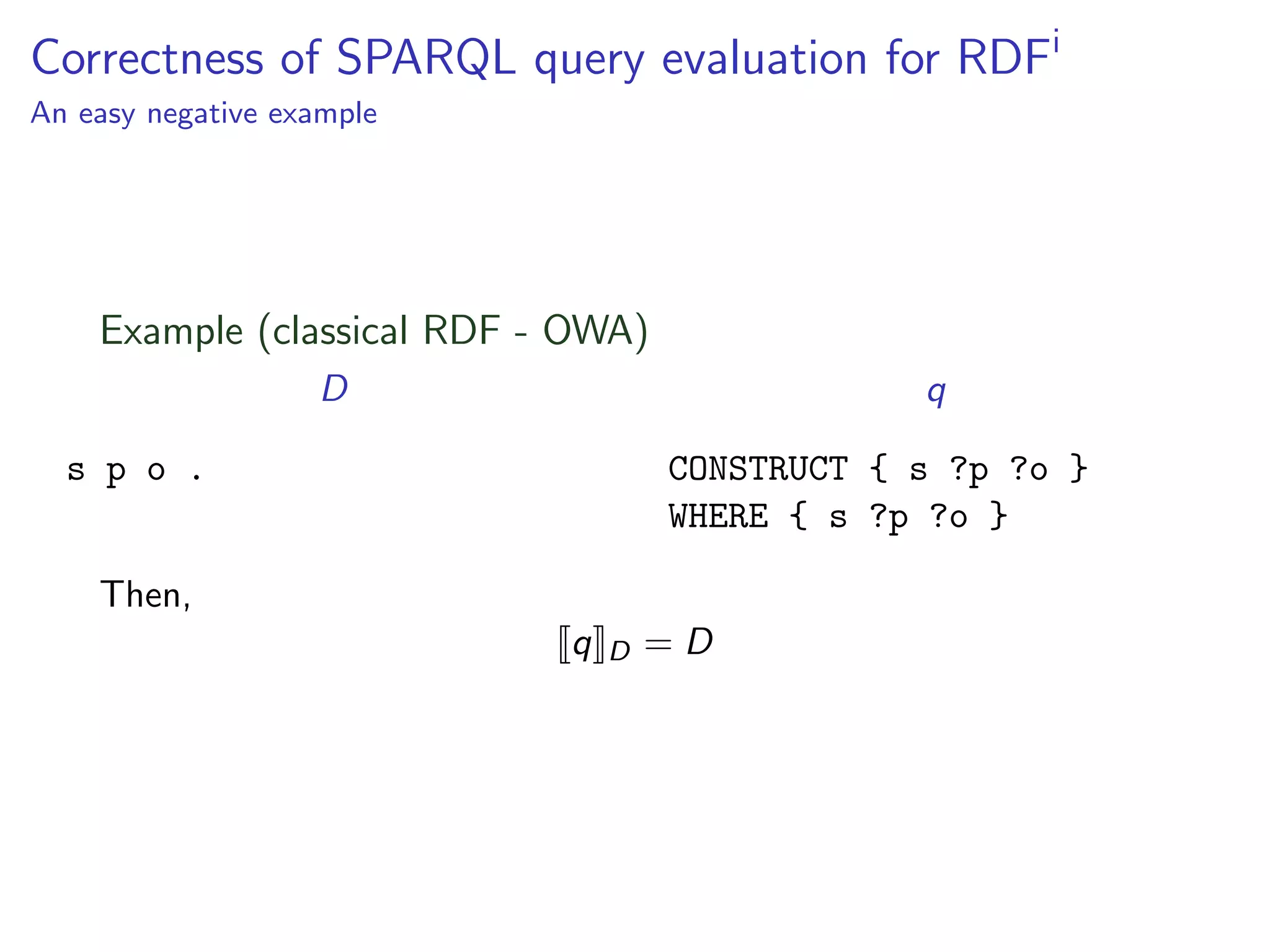

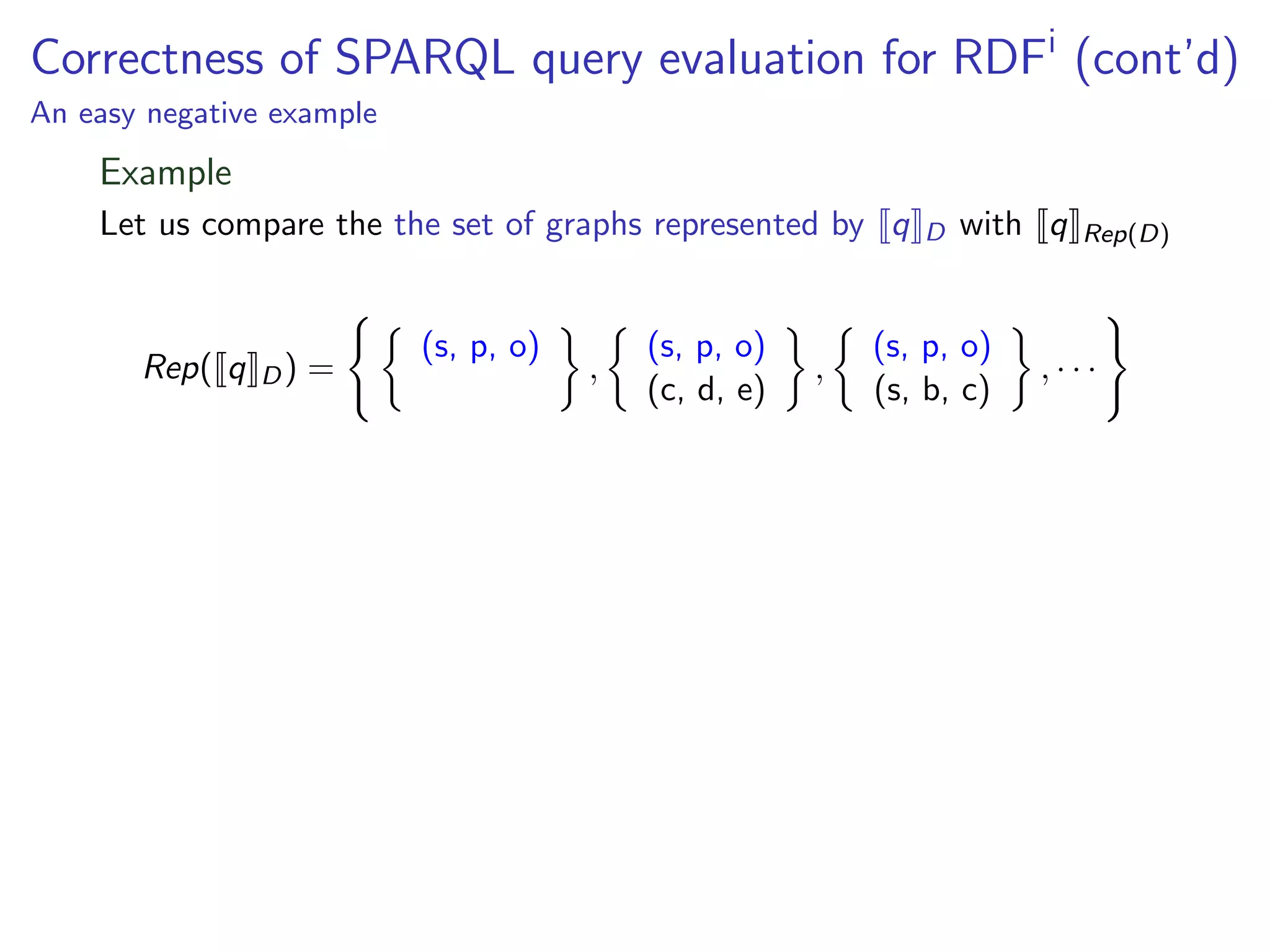

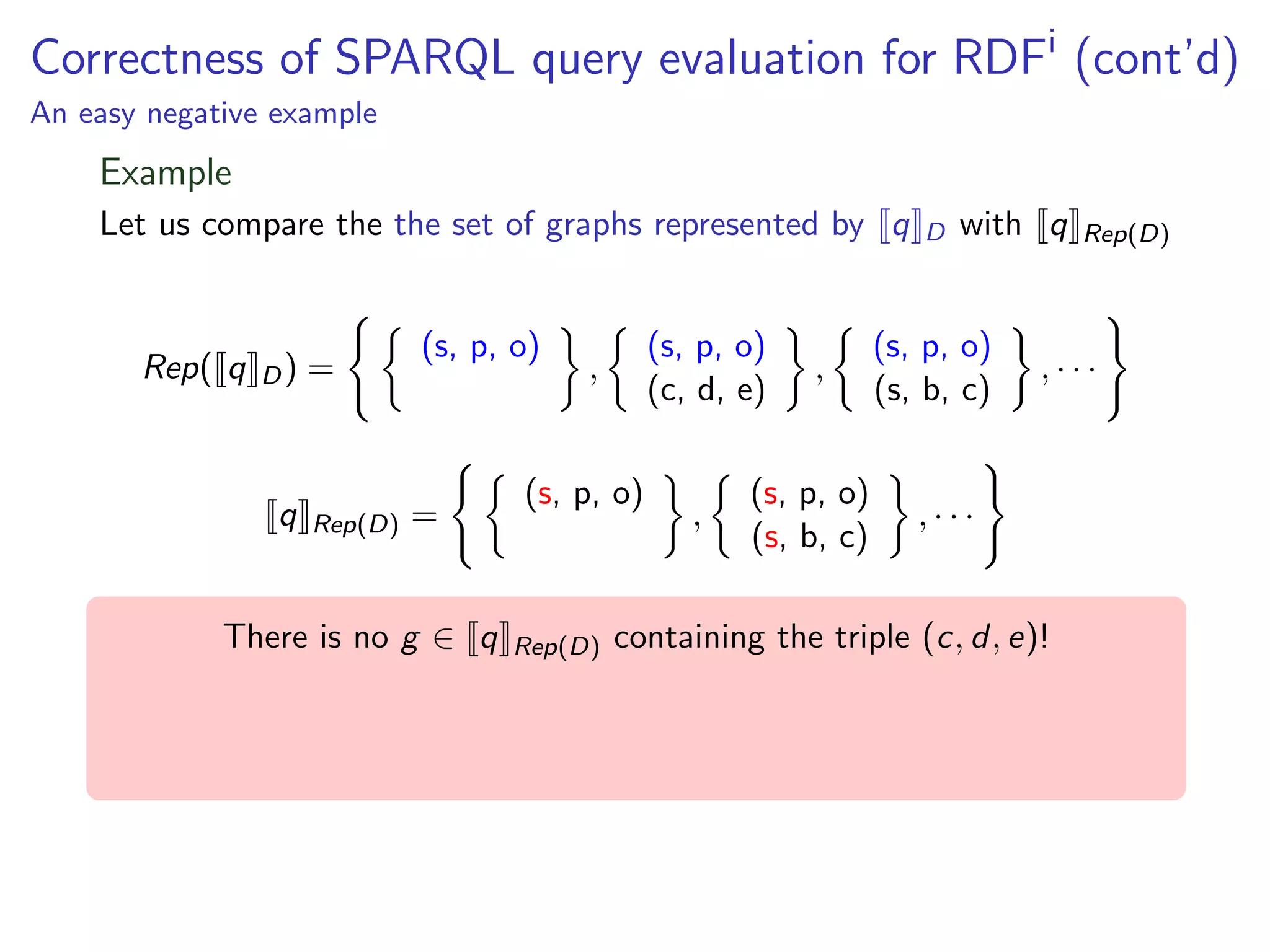

![Correctness of SPARQL query evaluation for RDFi (cont’d)
An easy negative example
Example
Let us compare the the set of graphs represented by q
Rep( q
D)
q
=
Rep(D)
(s, p, o)
=
There is no g ∈ q
(s, p, o)
(c, d, e)
,
(s, p, o)
Rep(D)
,
,
(s, p, o)
(s, b, c)
D
with q
(s, p, o)
(s, b, c)
Rep(D)
,···
,···
containing the triple (c, d, e)!
This would work if RDF made the CWA
We know this already from the relational case [Imielinski/Lipski ’84]](https://image.slidesharecdn.com/rr2013-presentation-131020155616-phpapp01/75/Incomplete-Information-in-RDF-85-2048.jpg)
